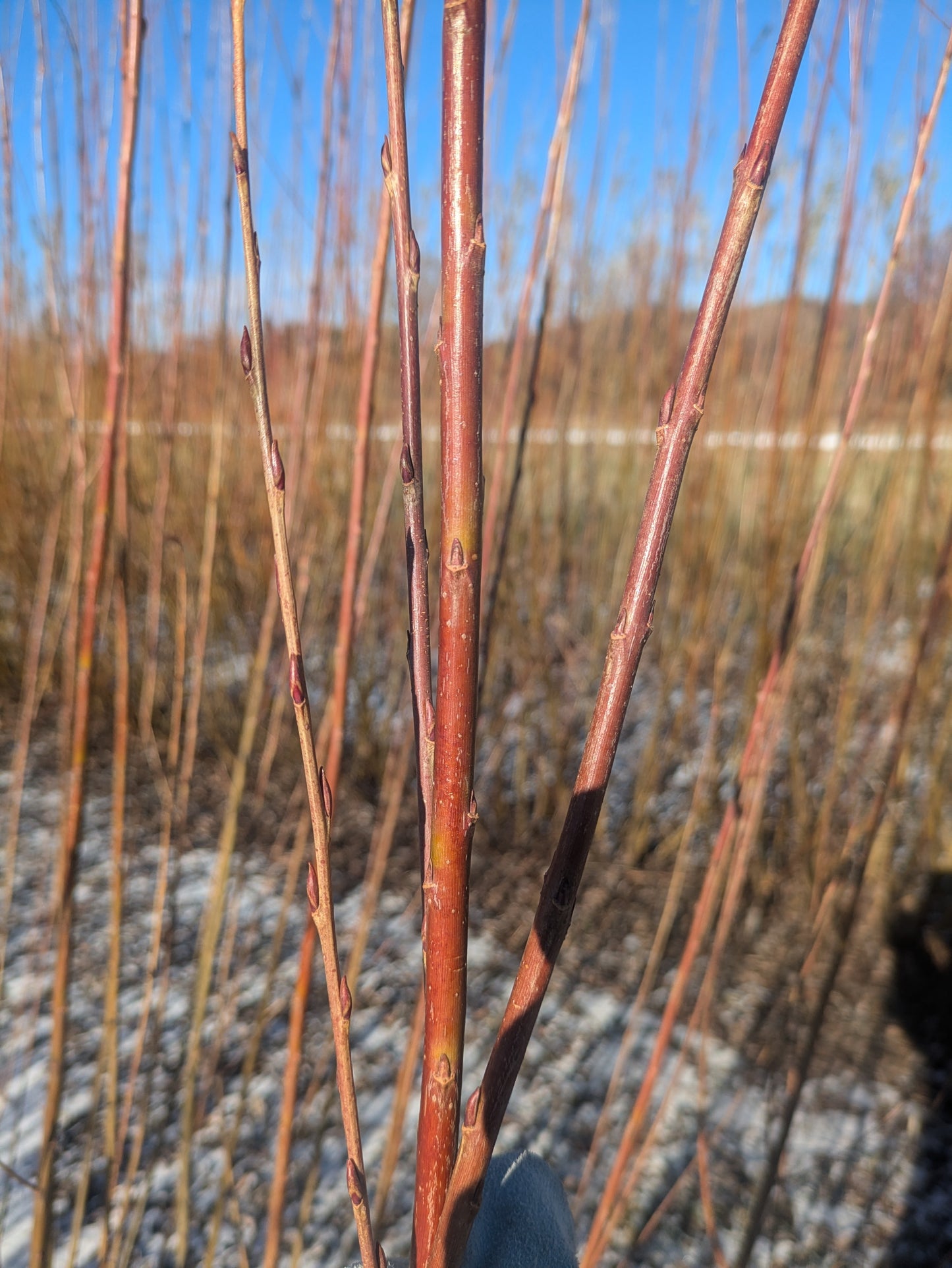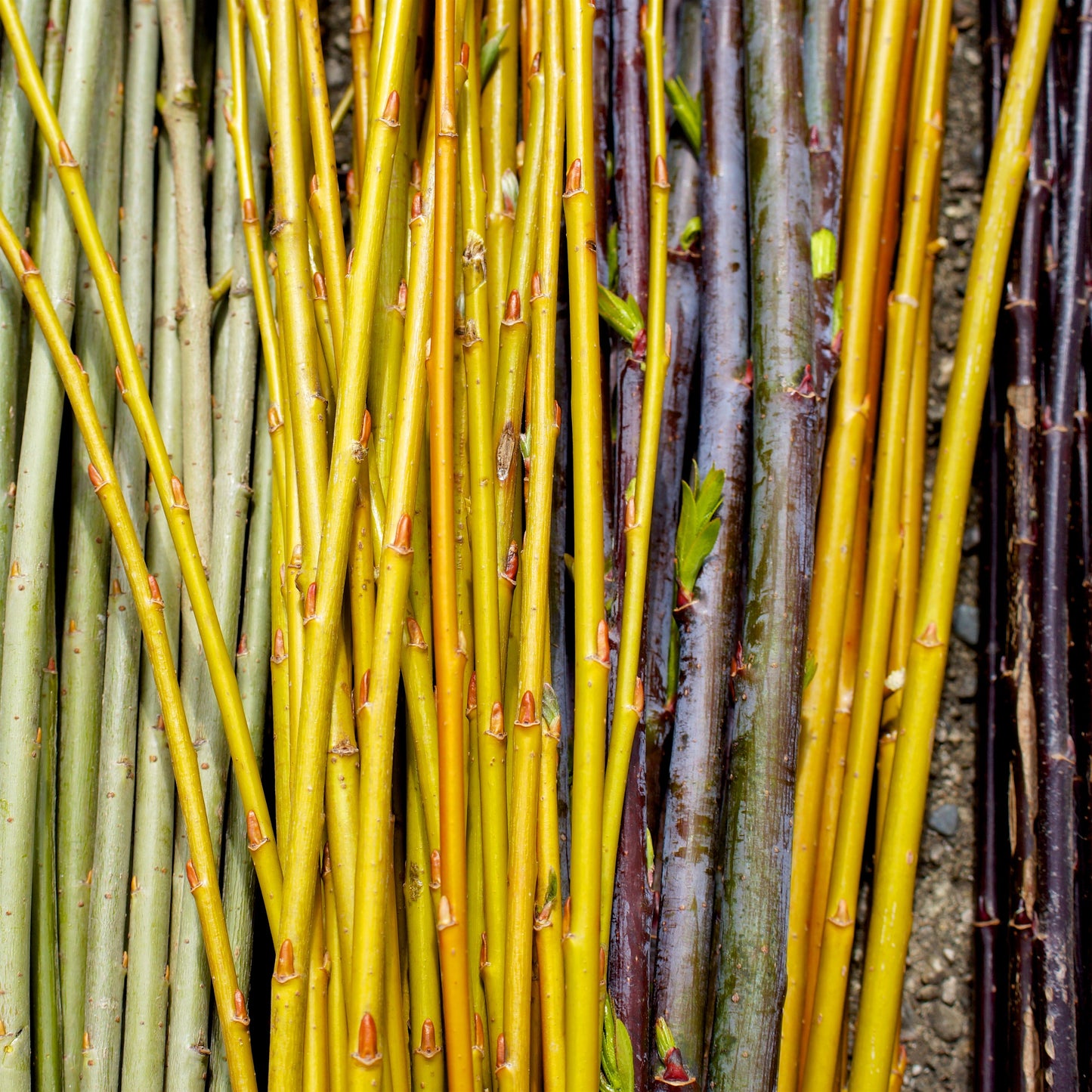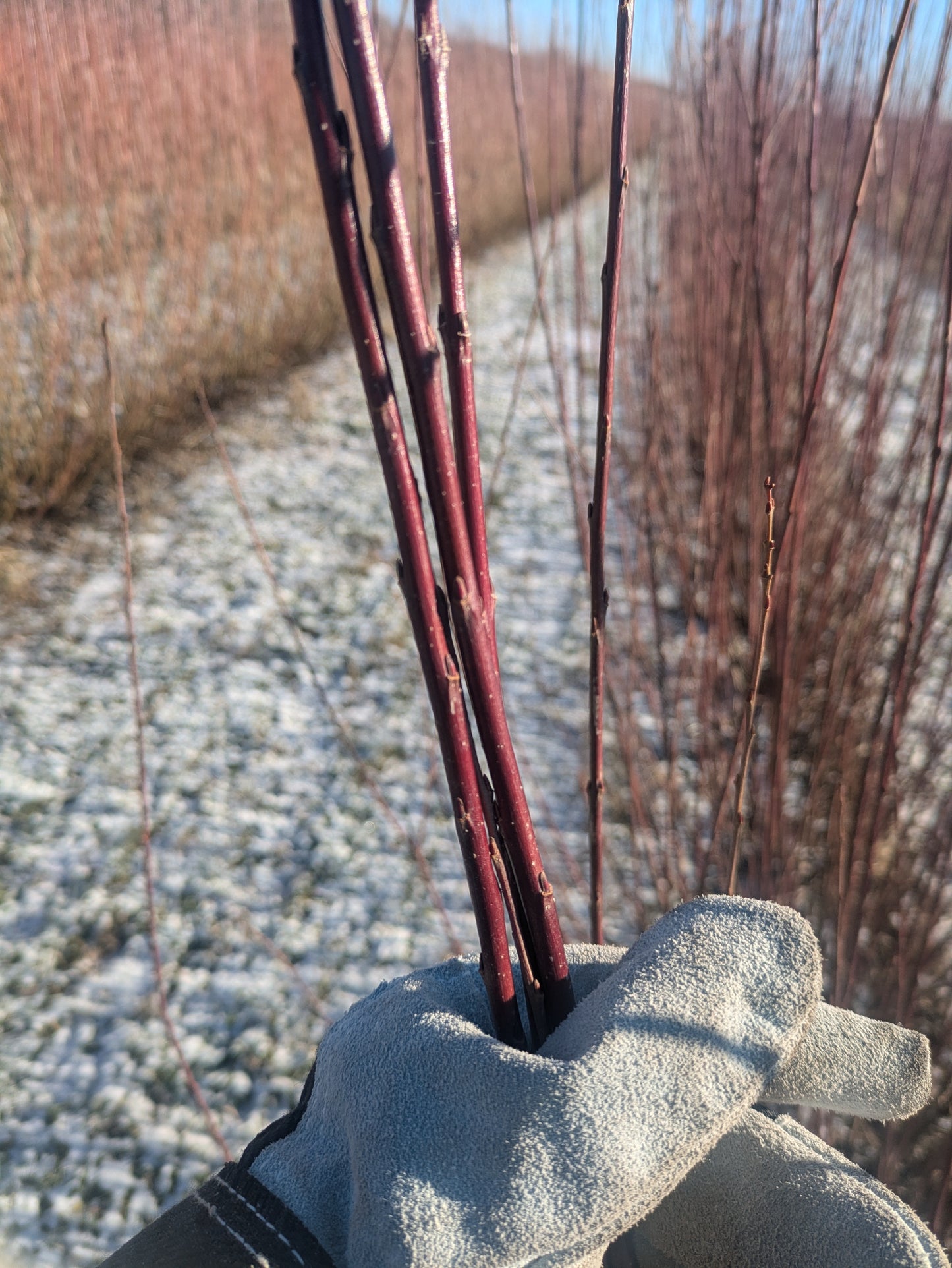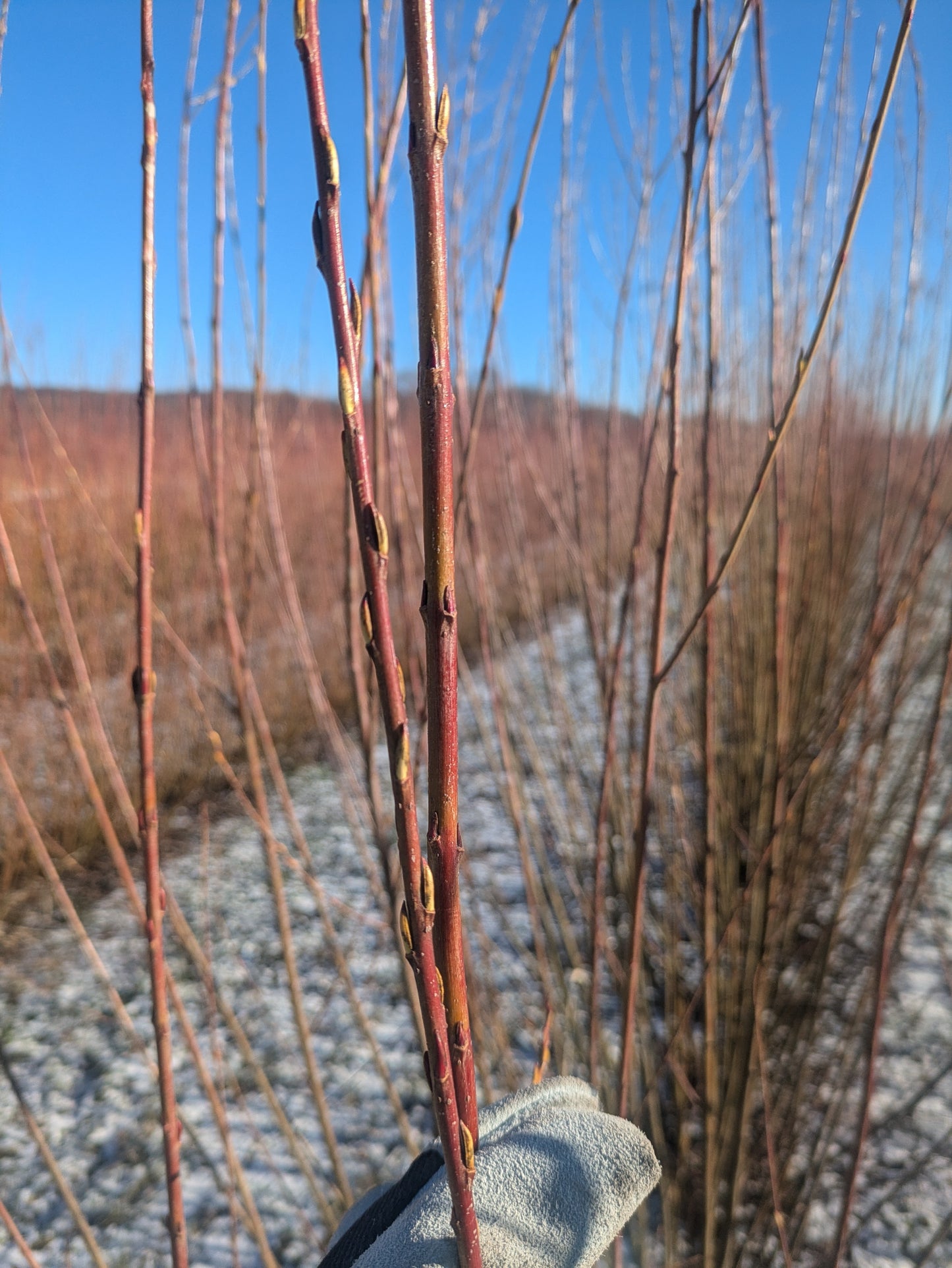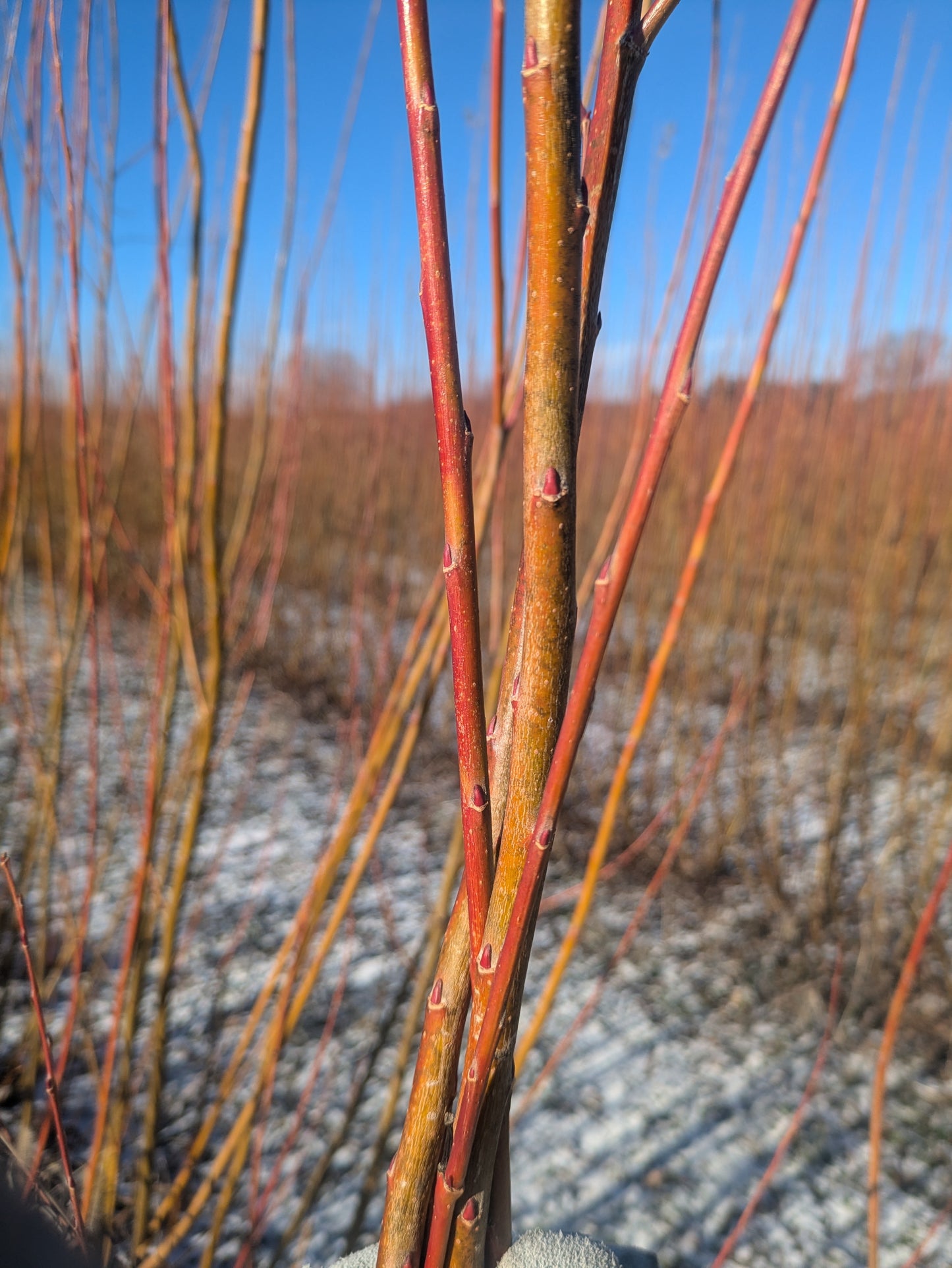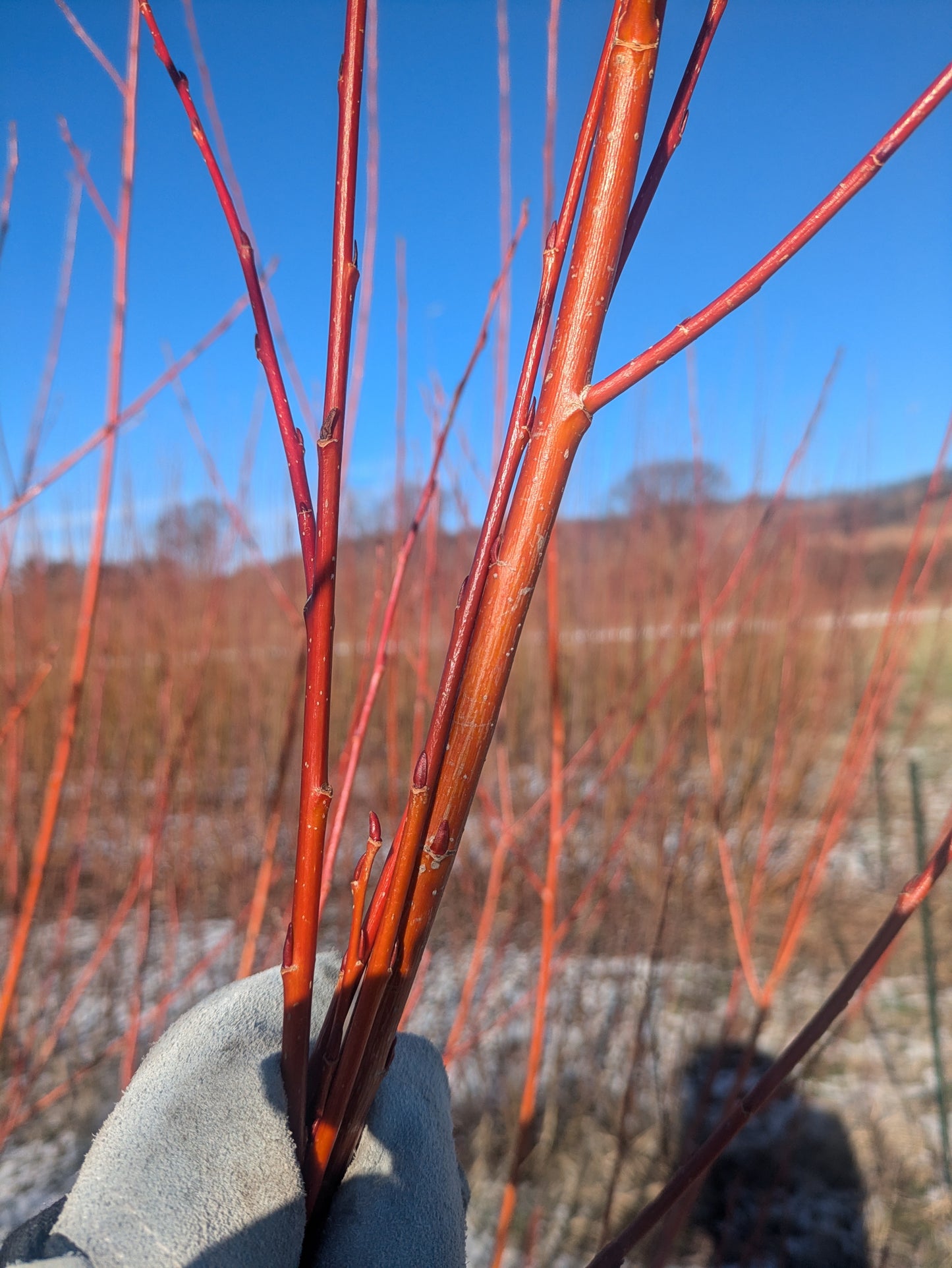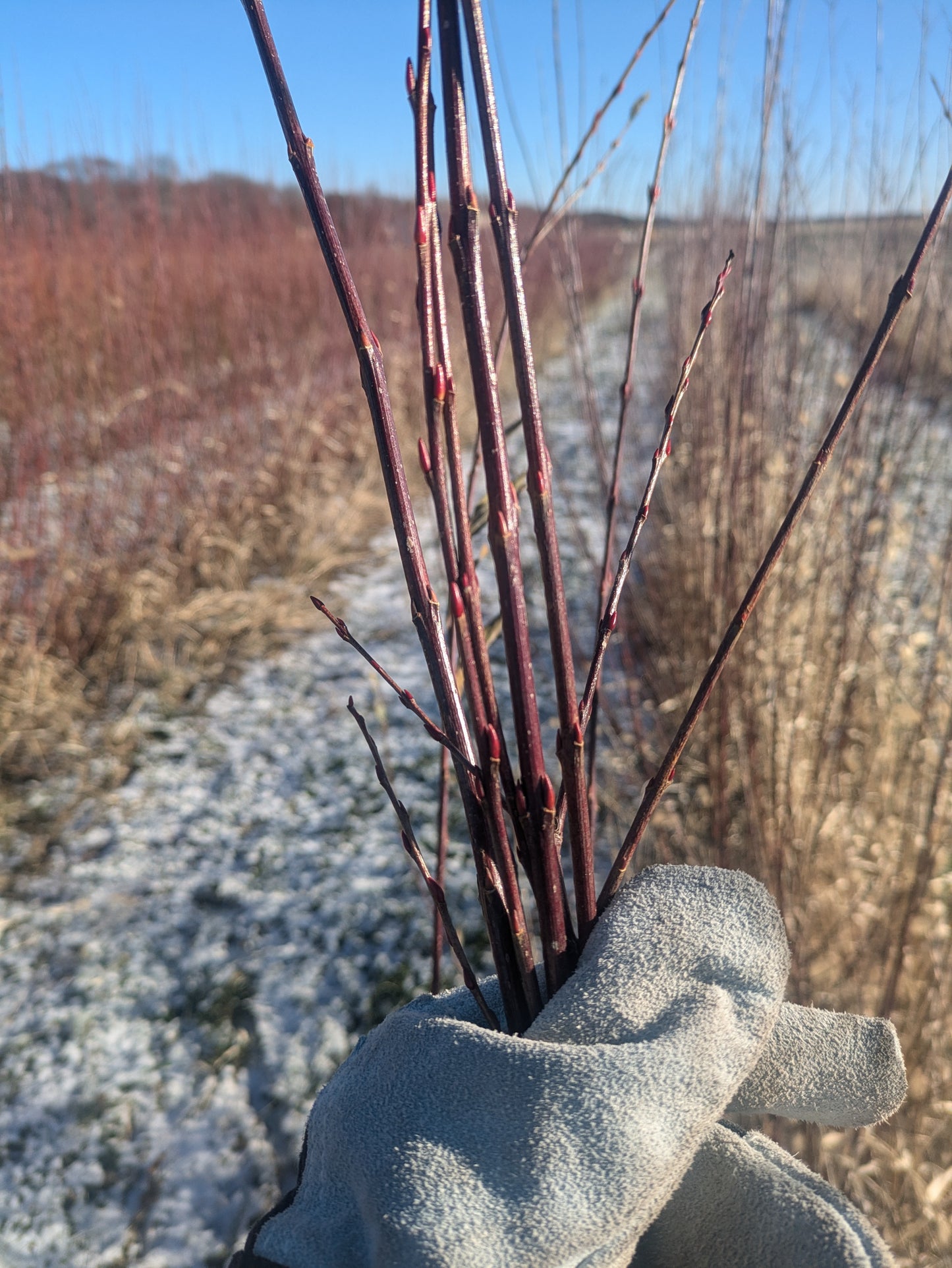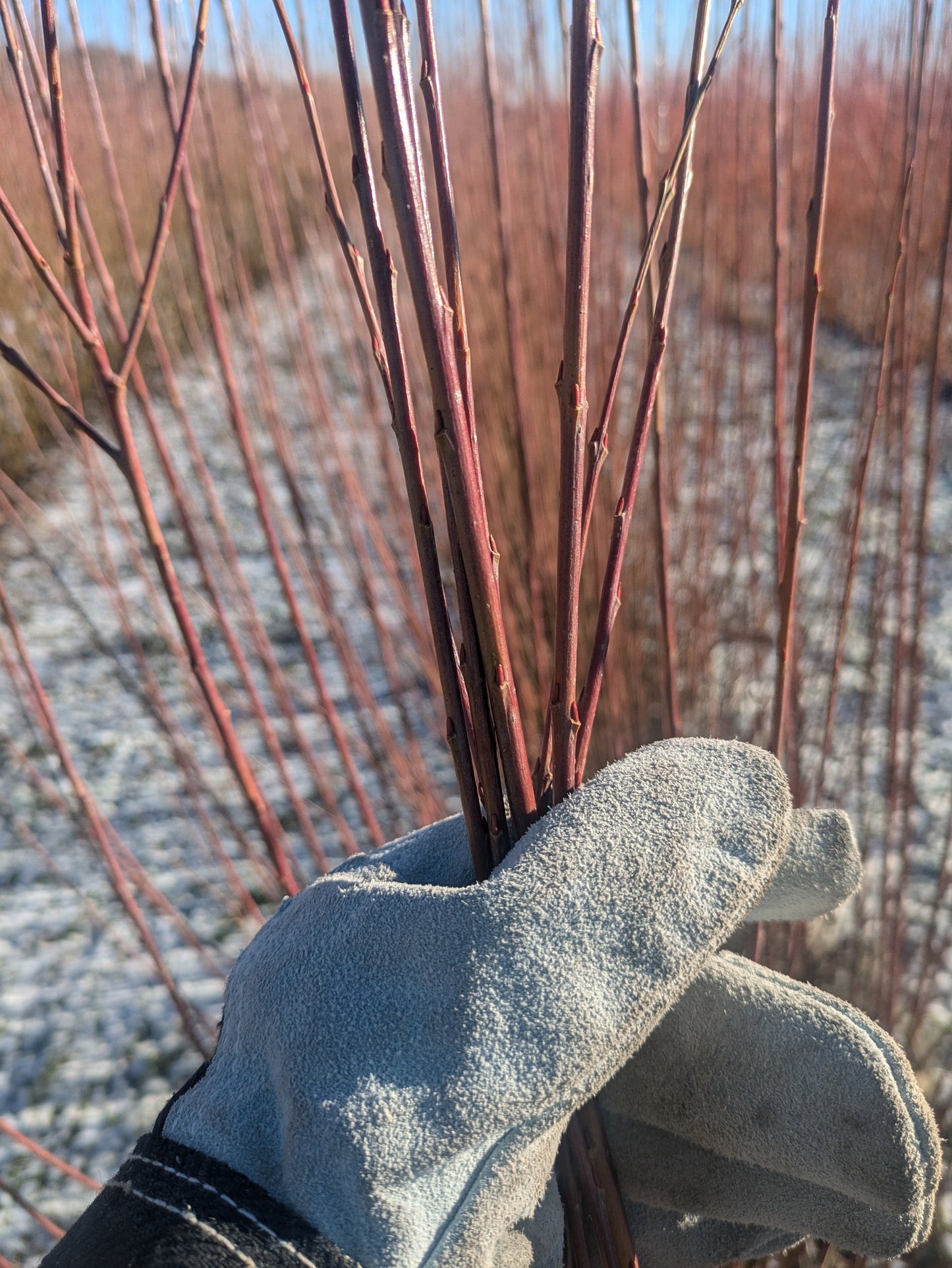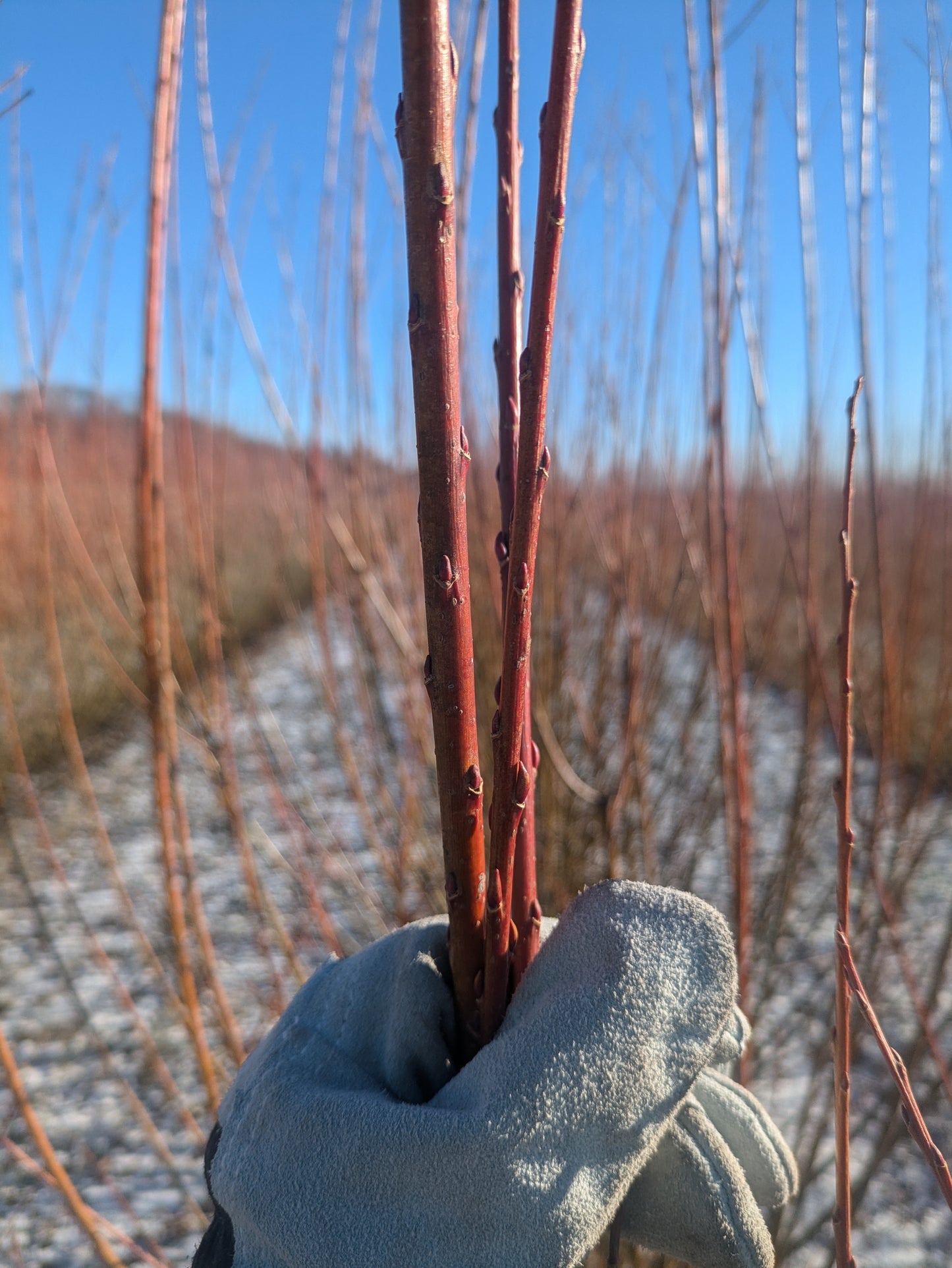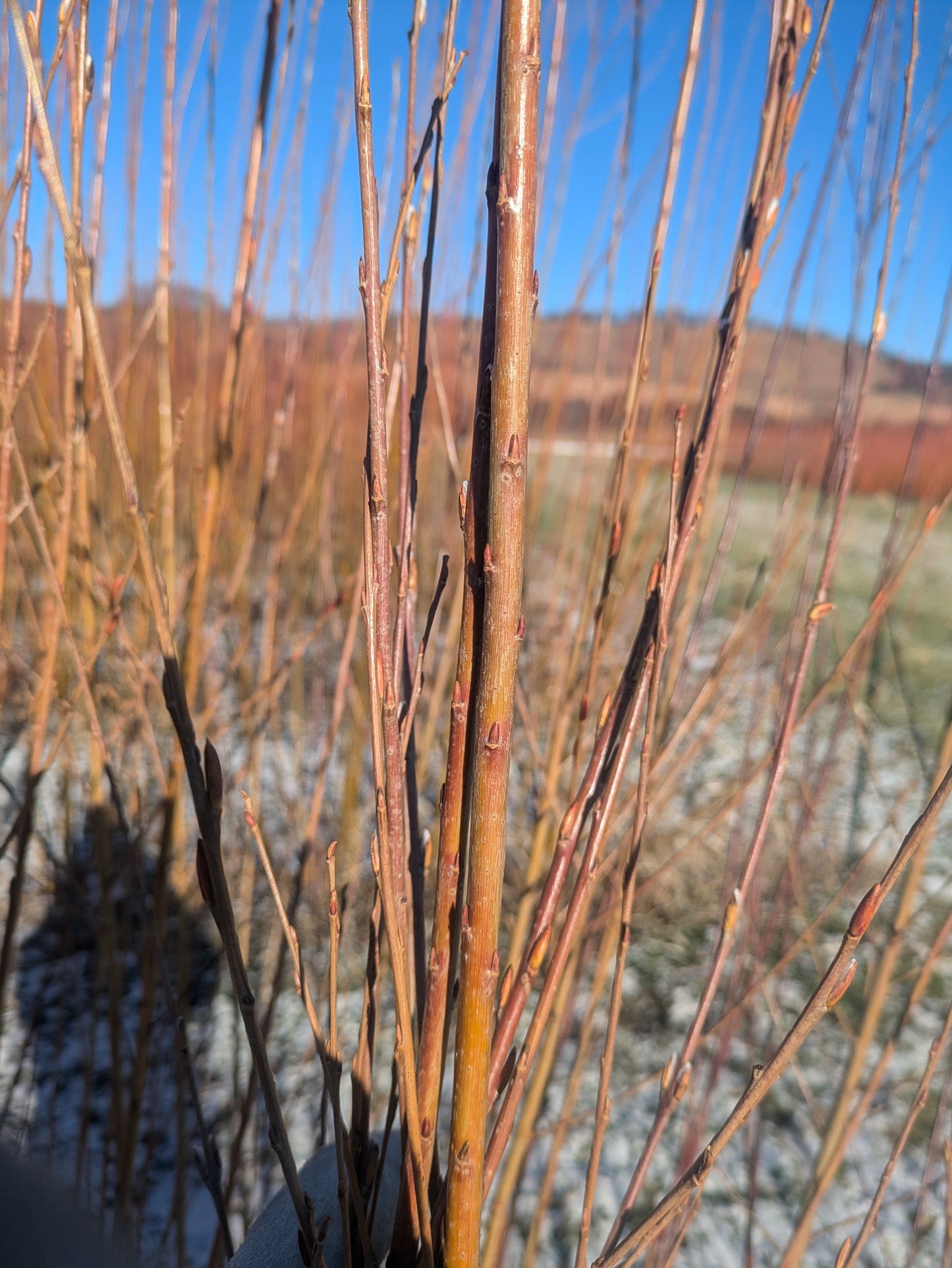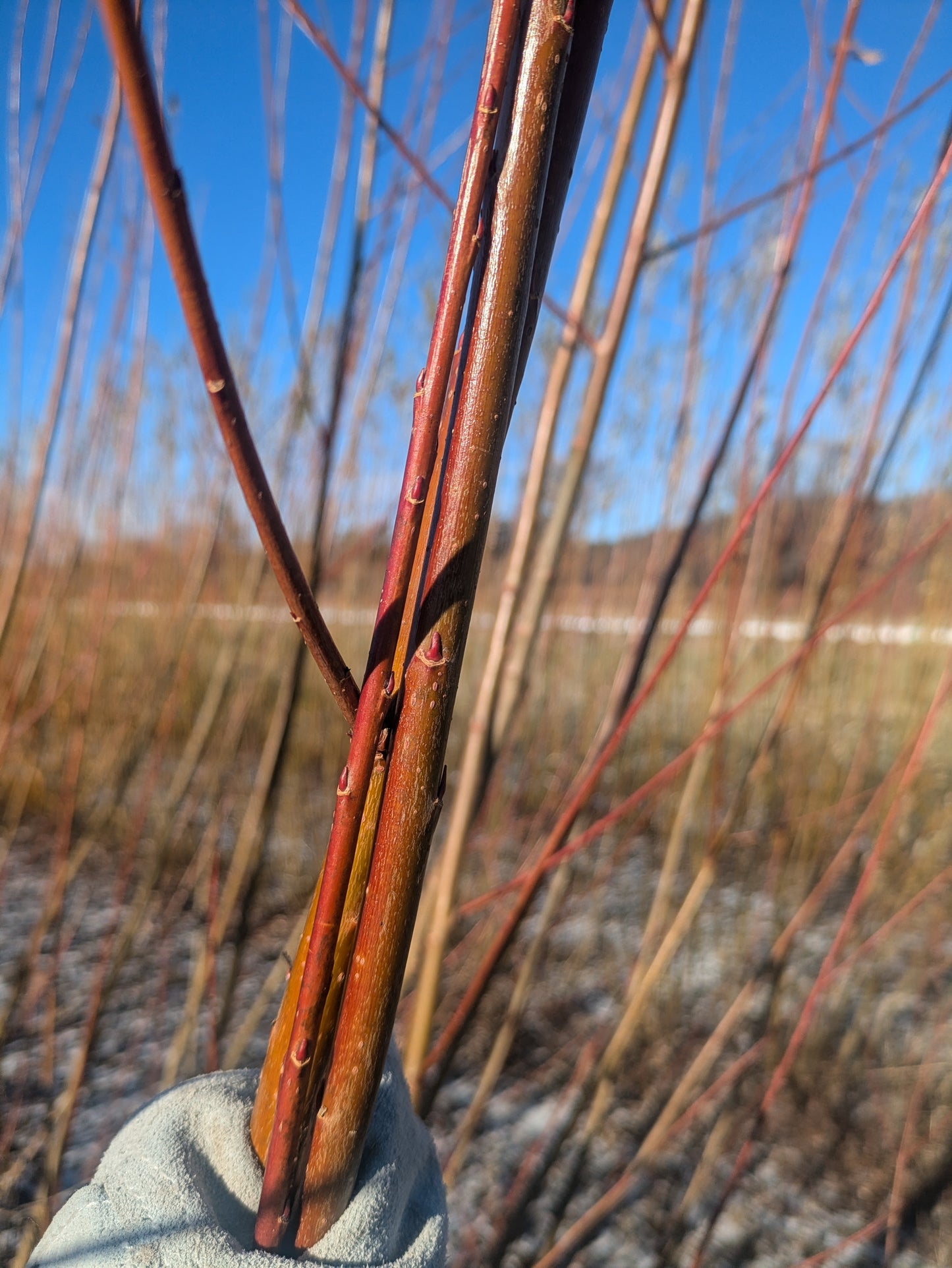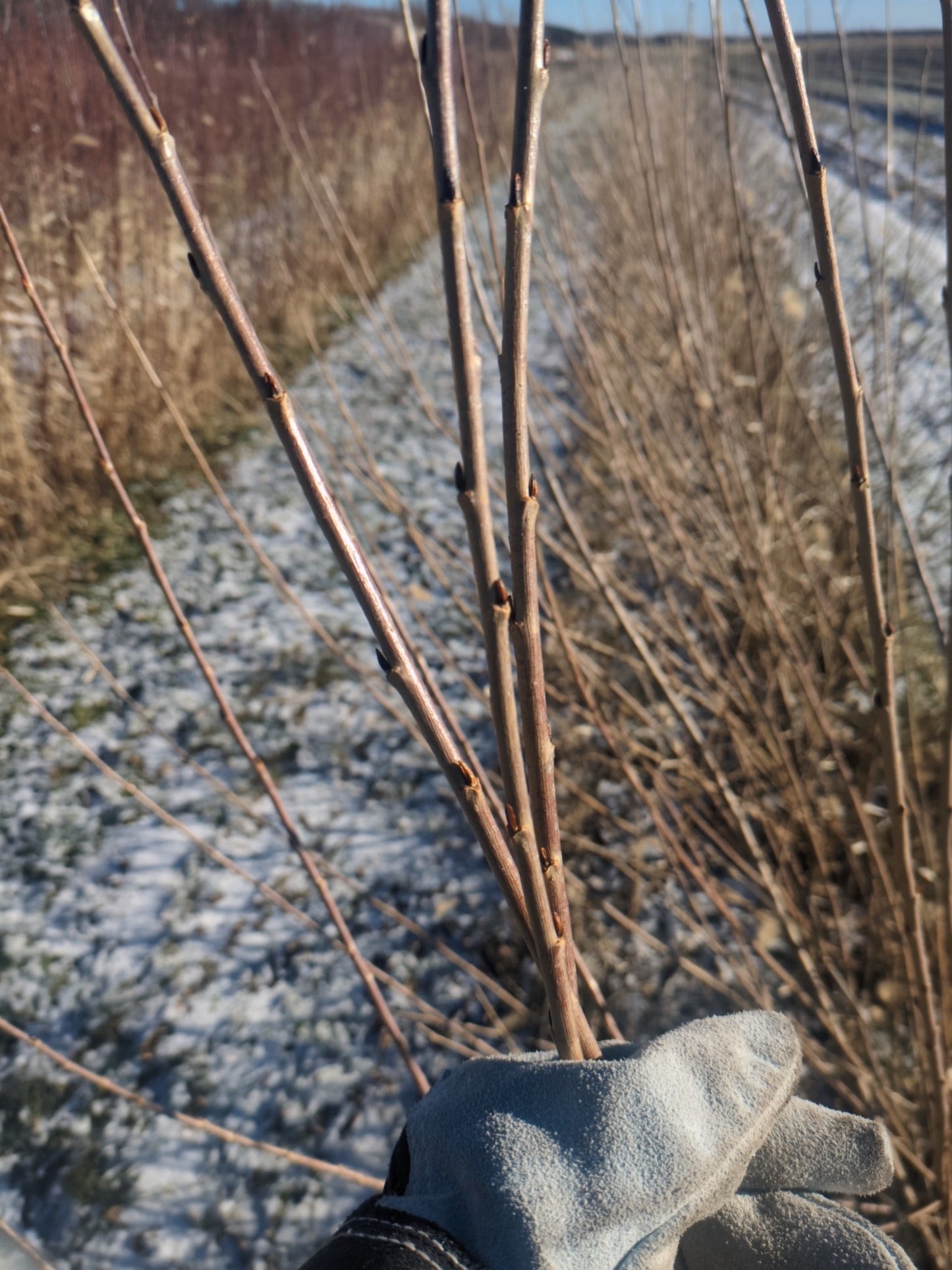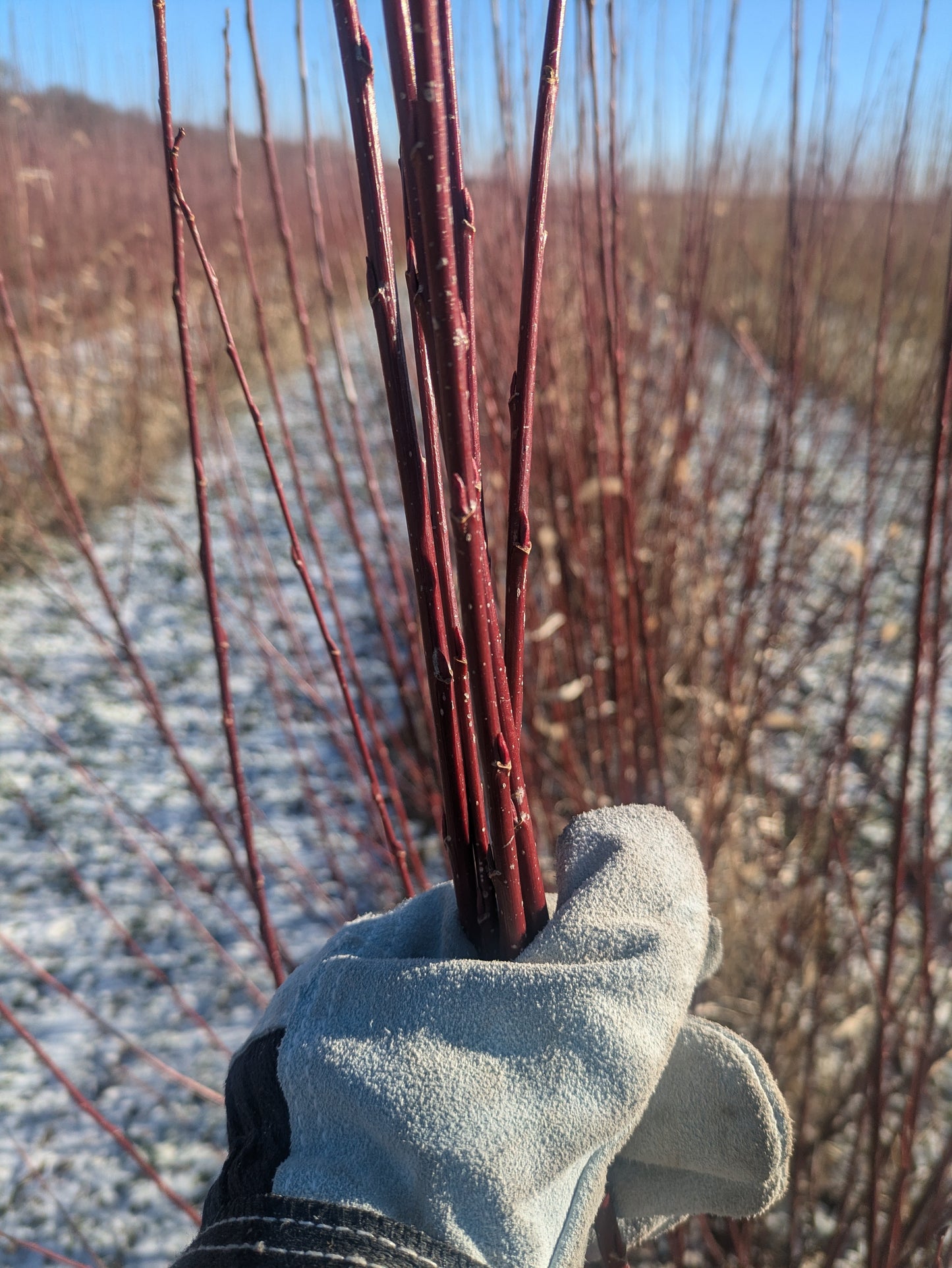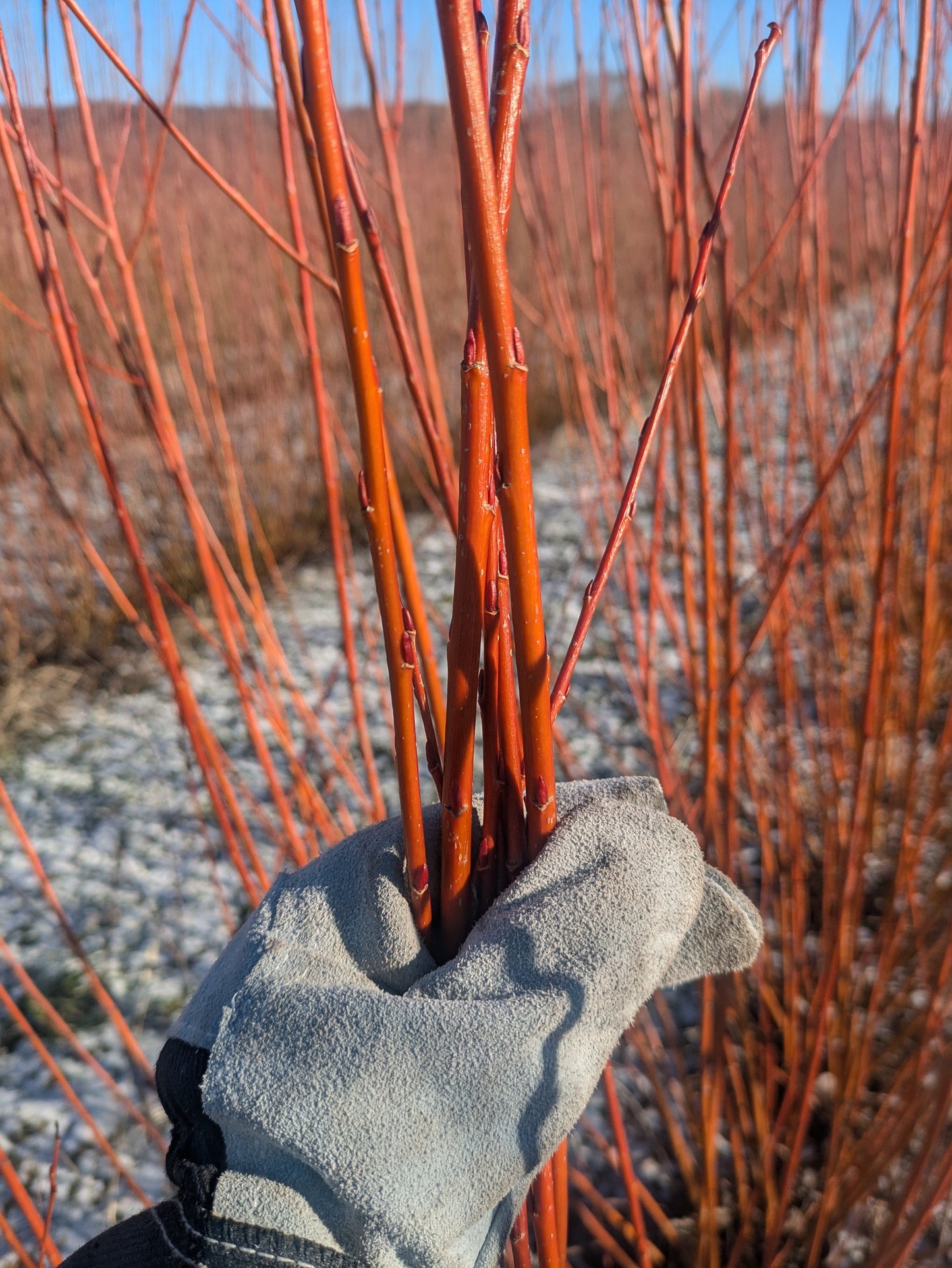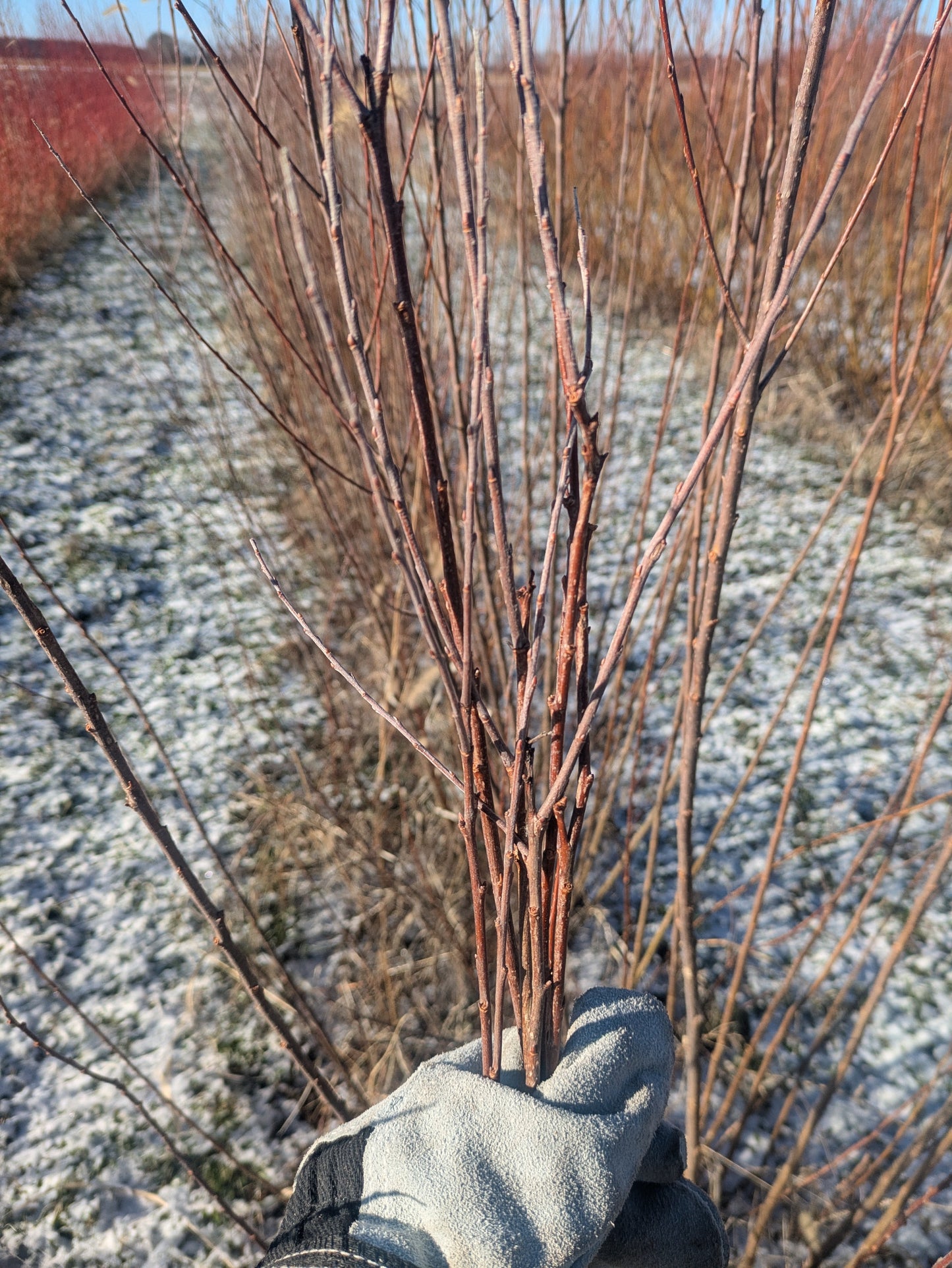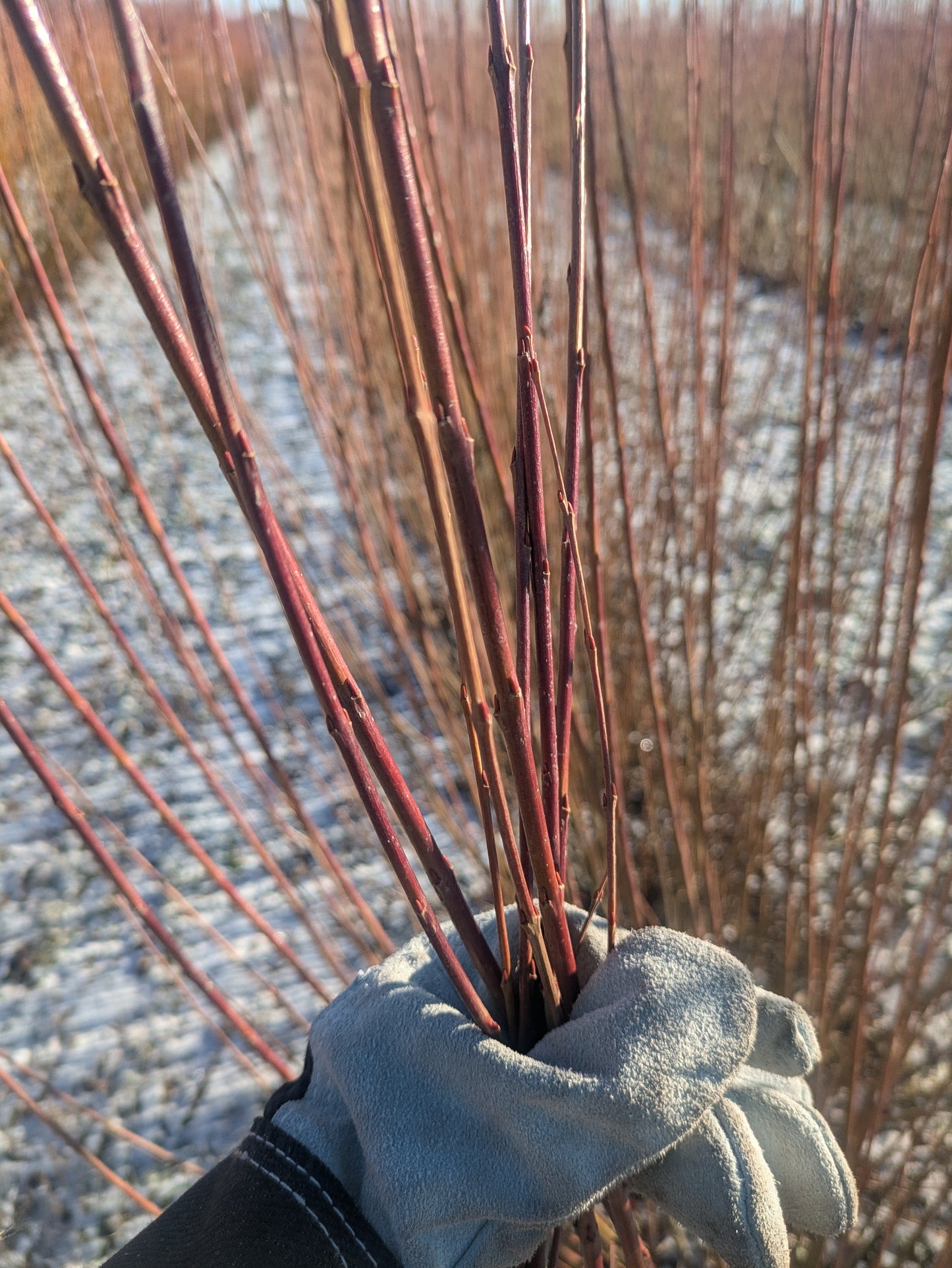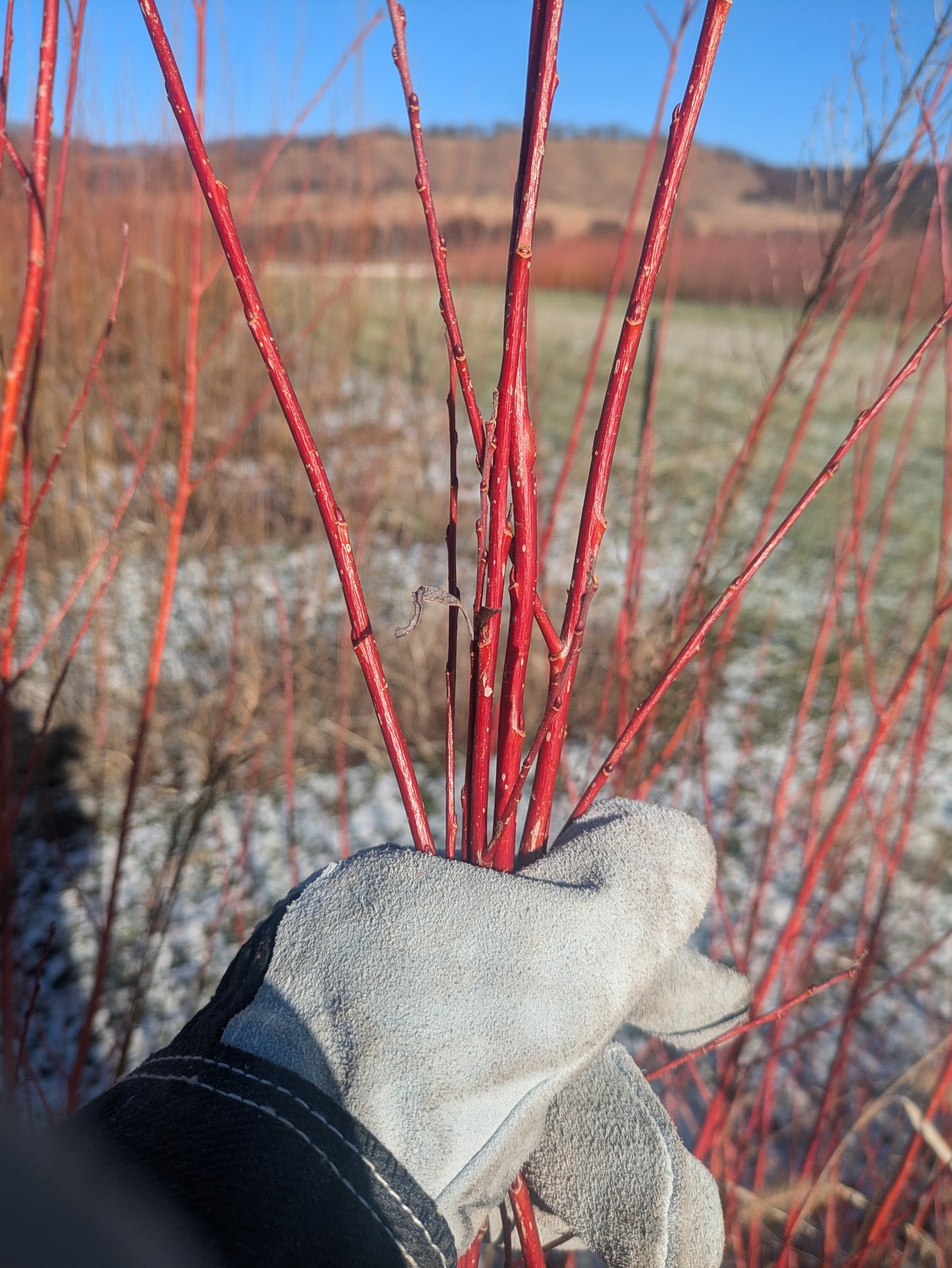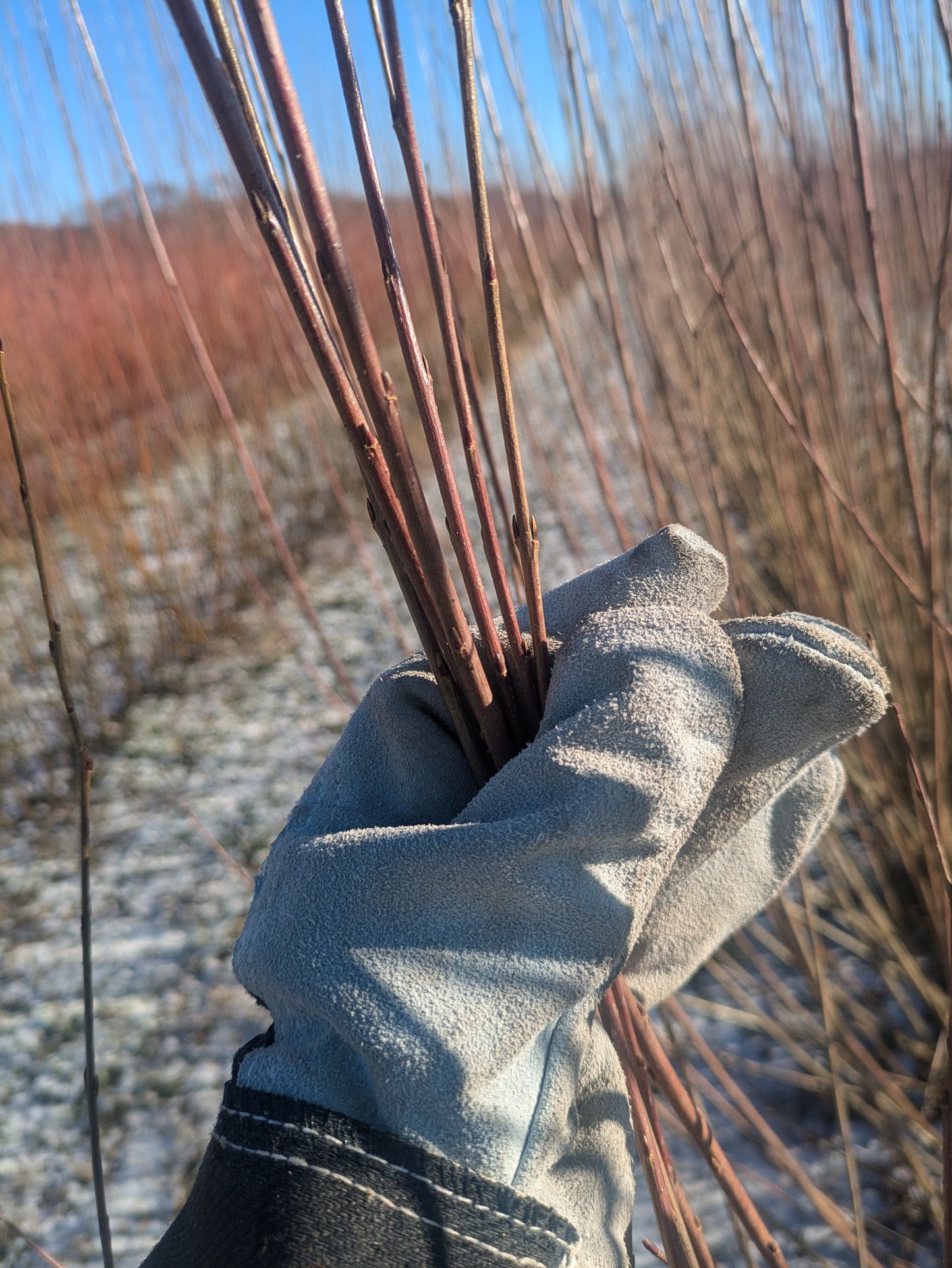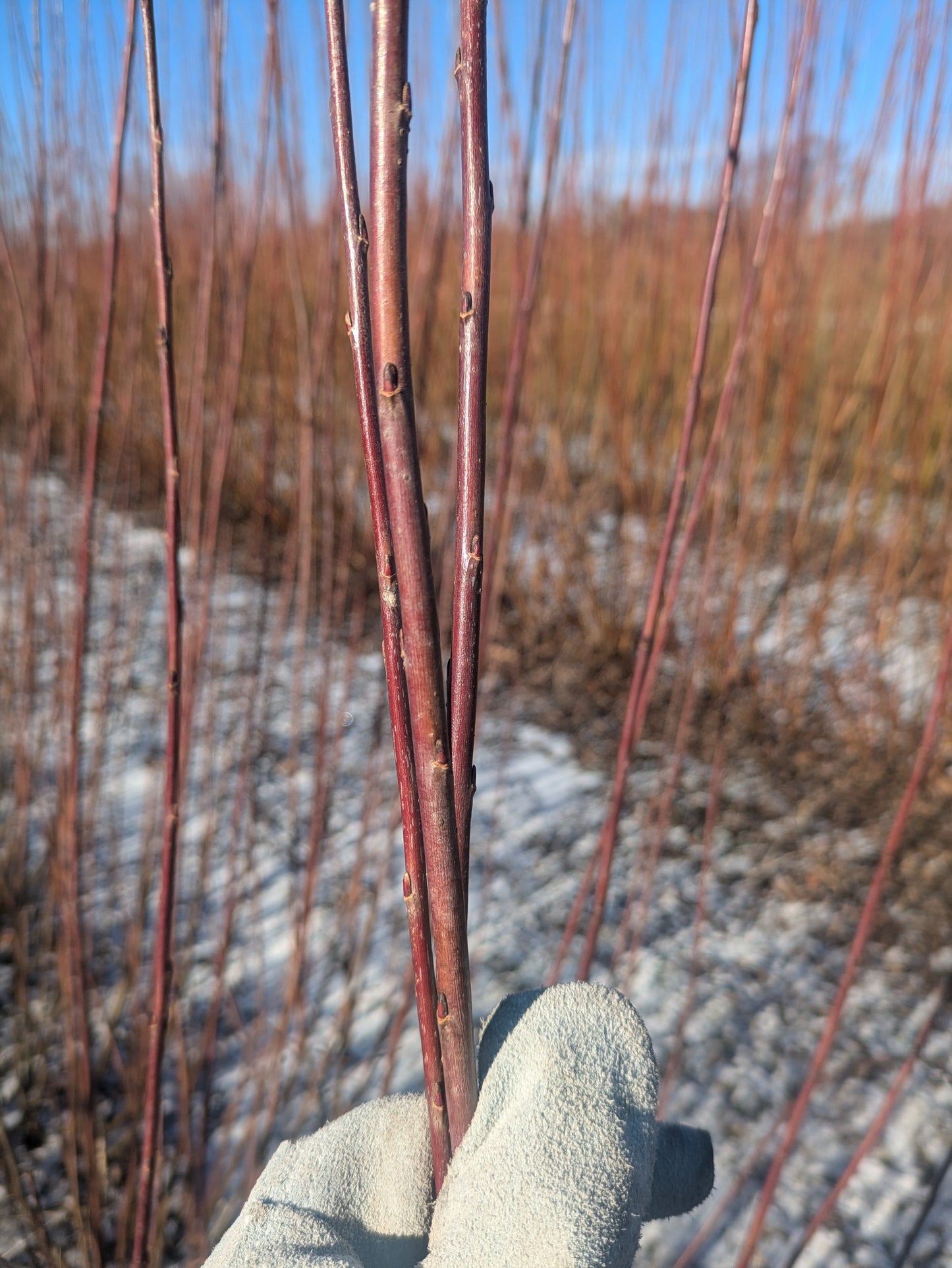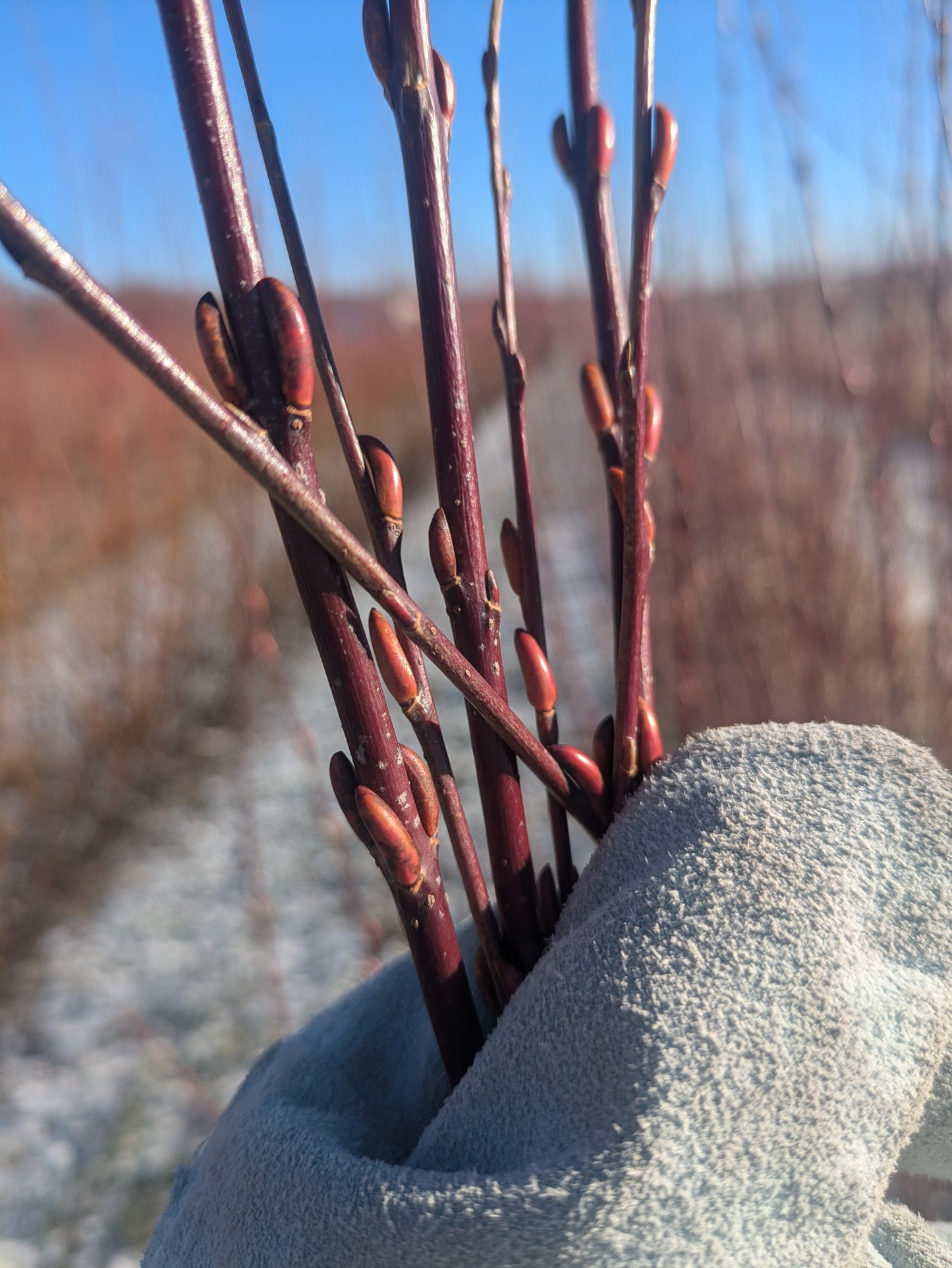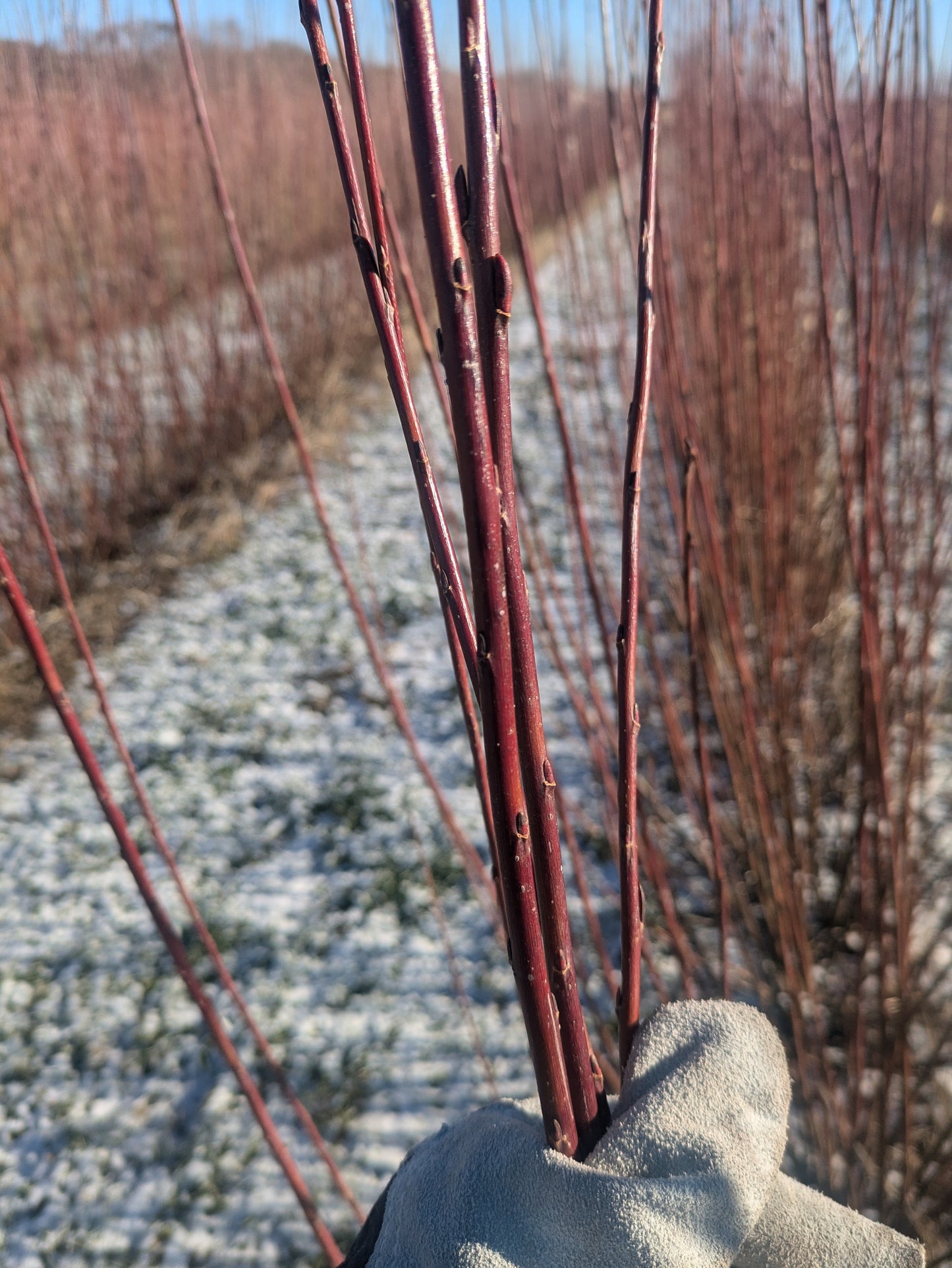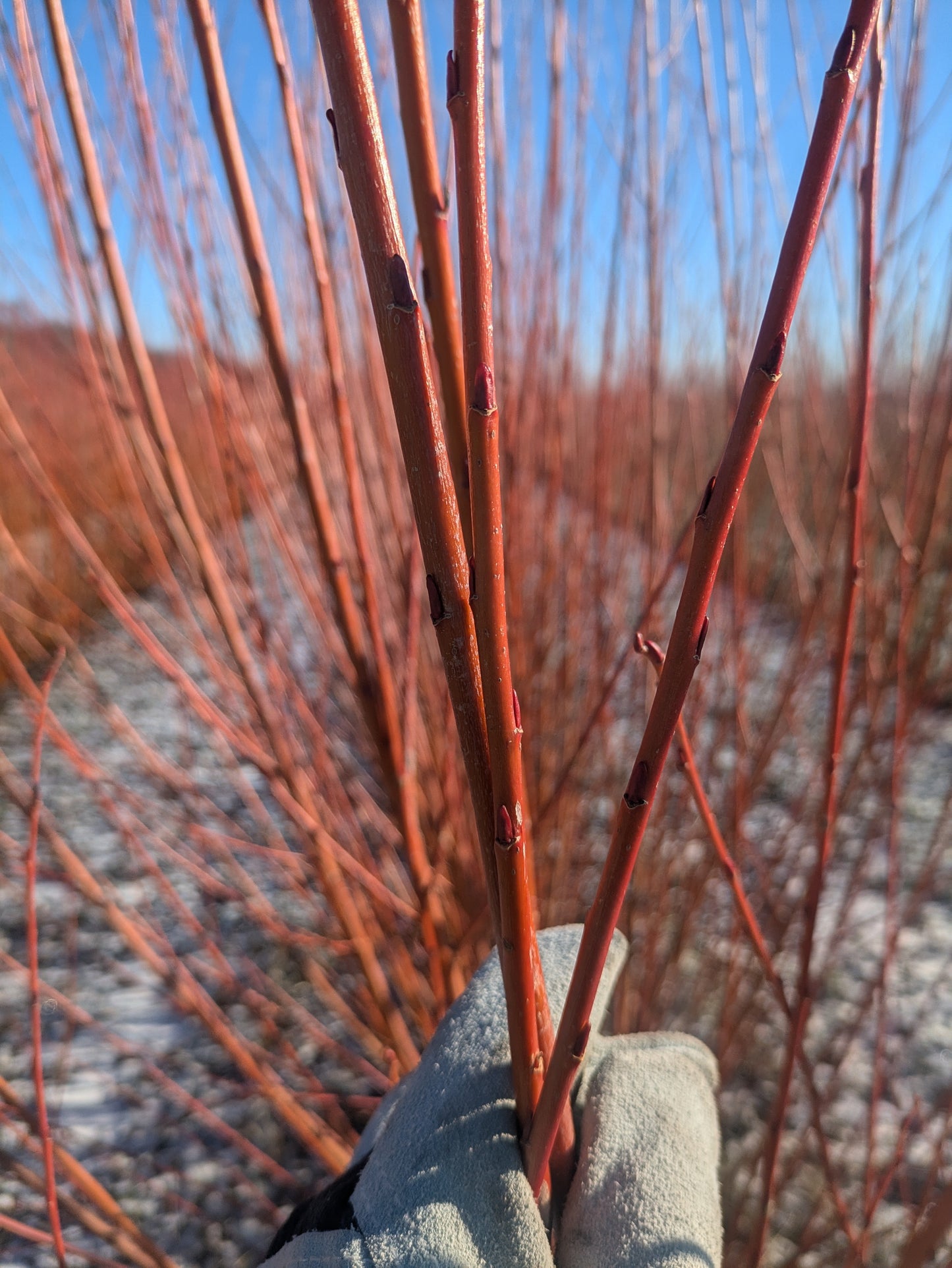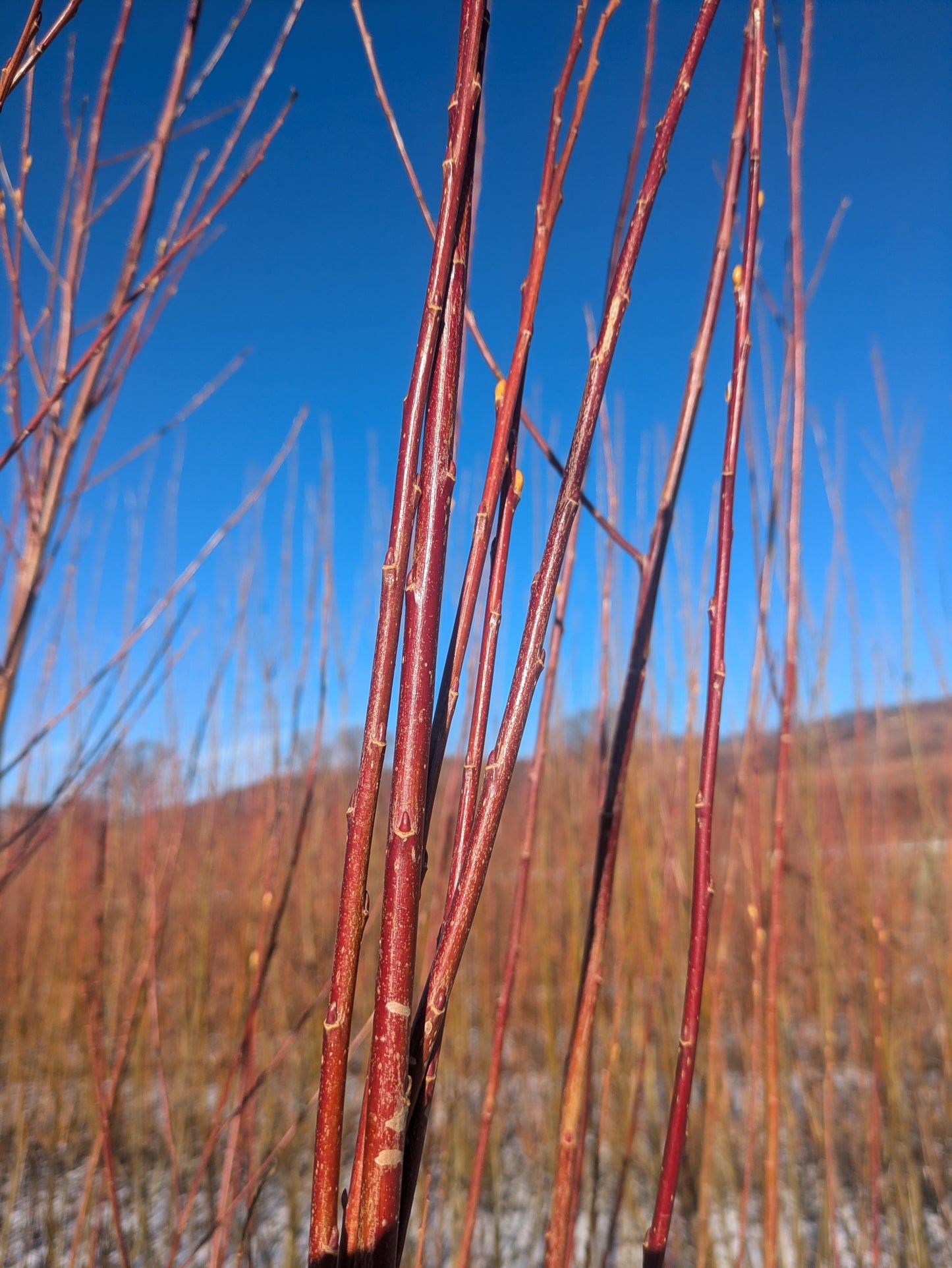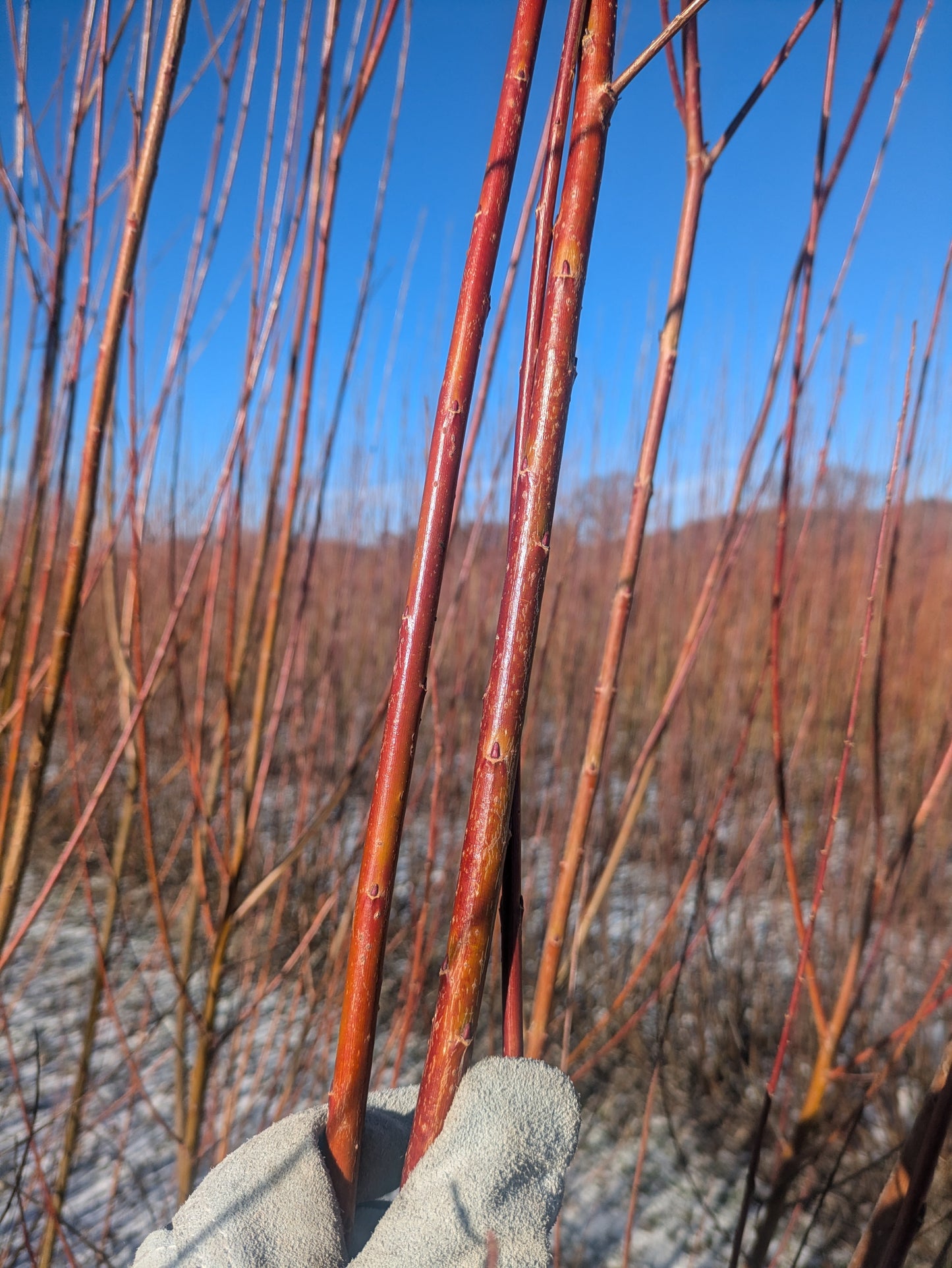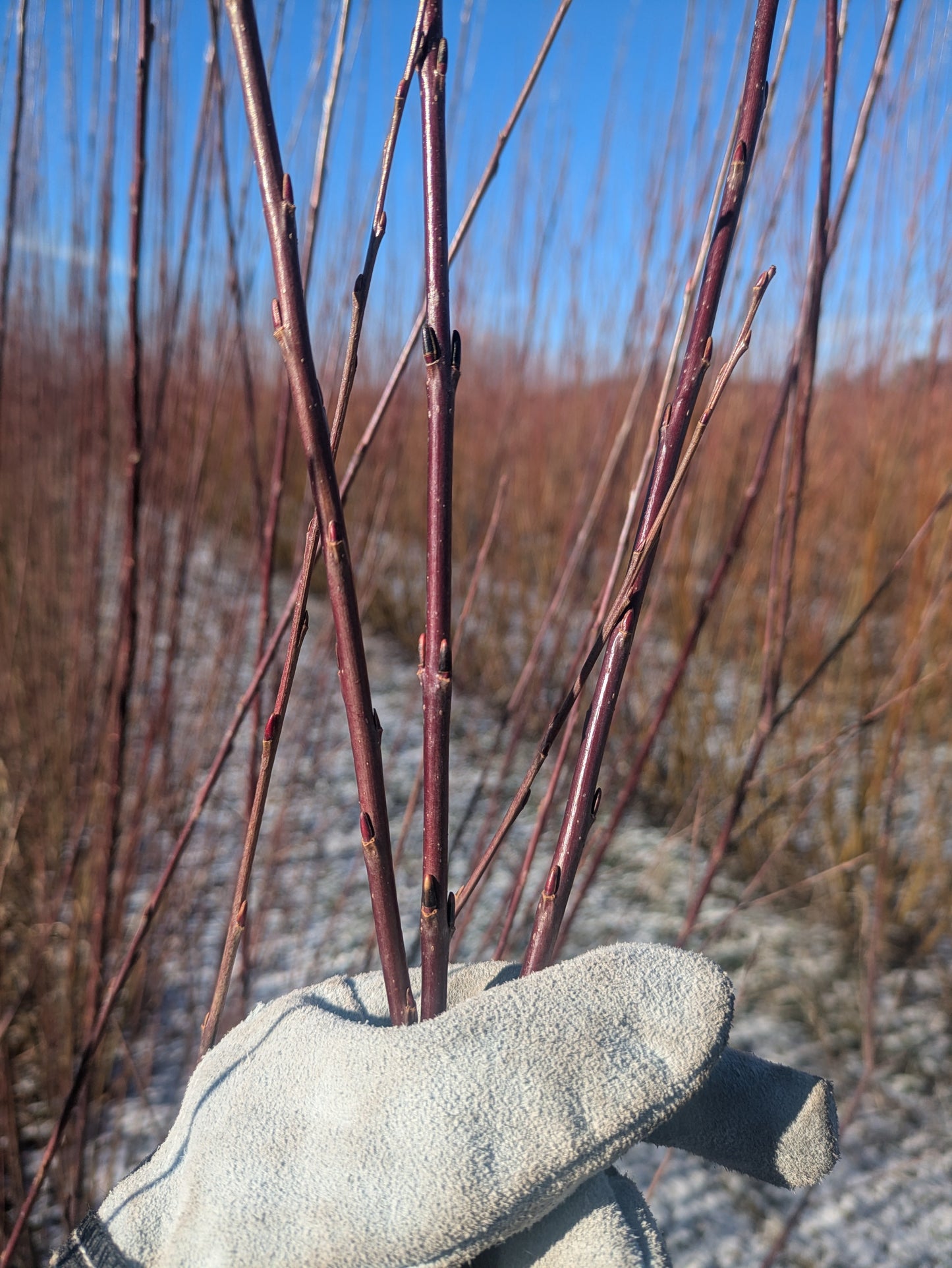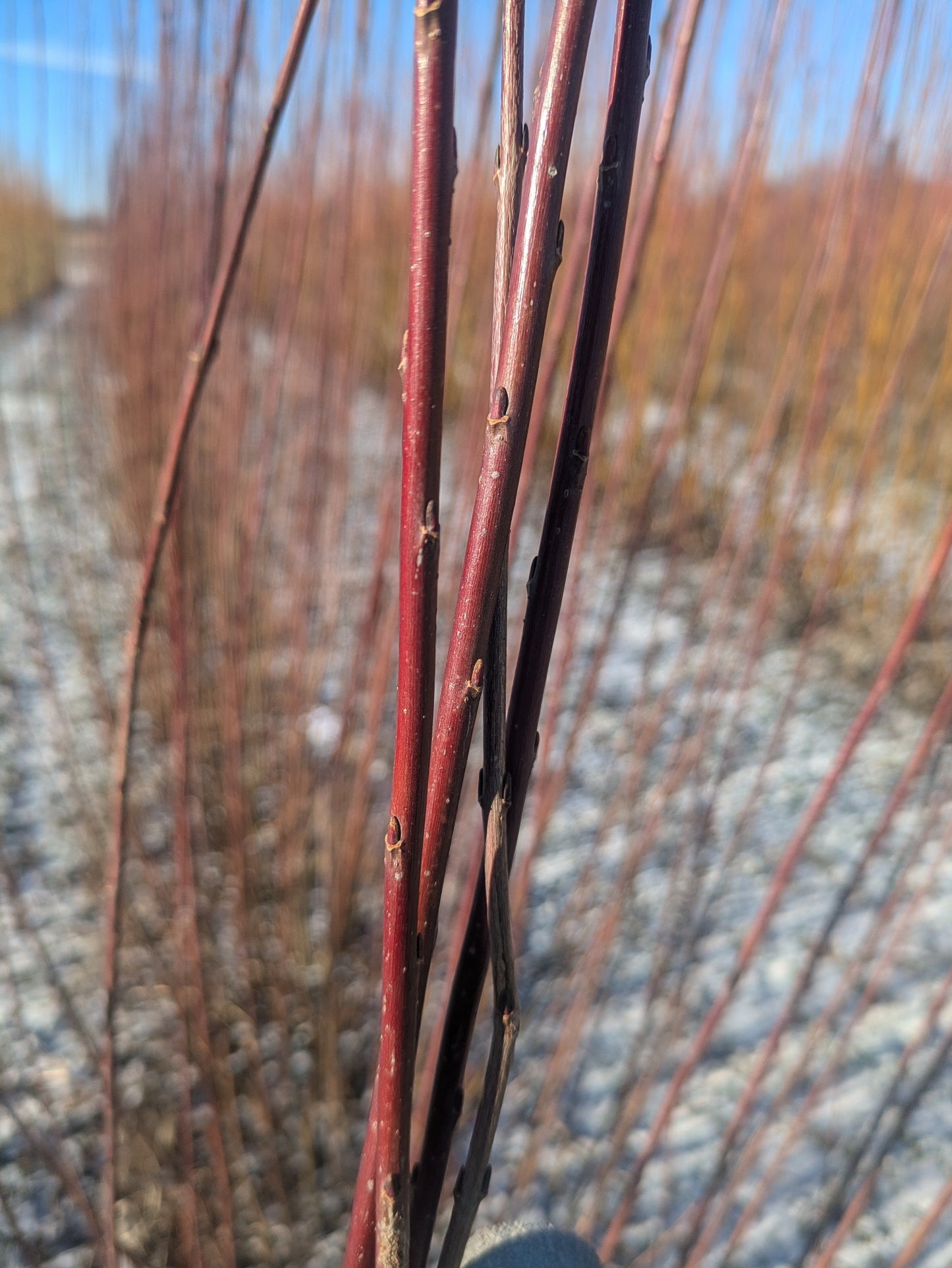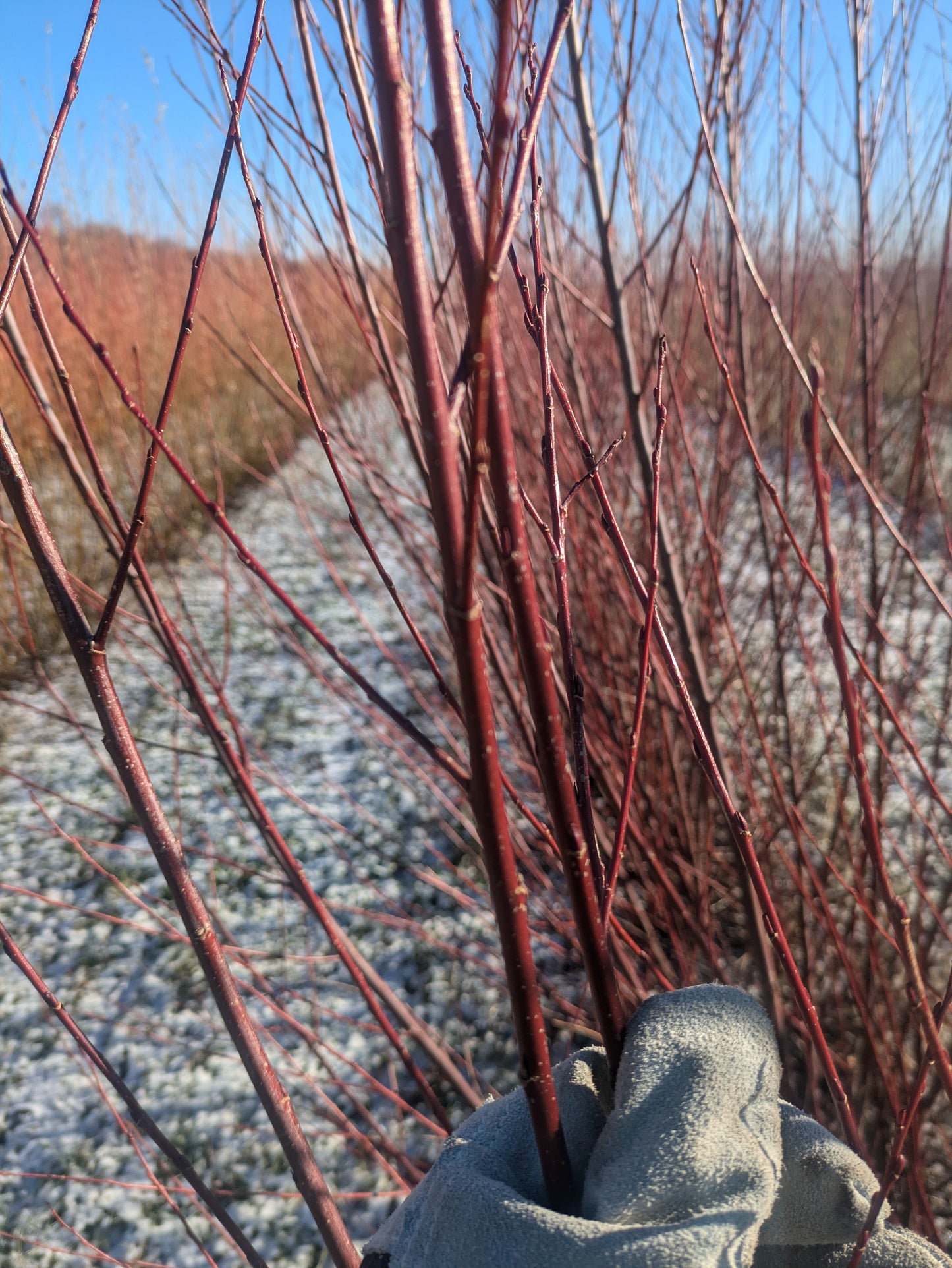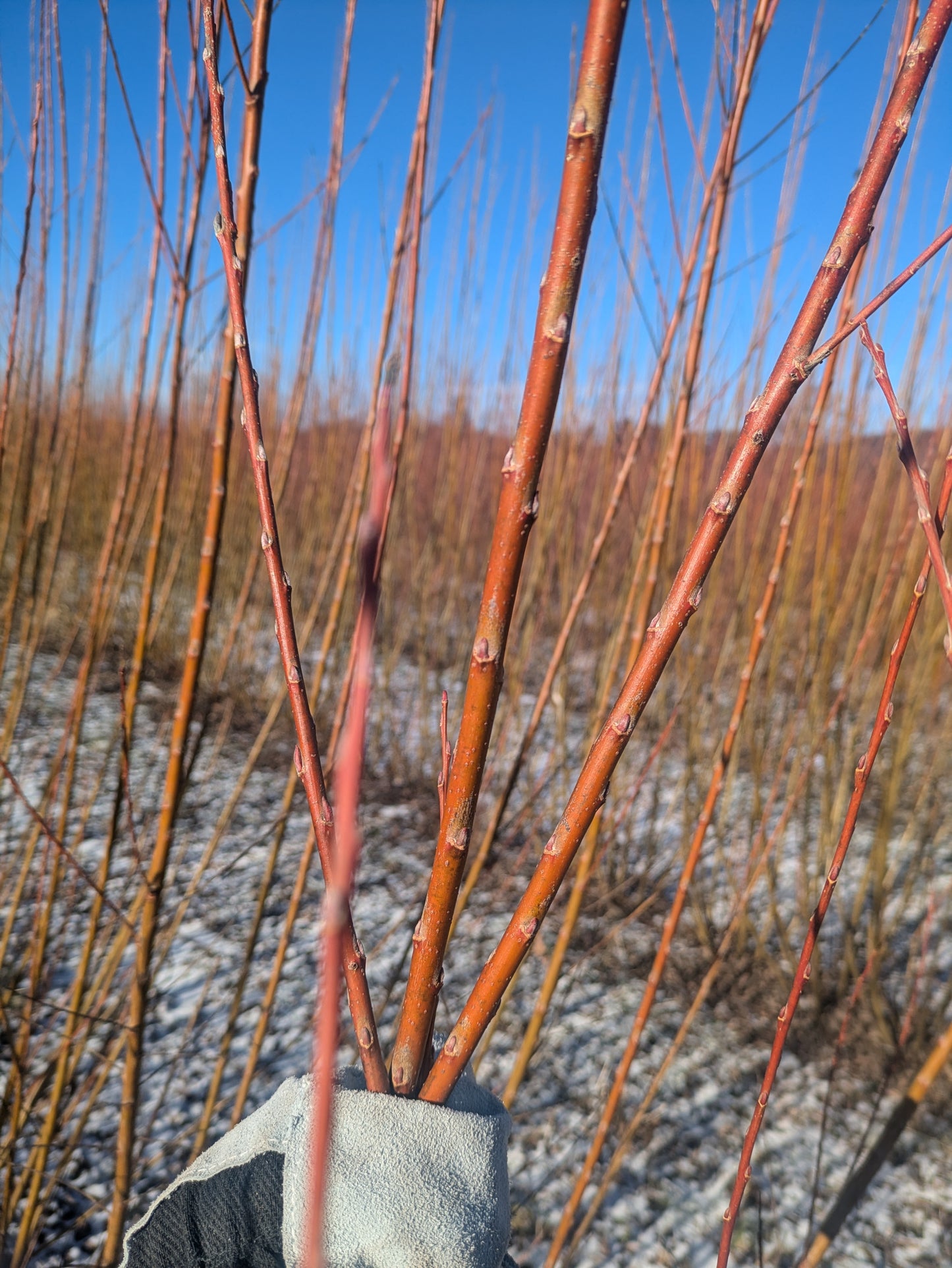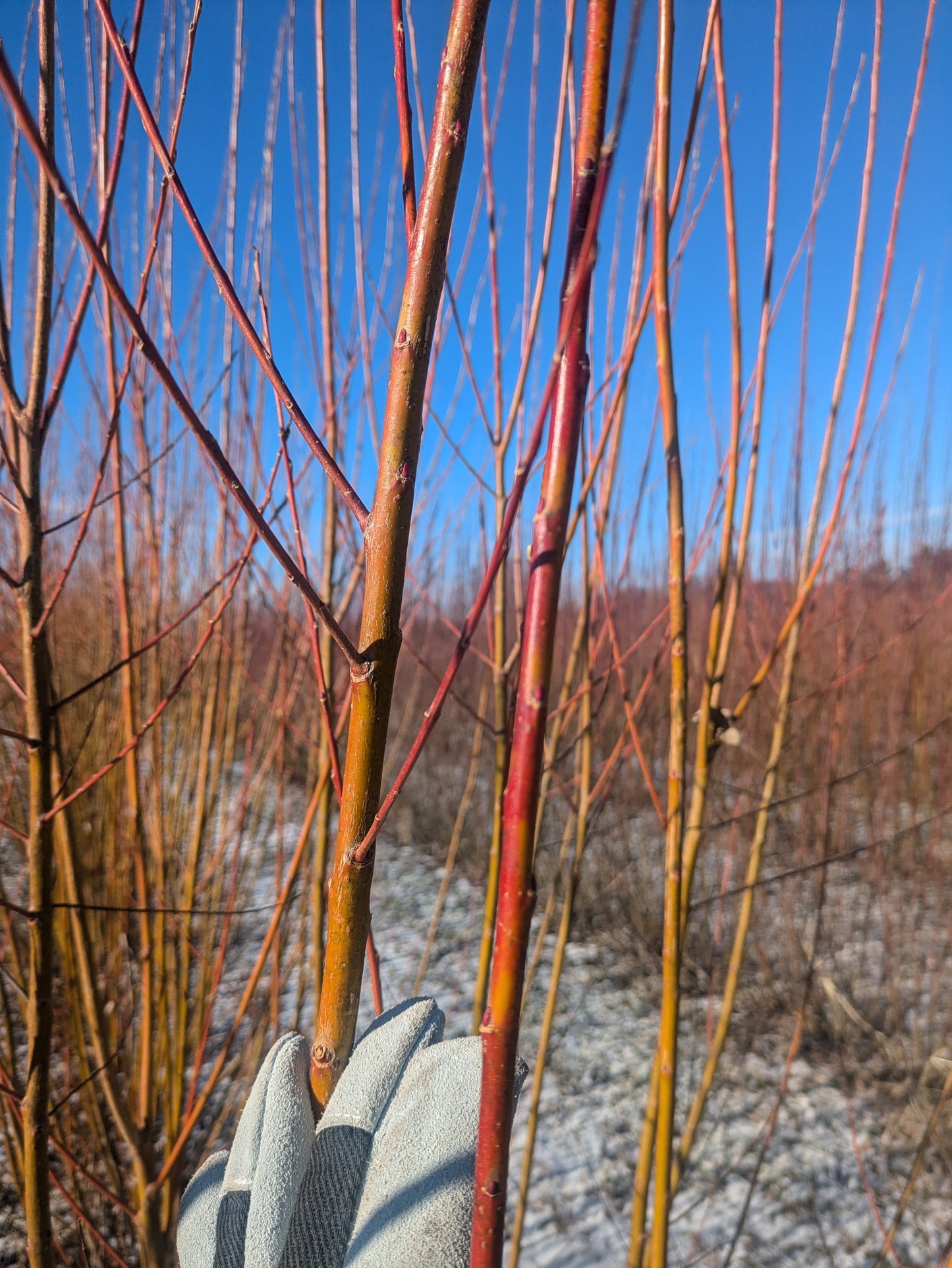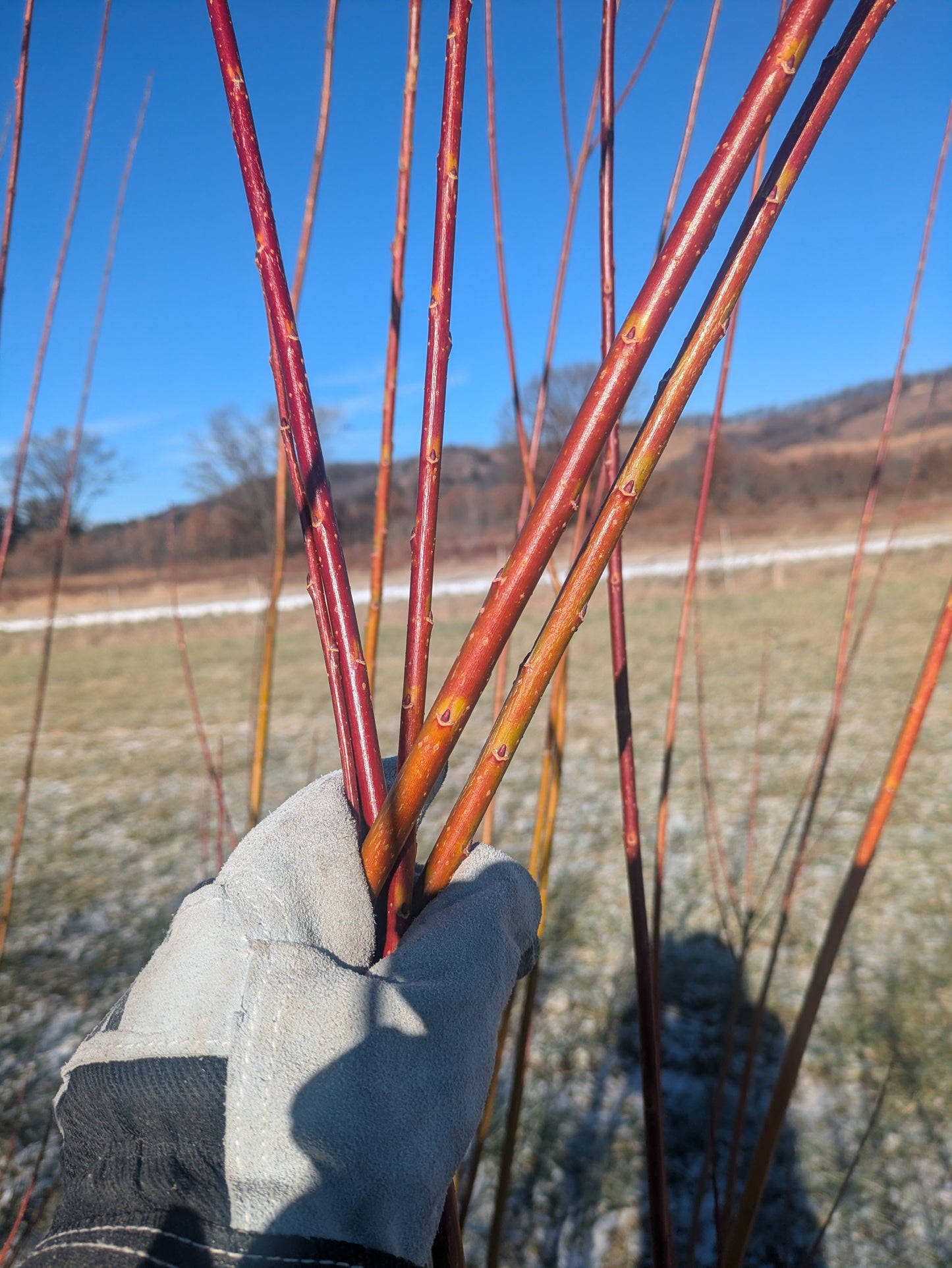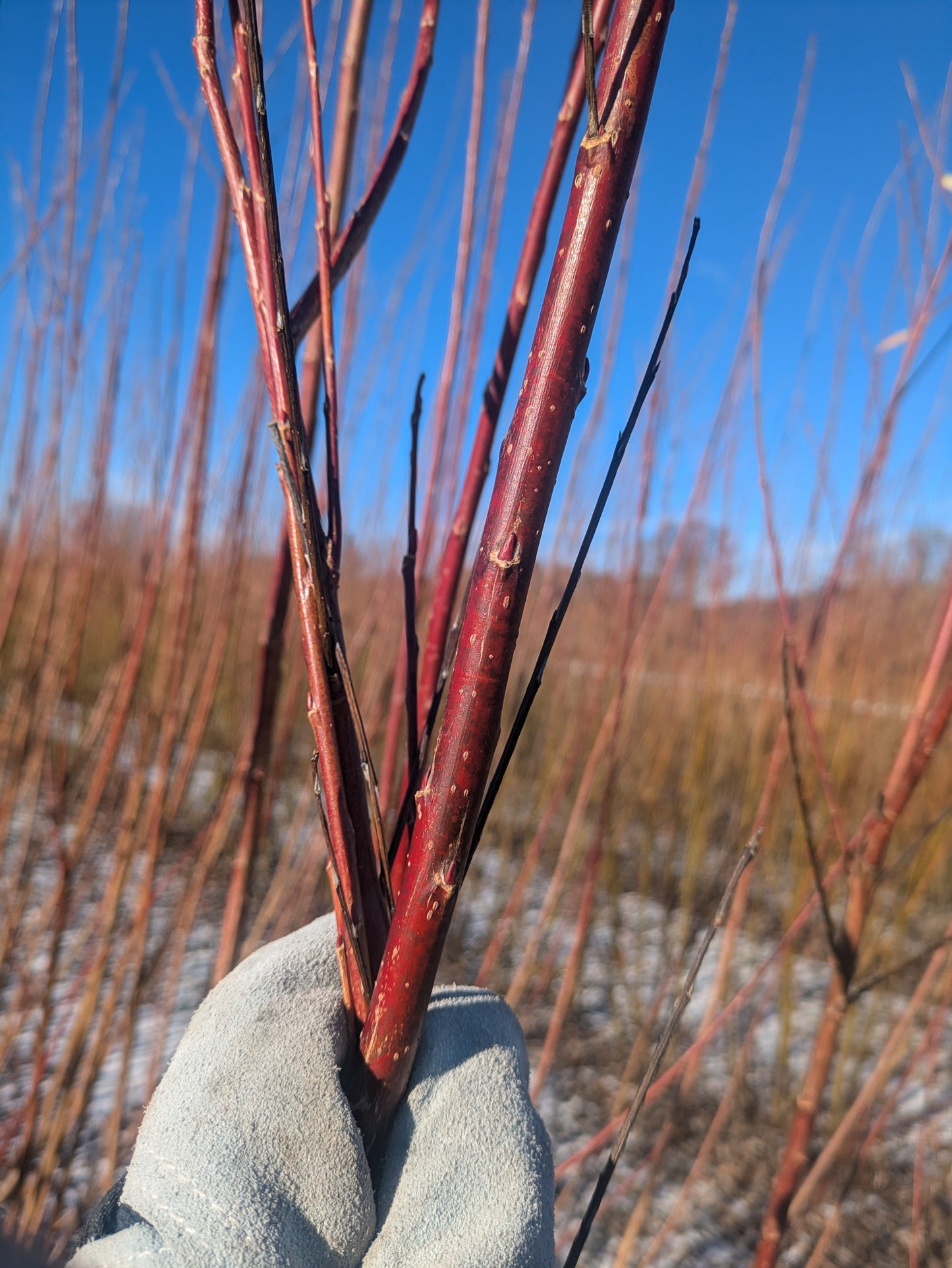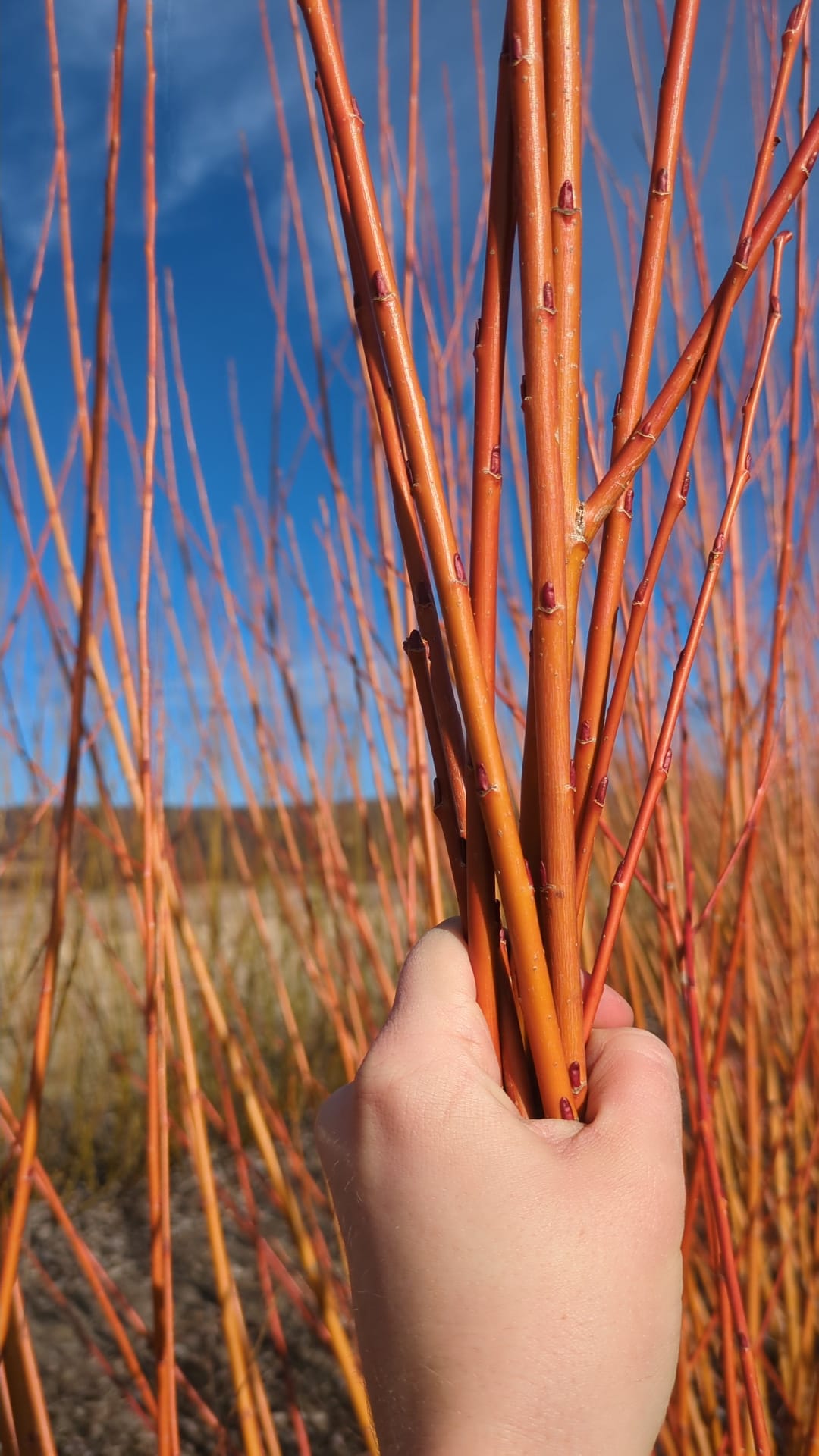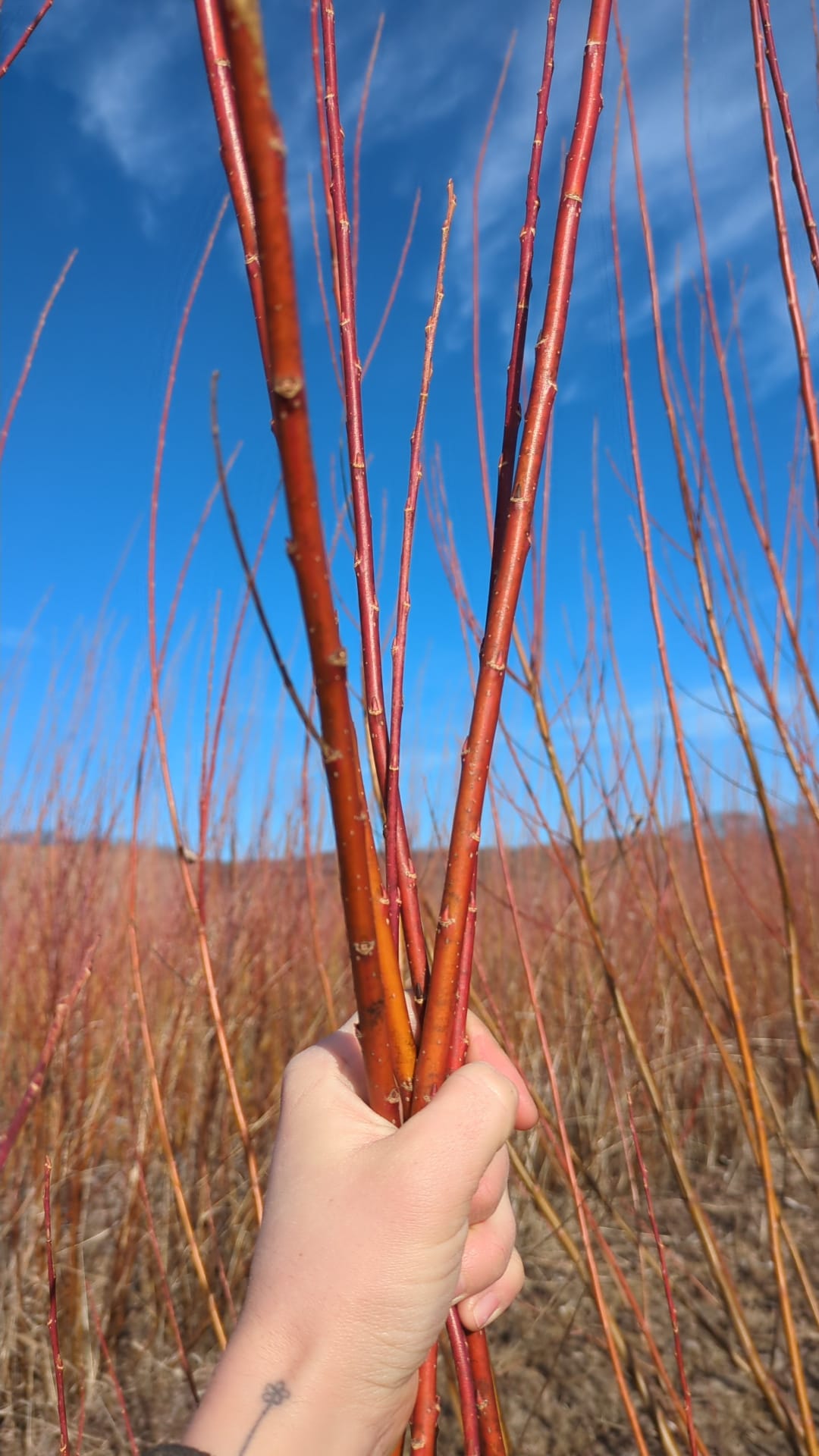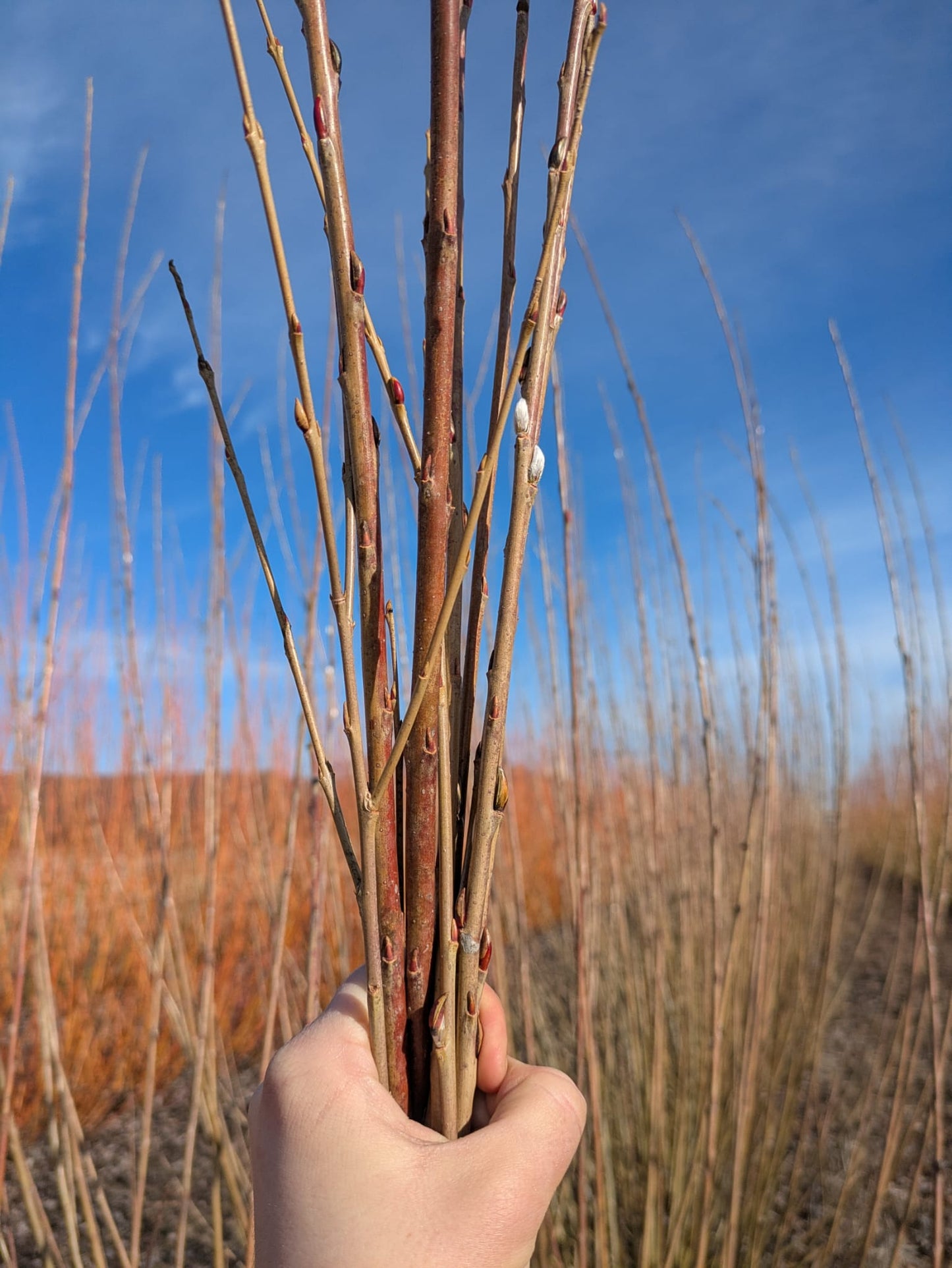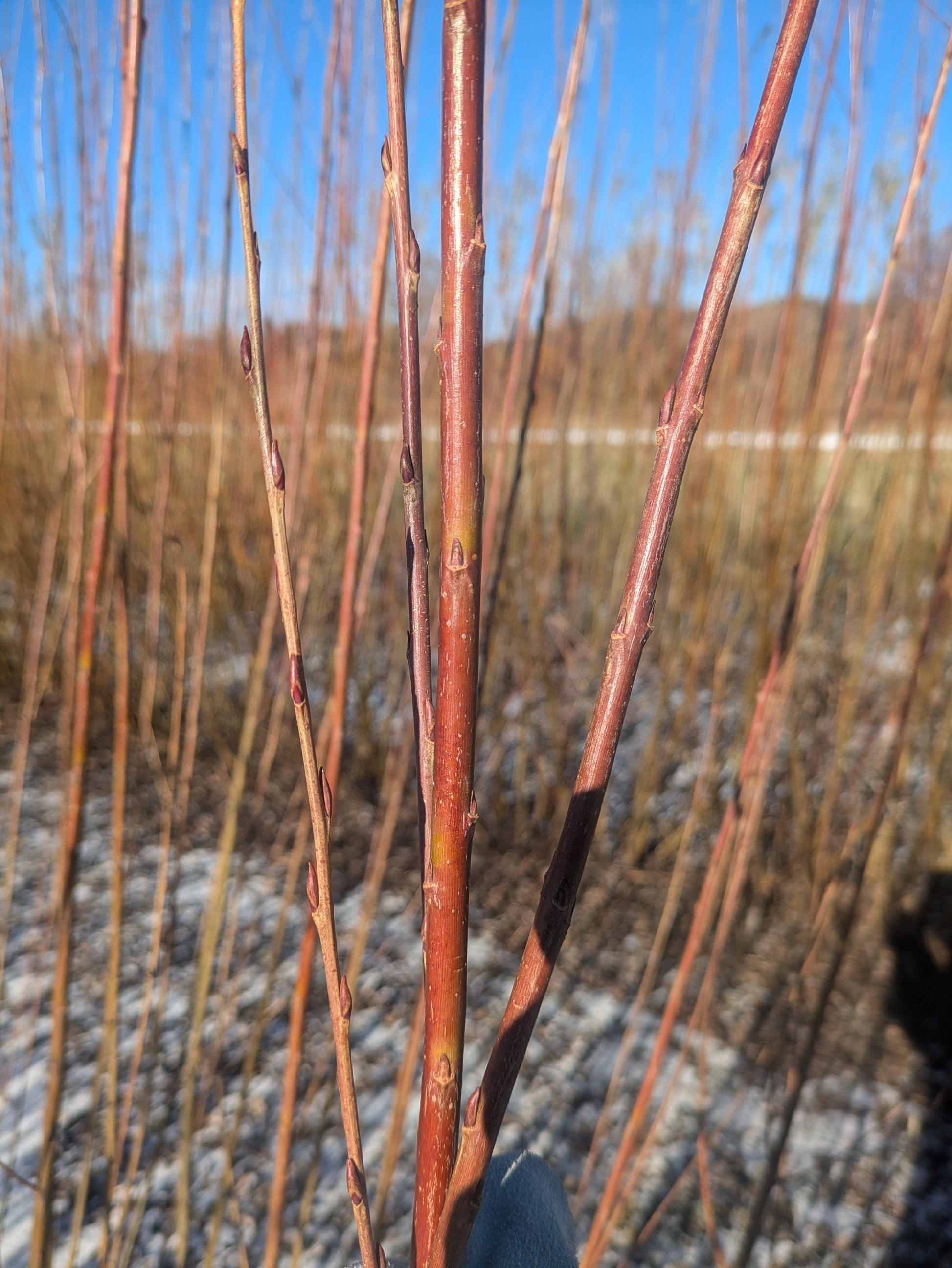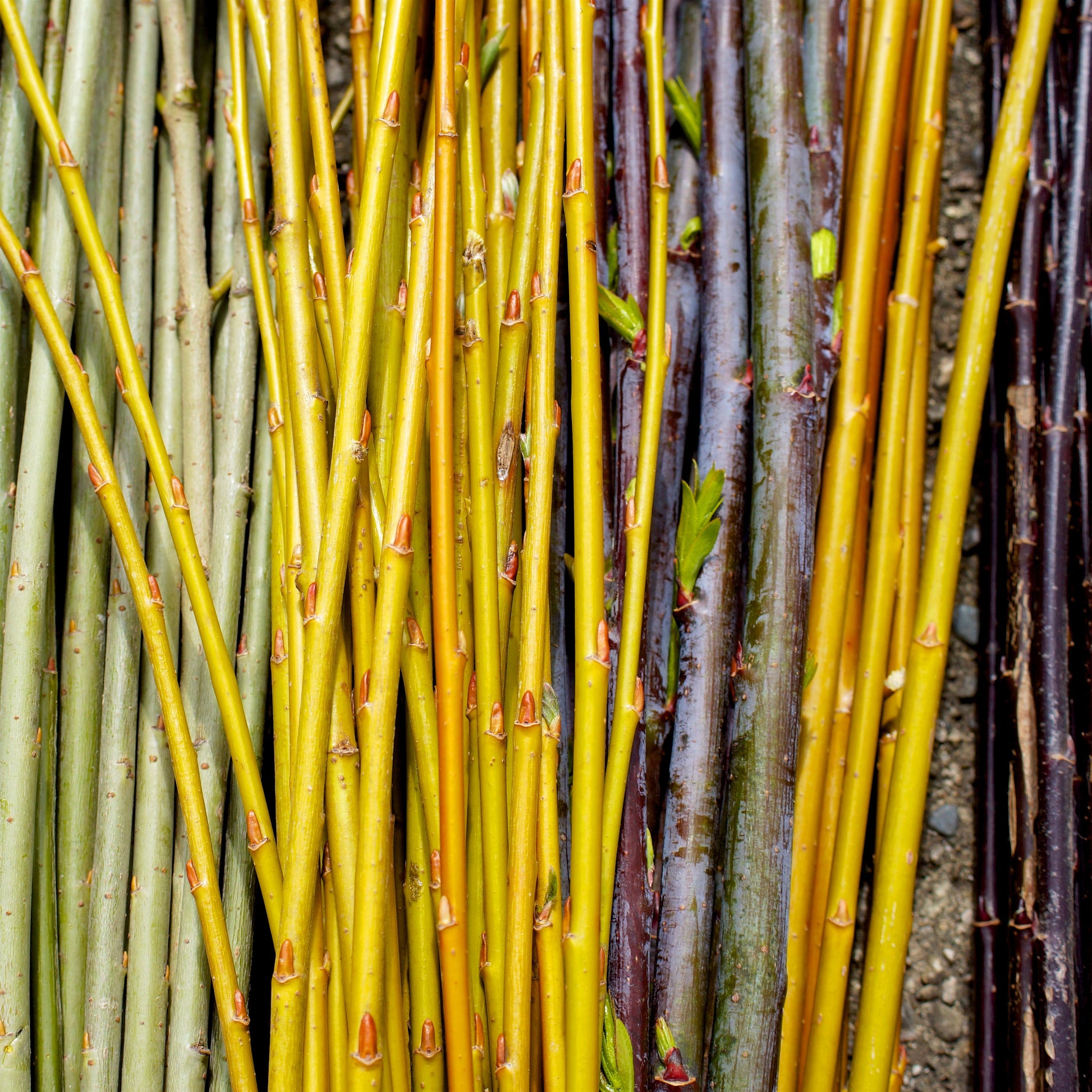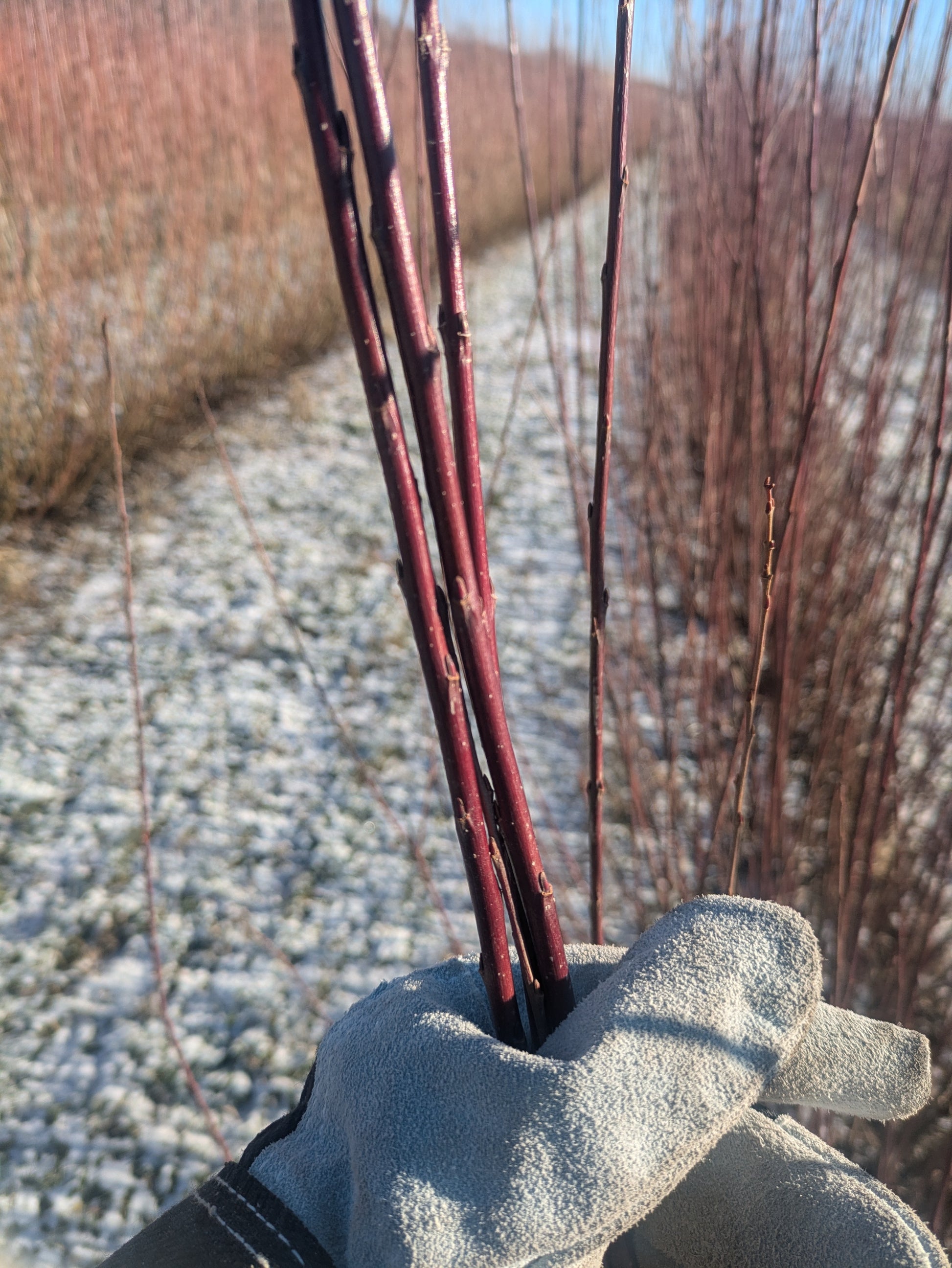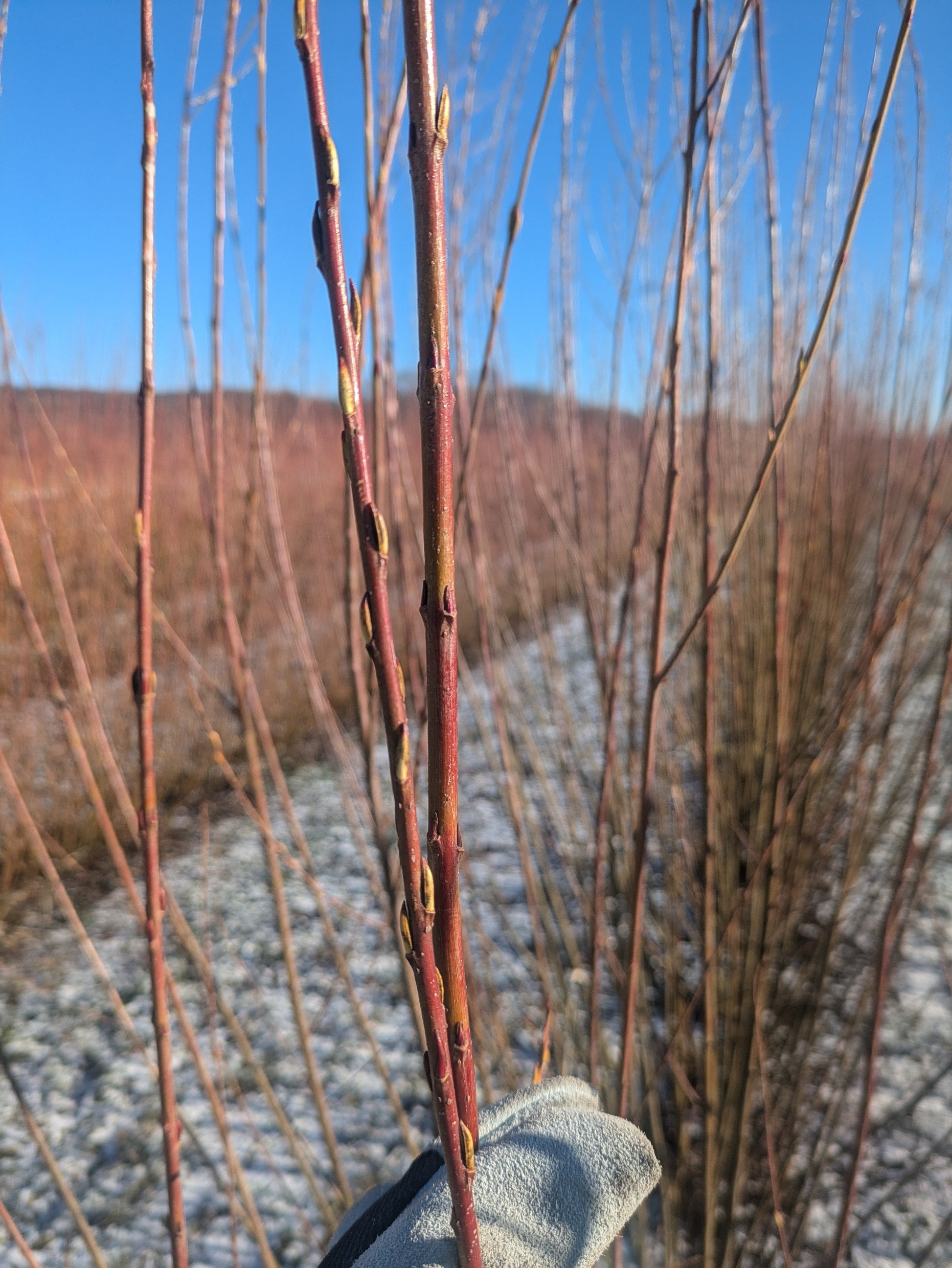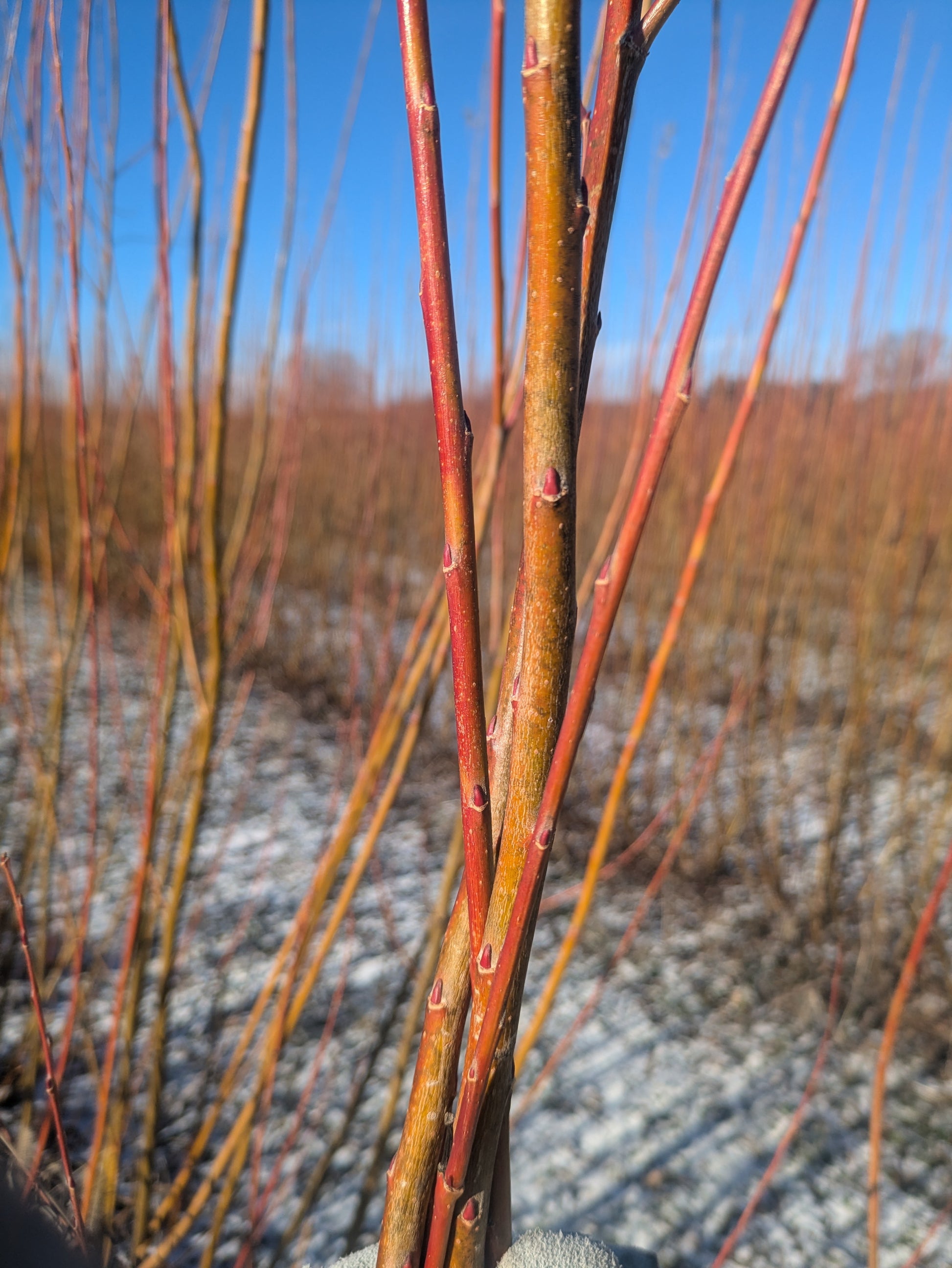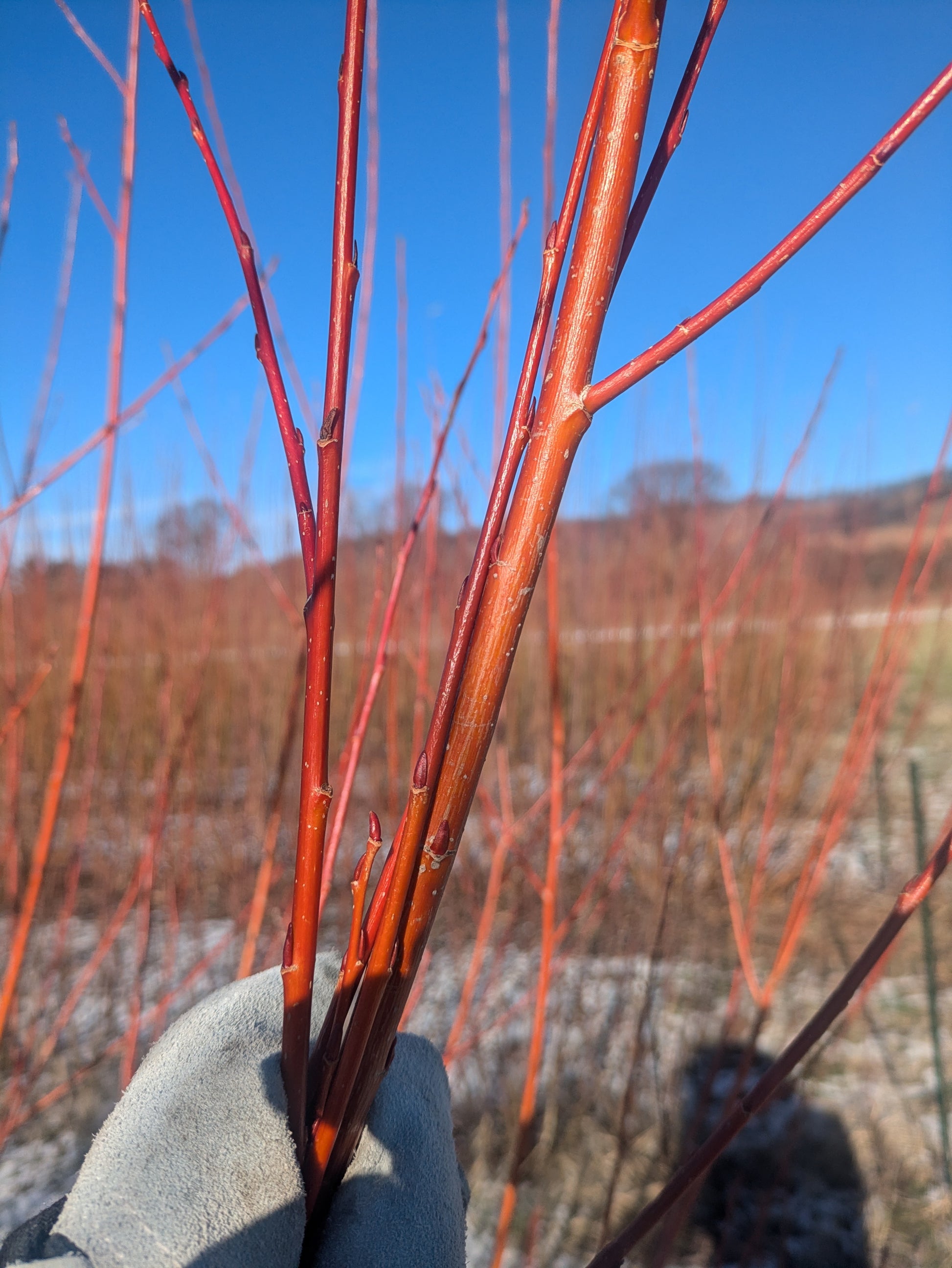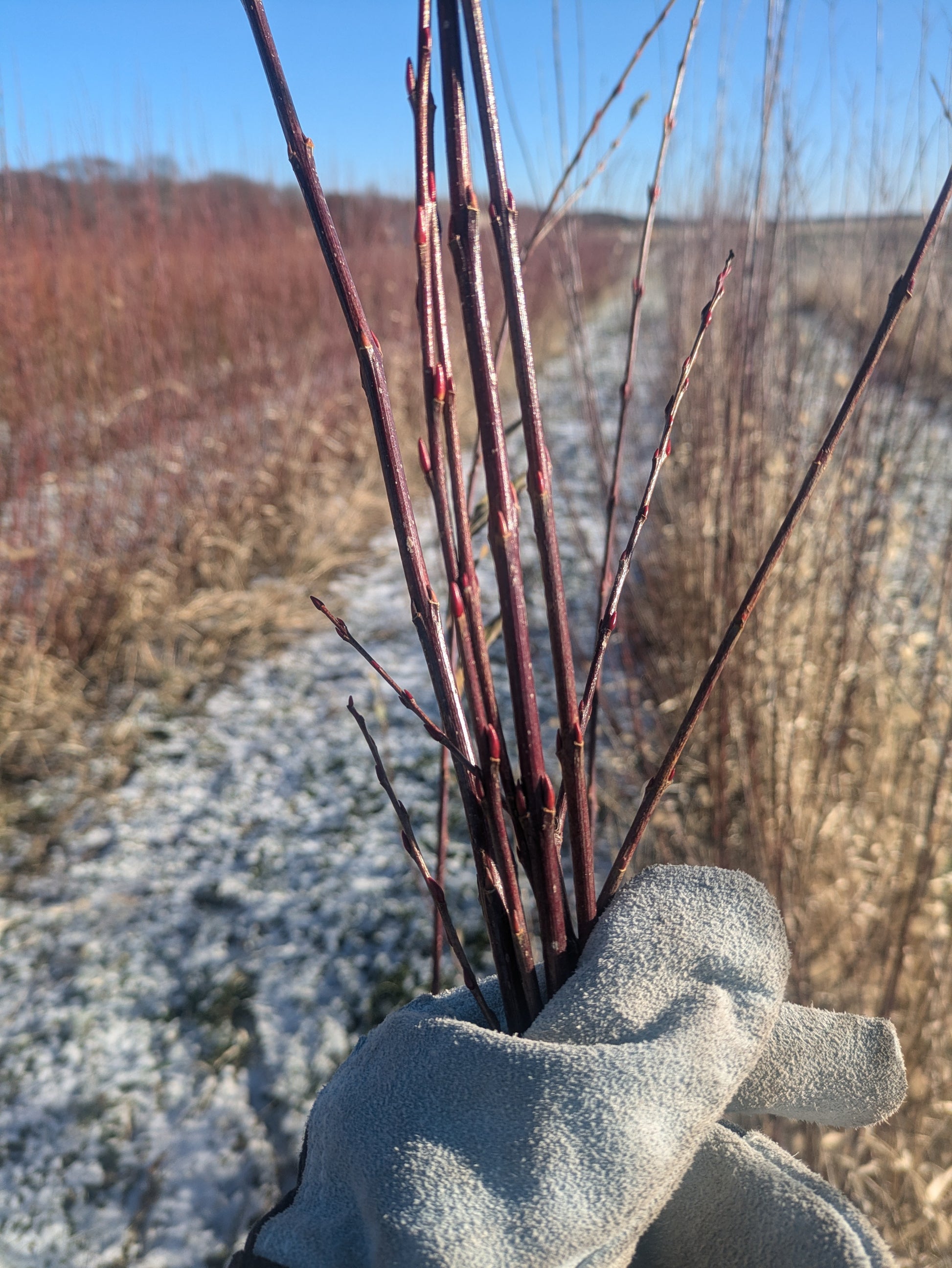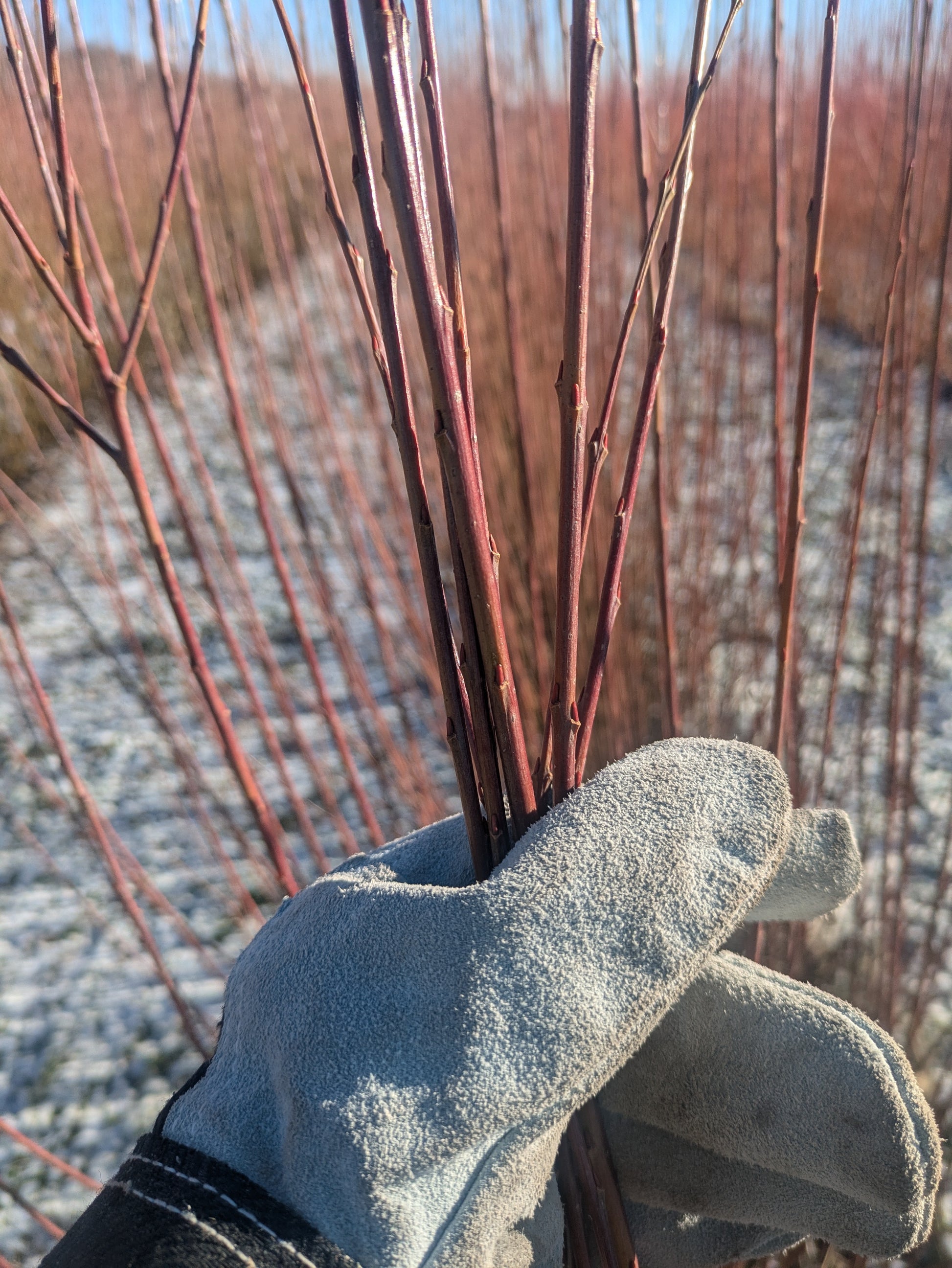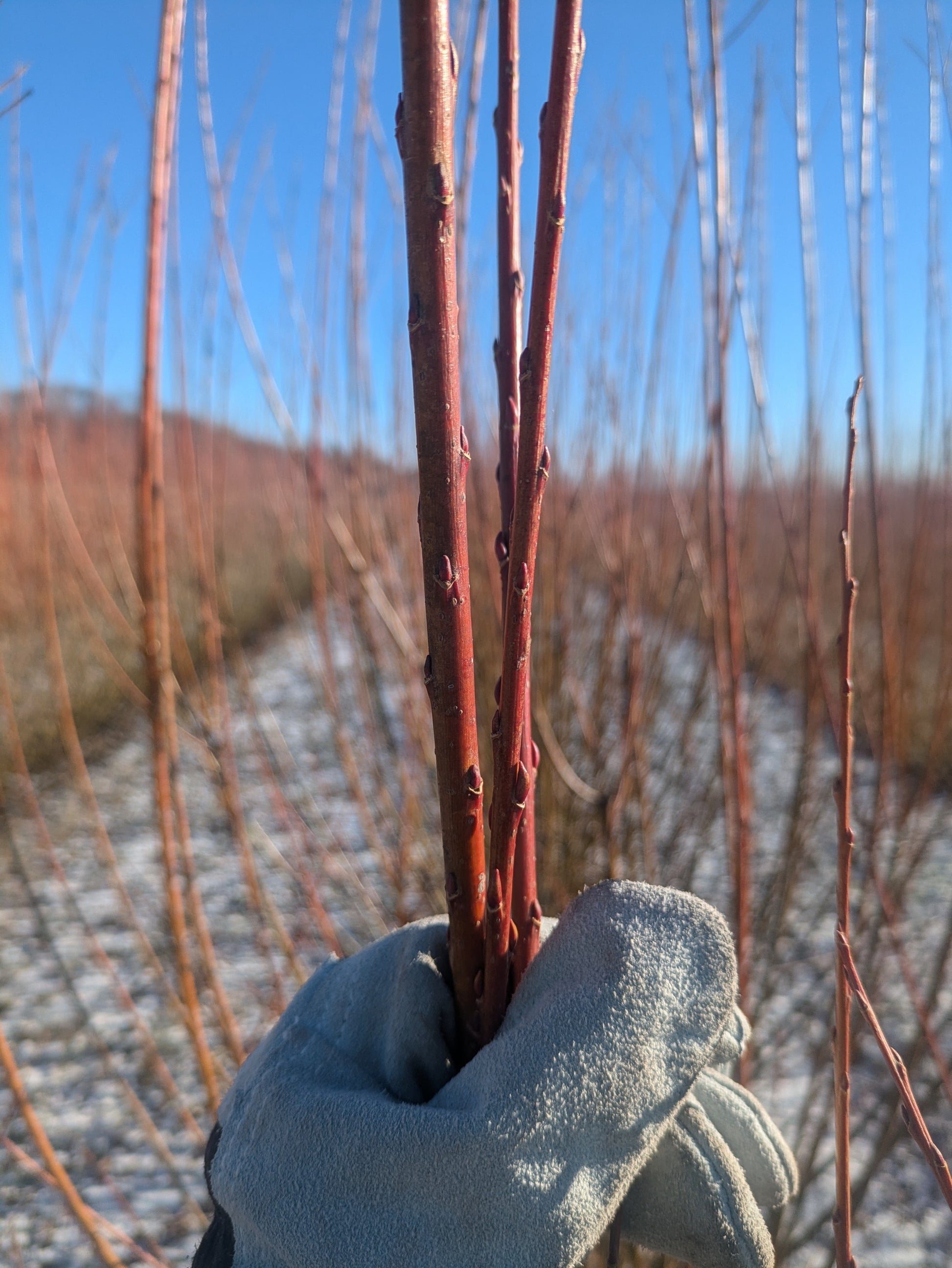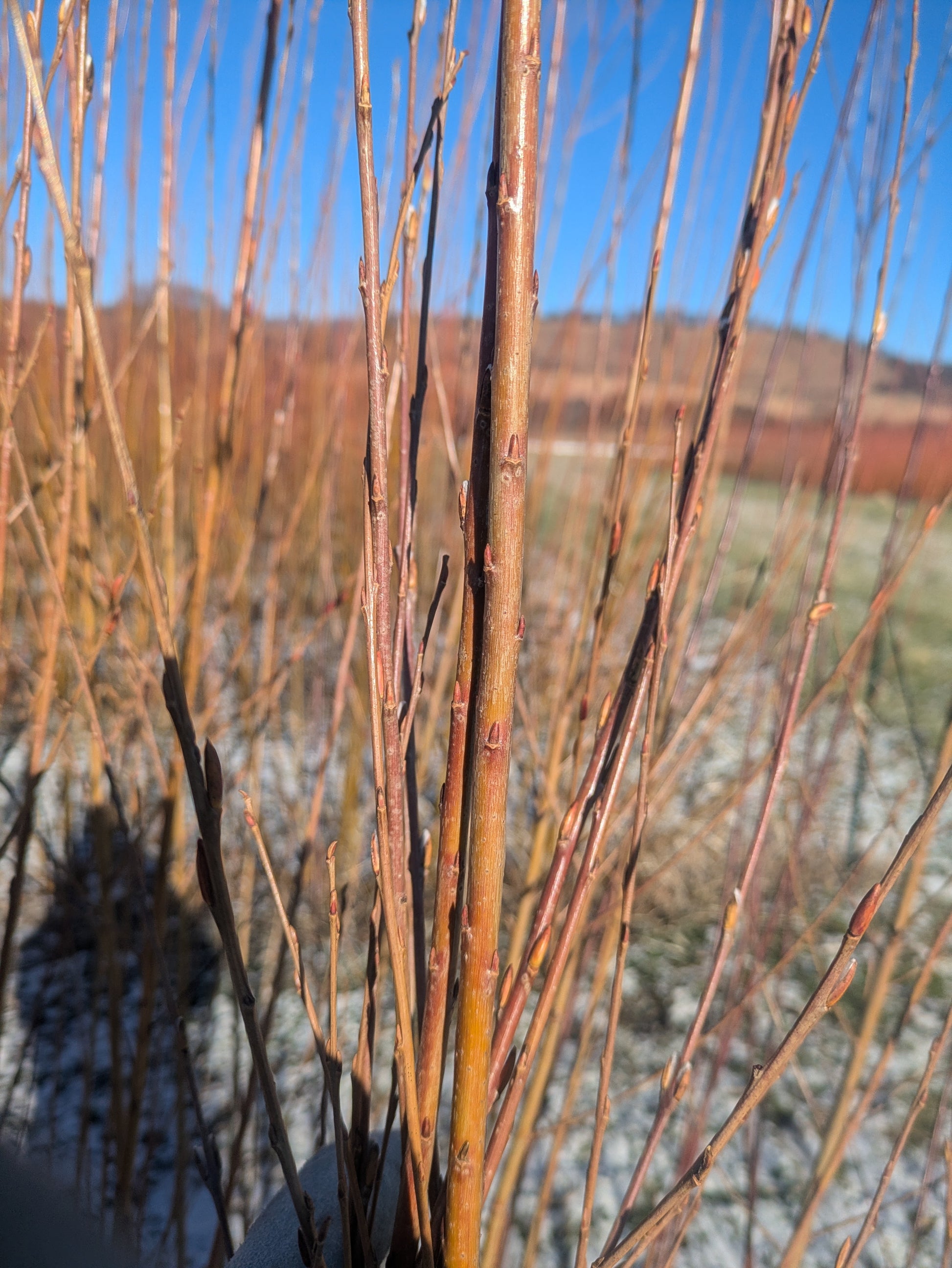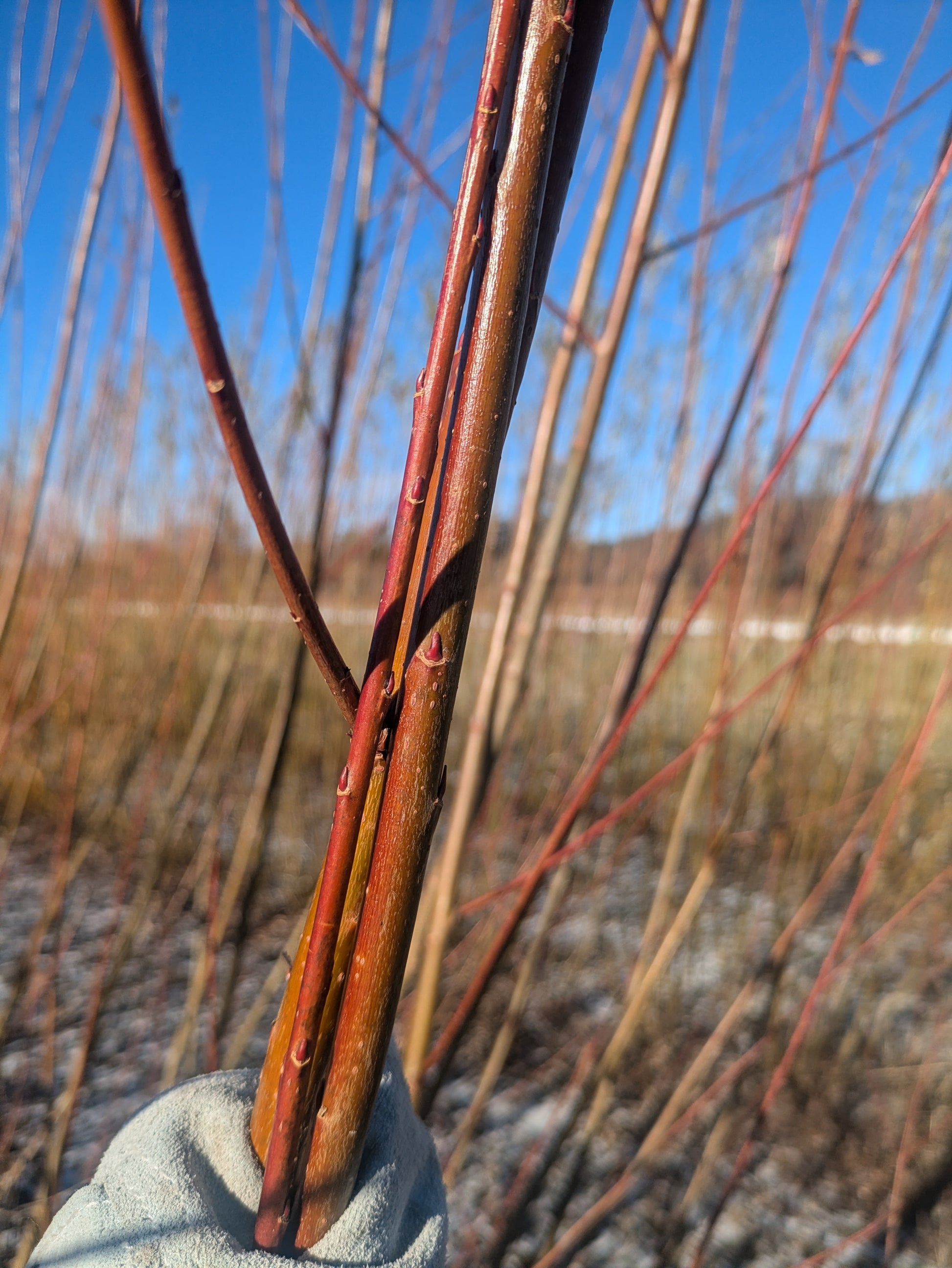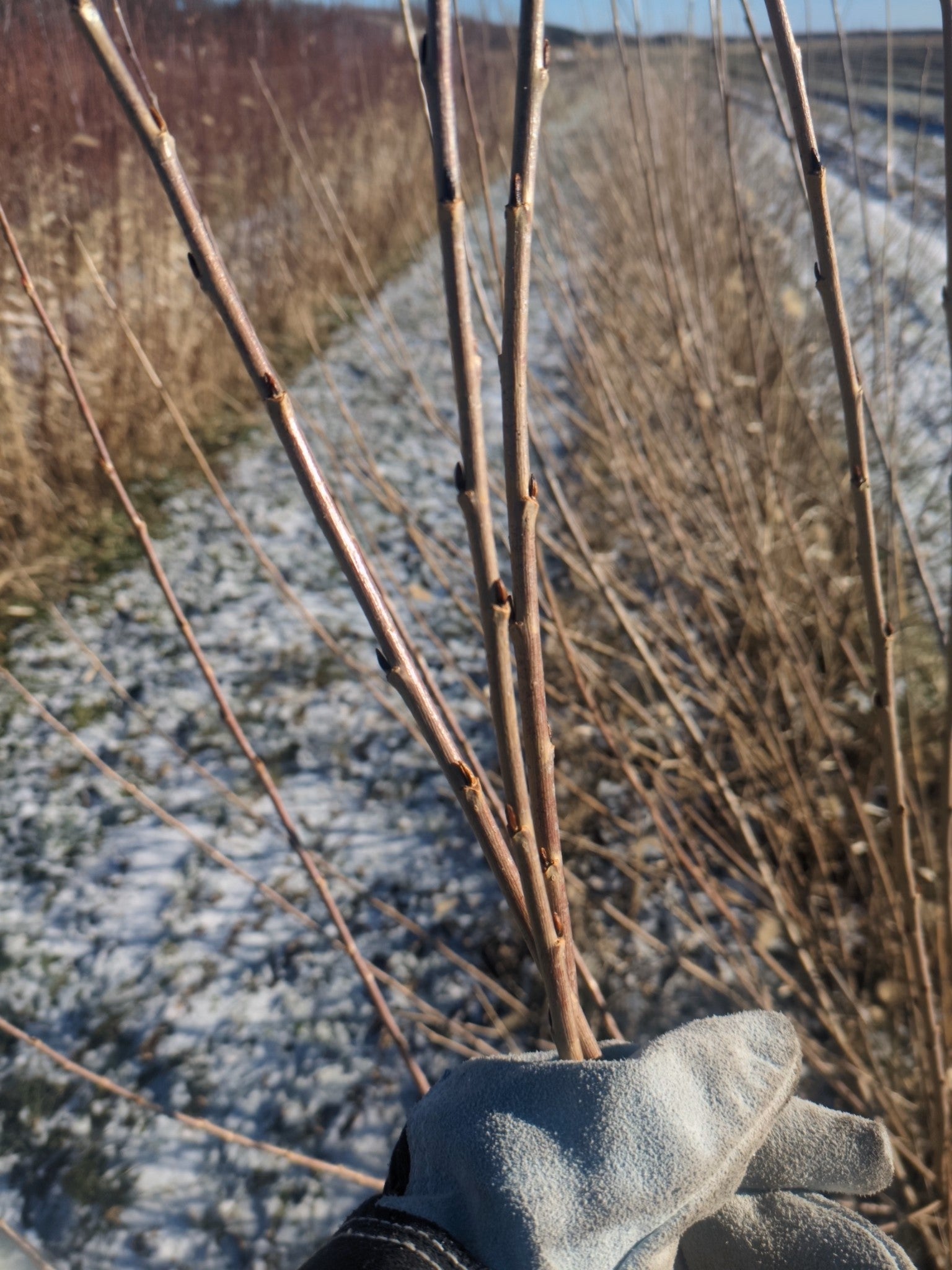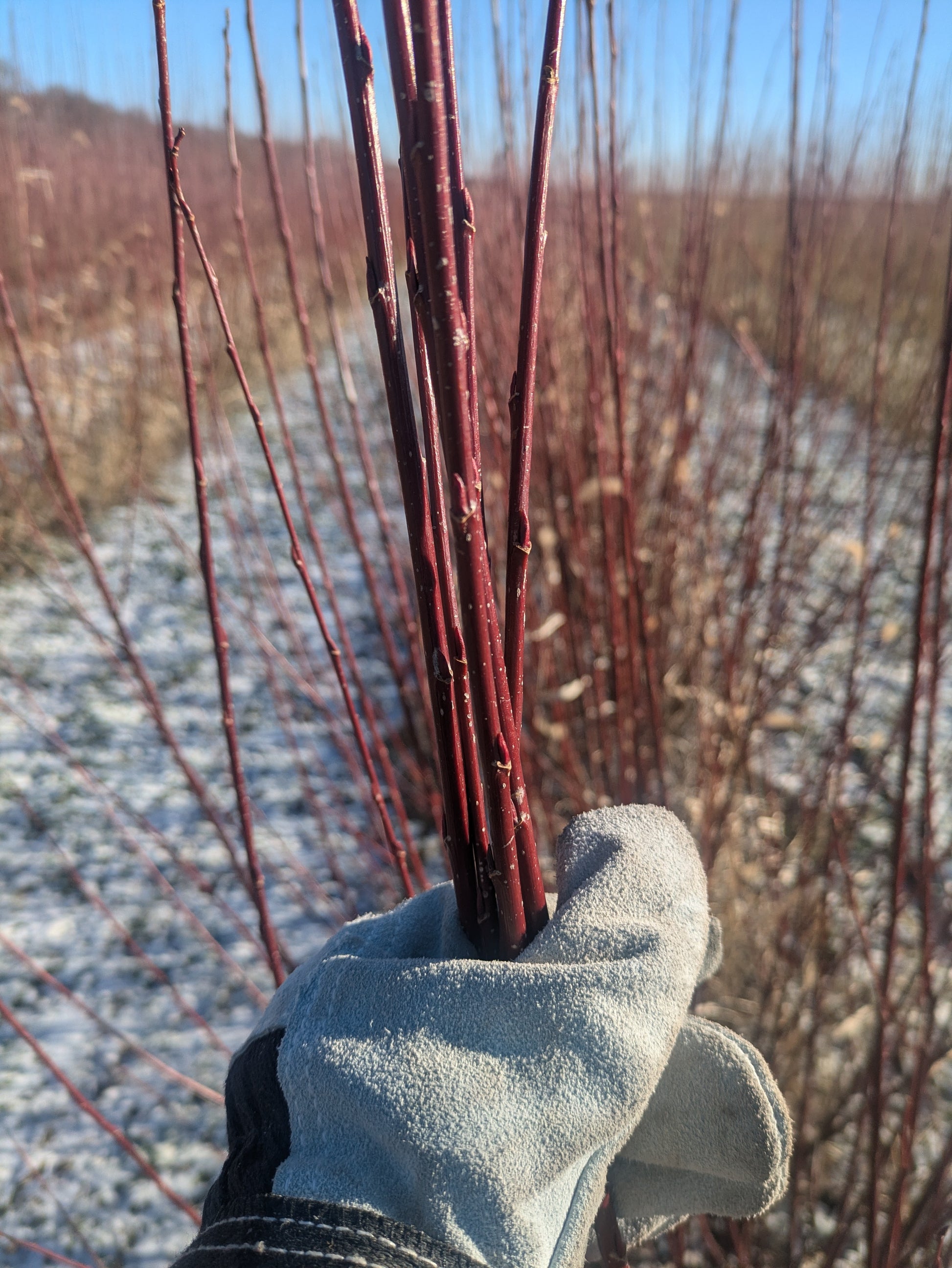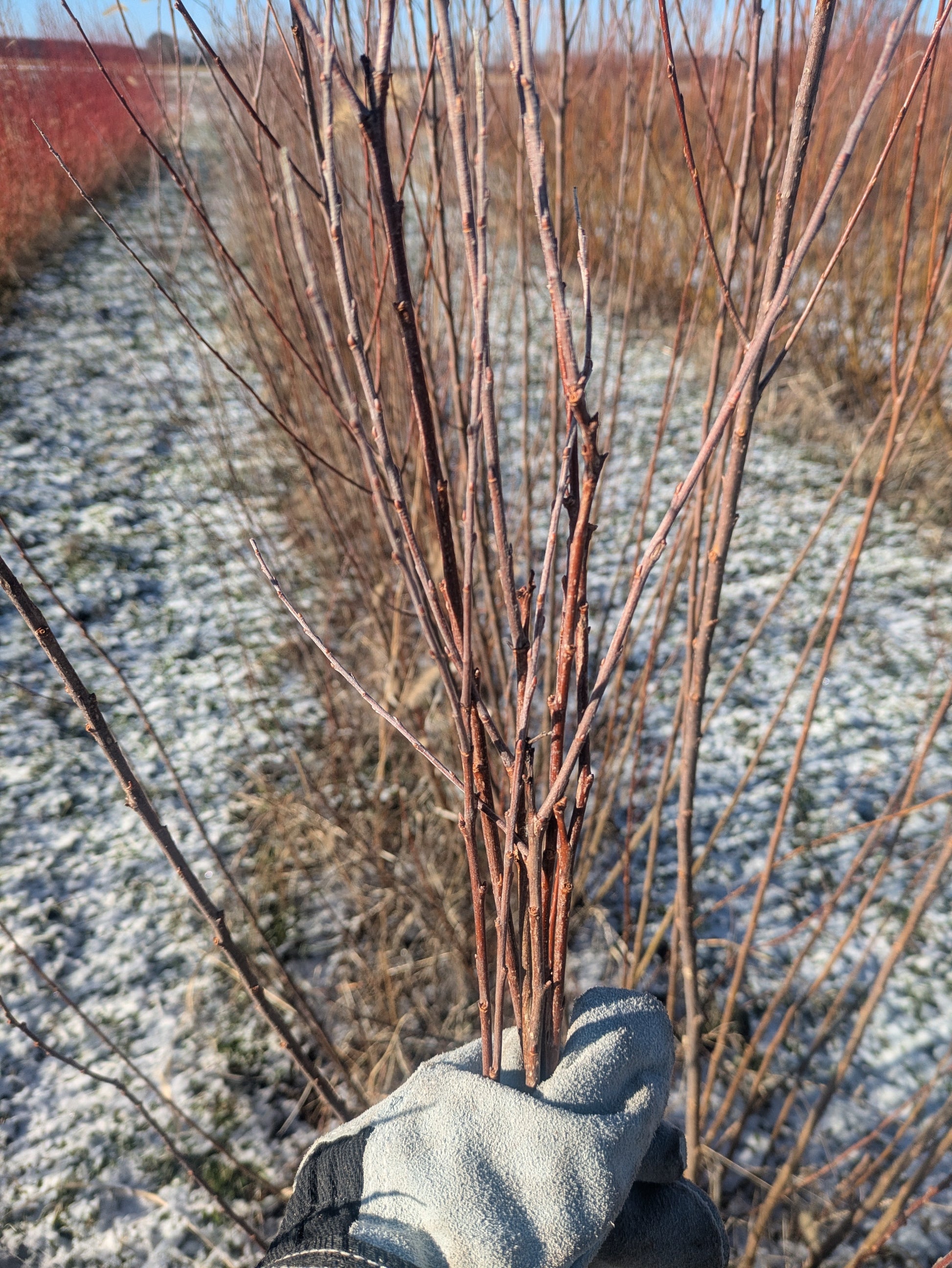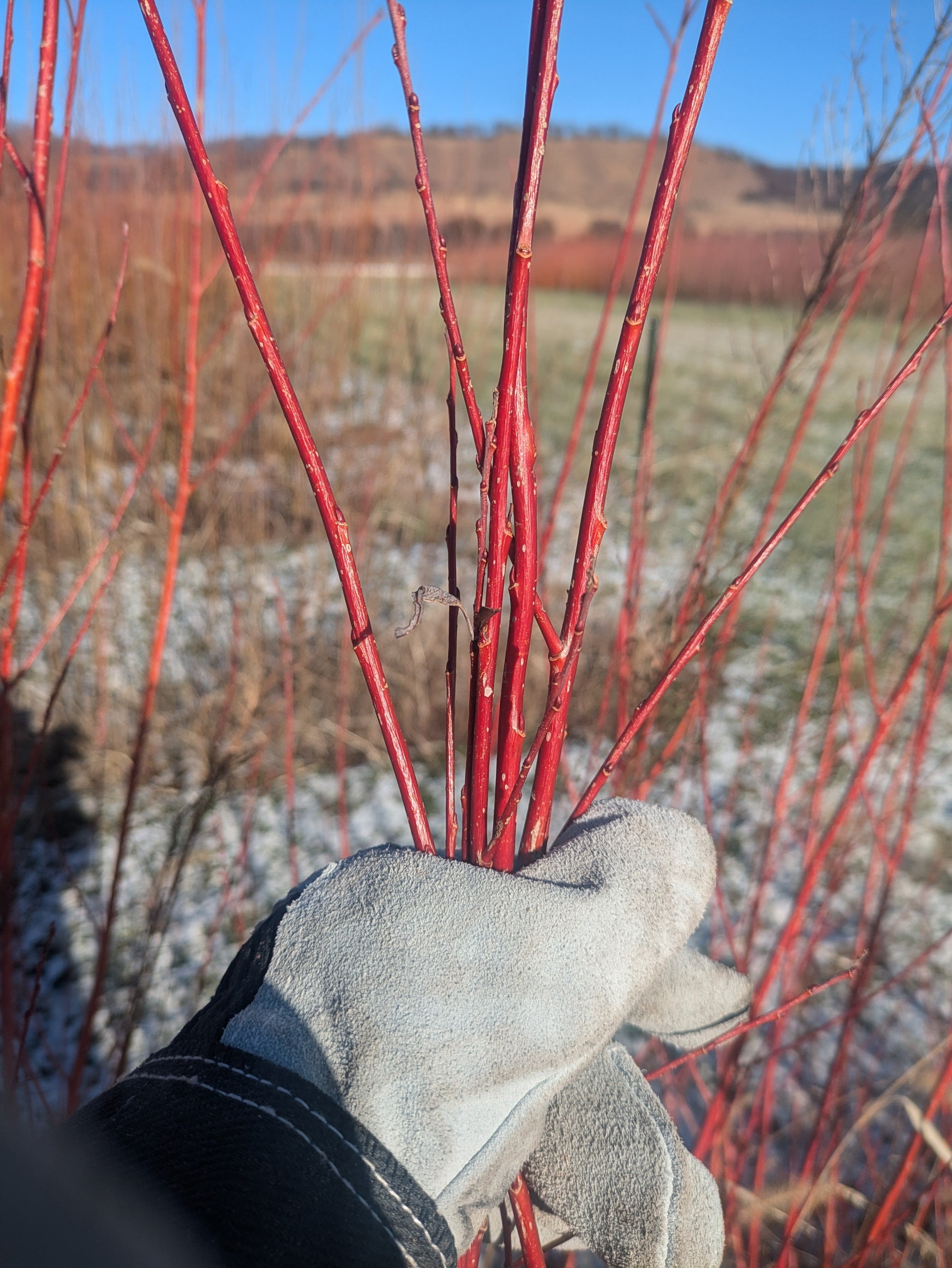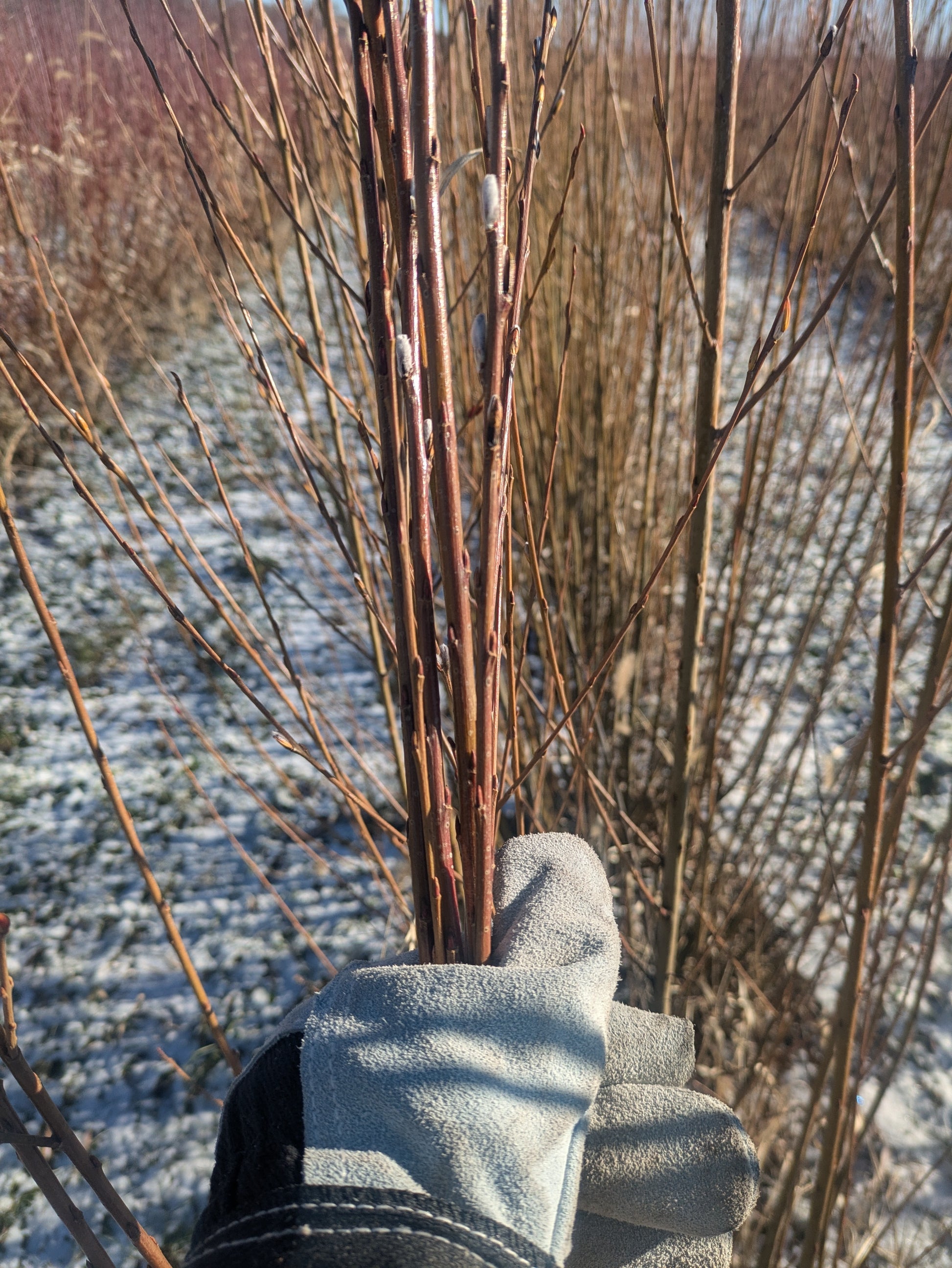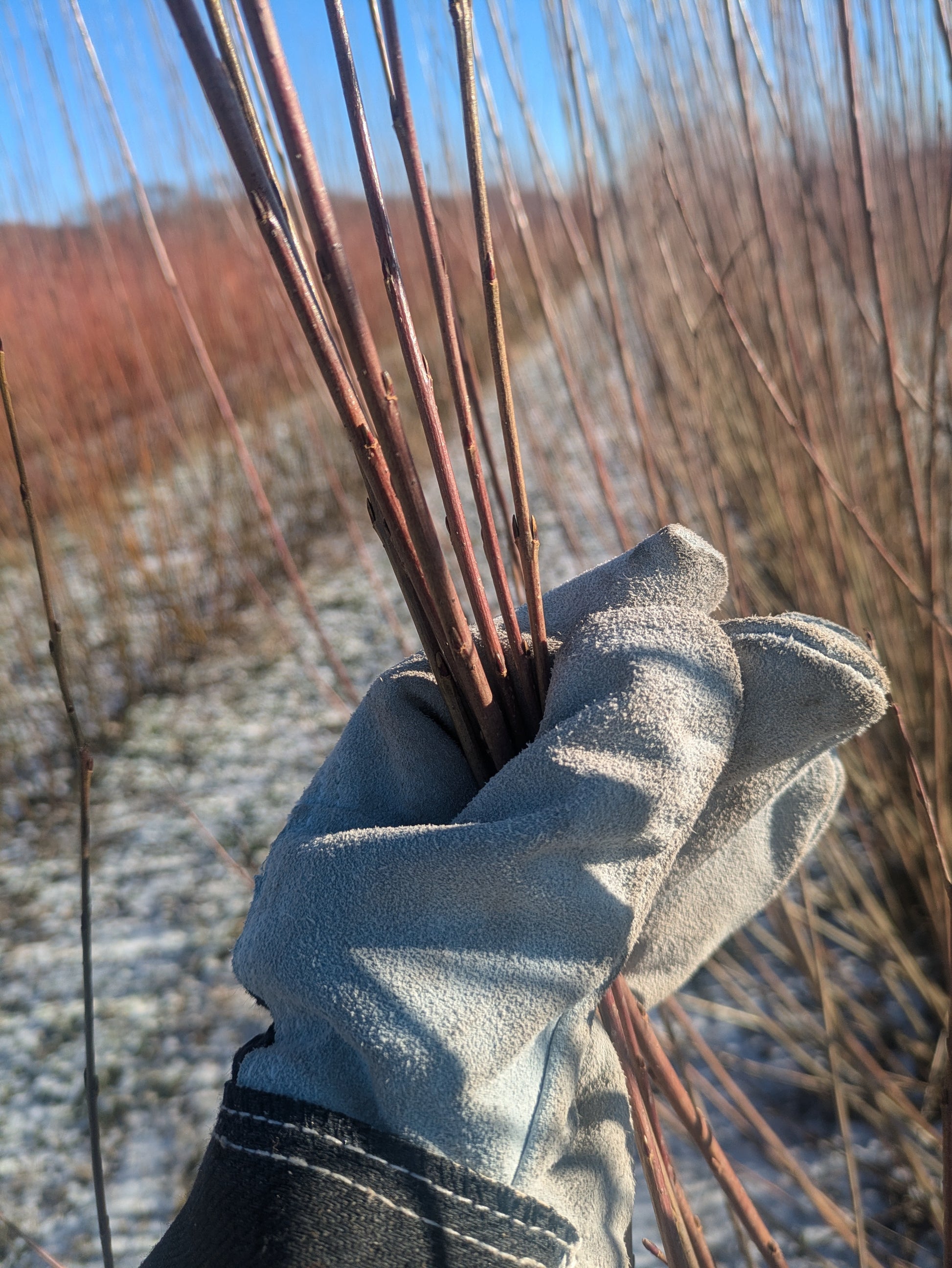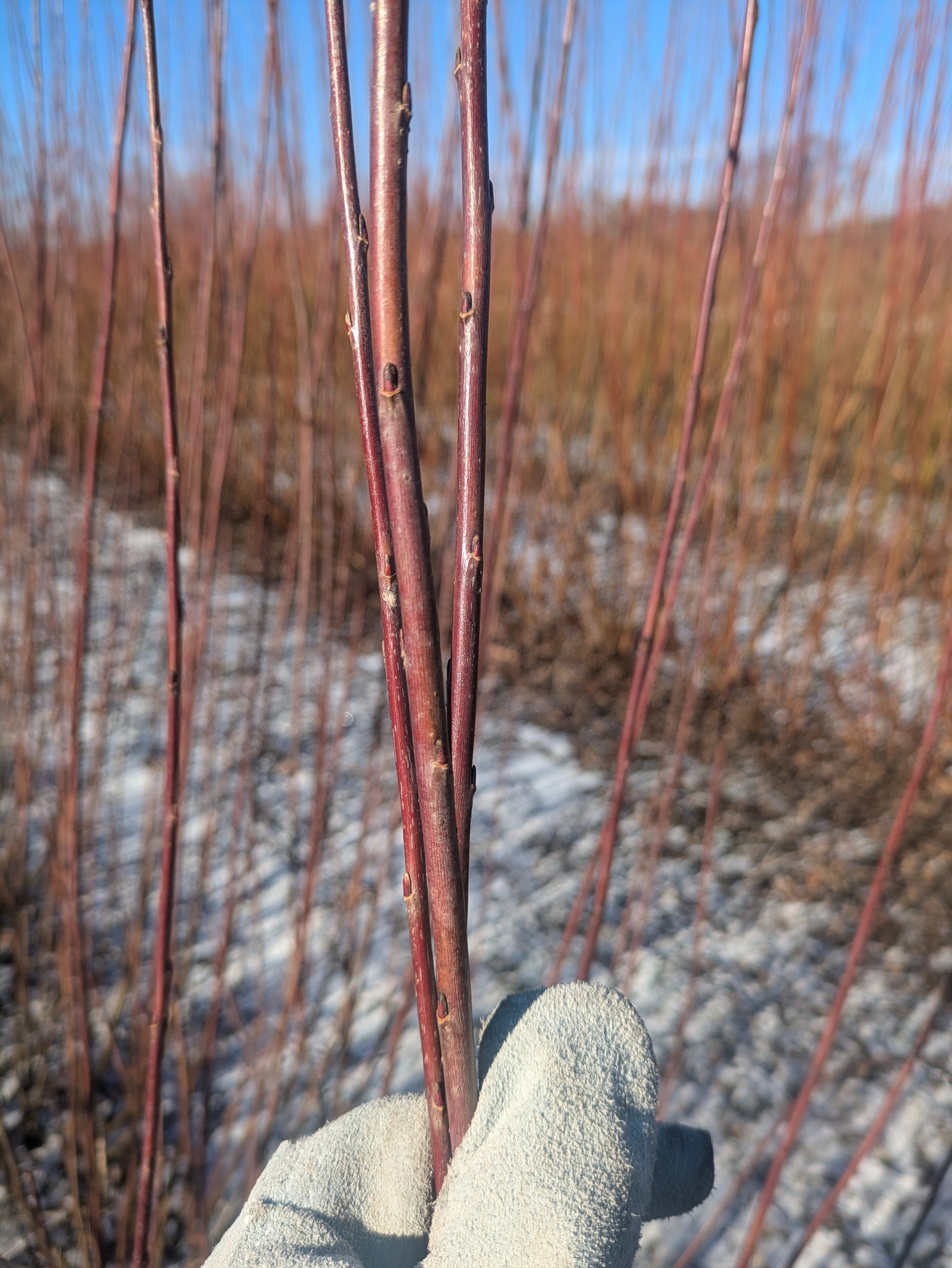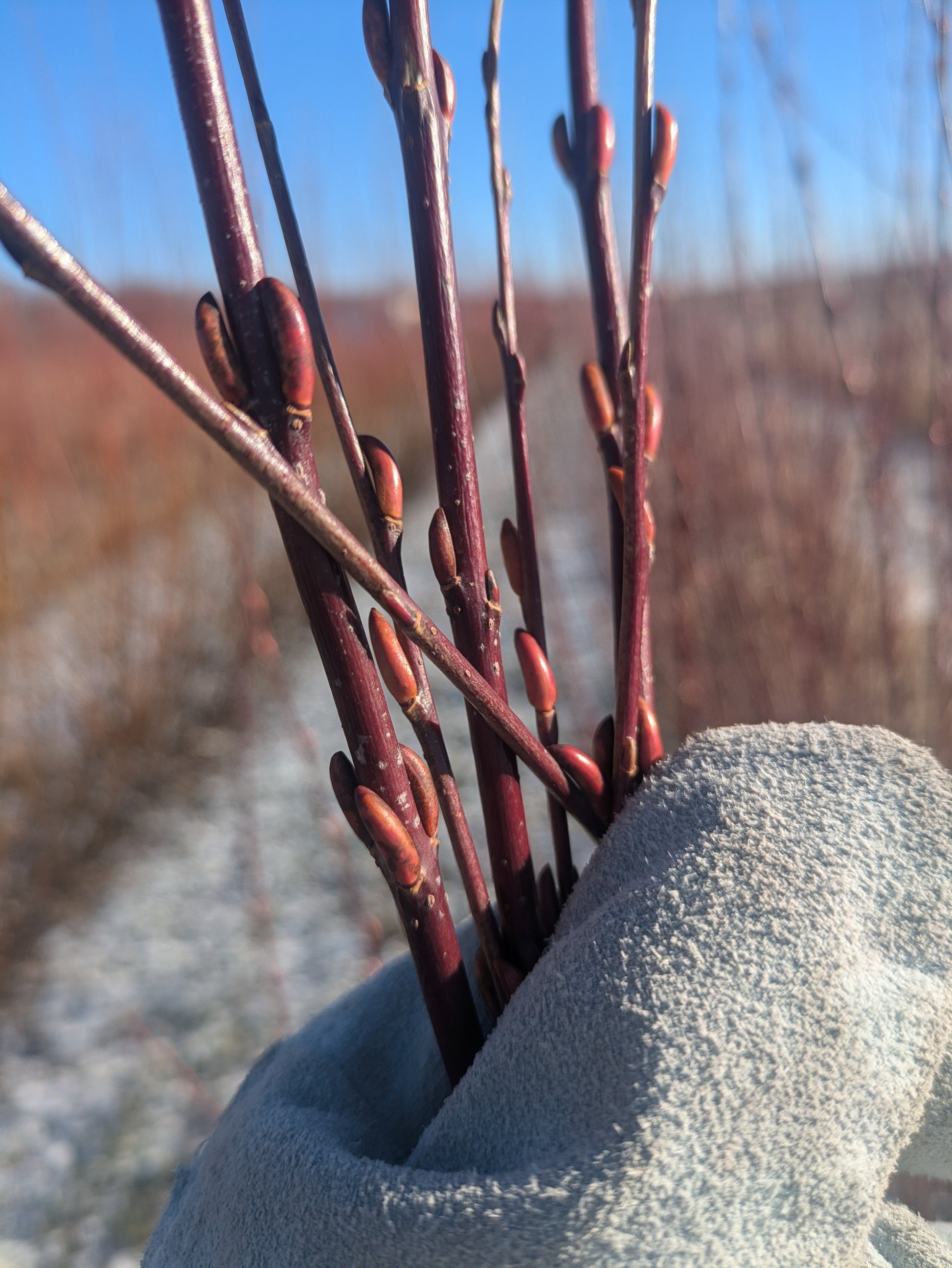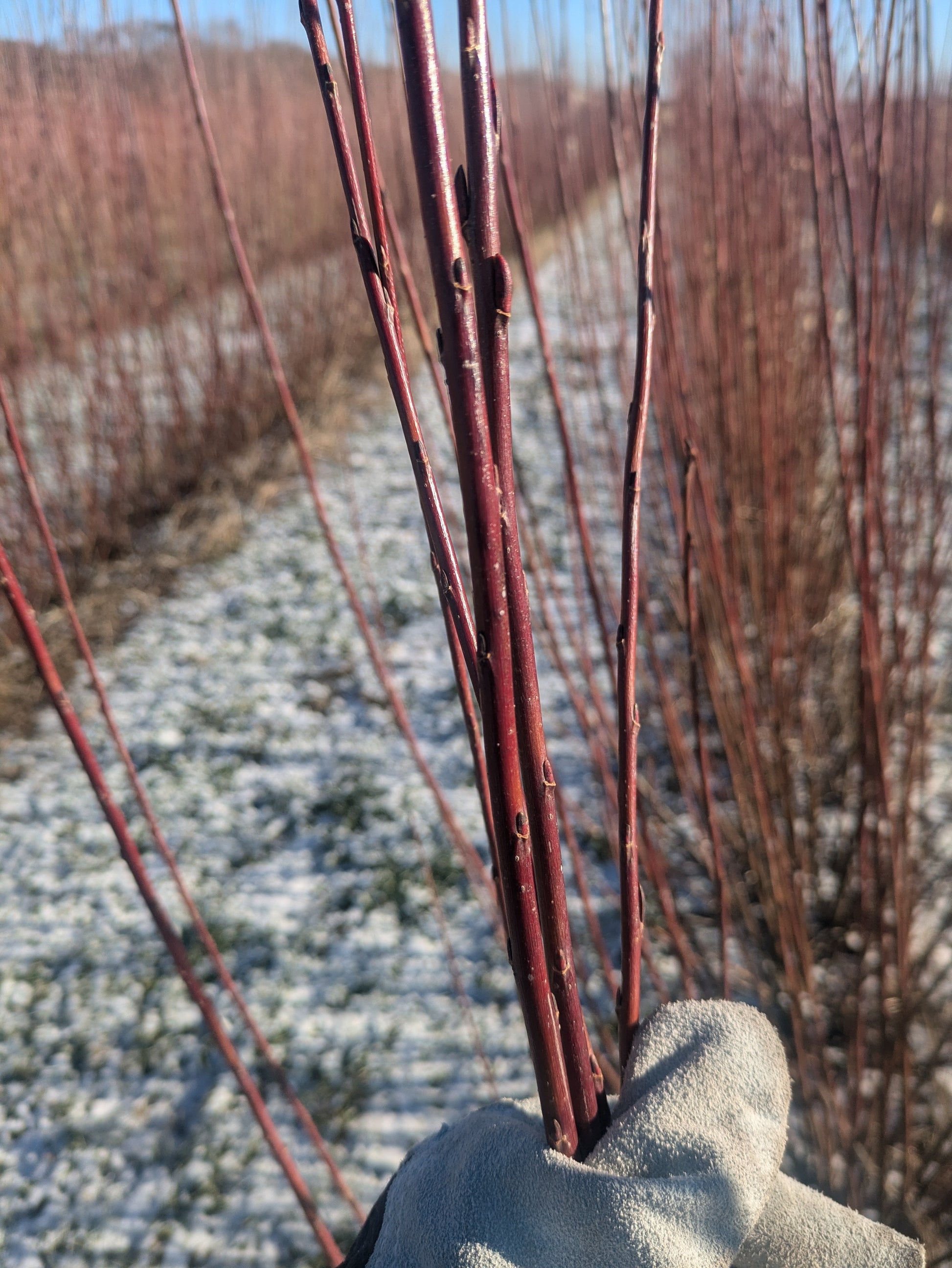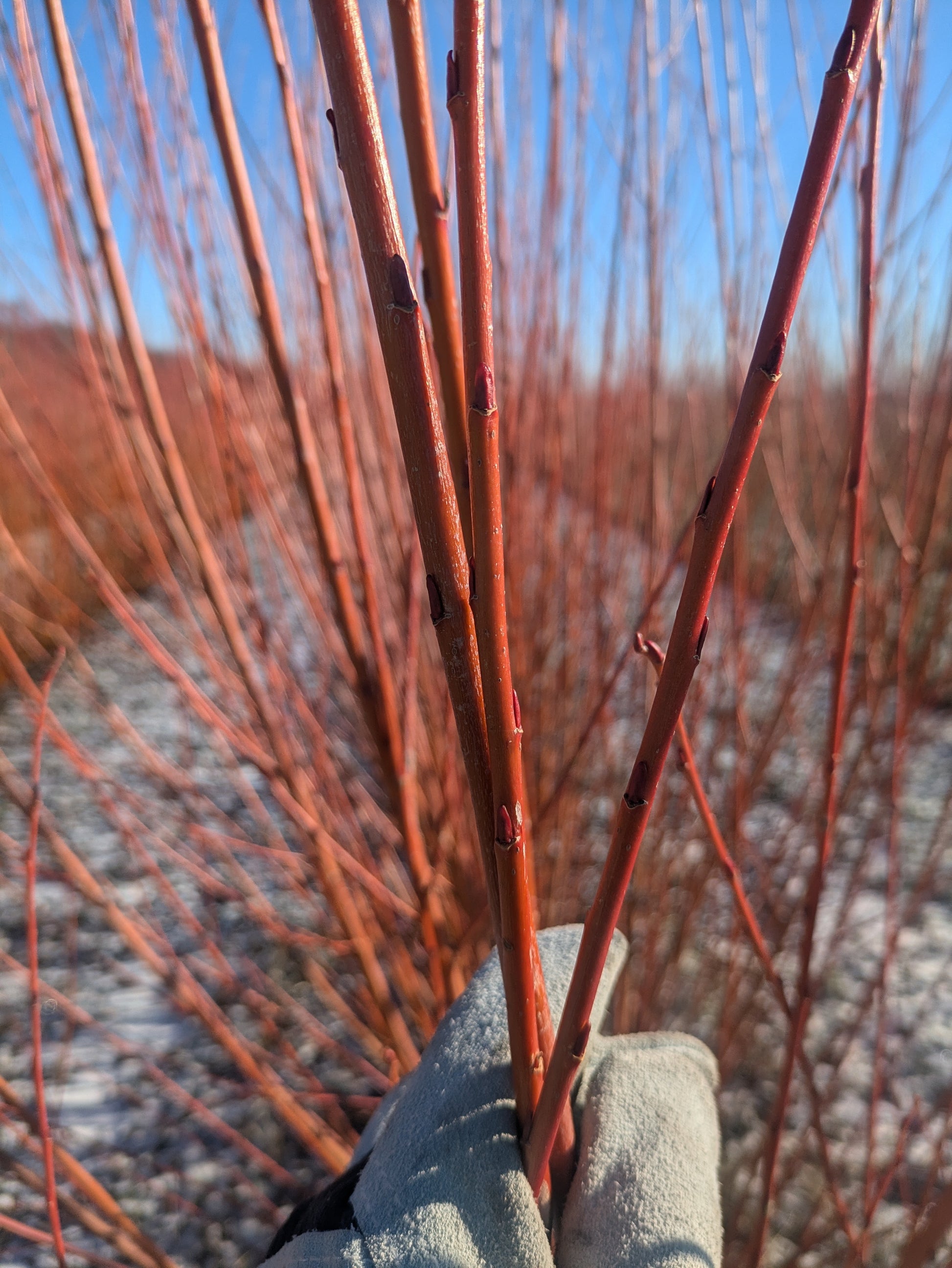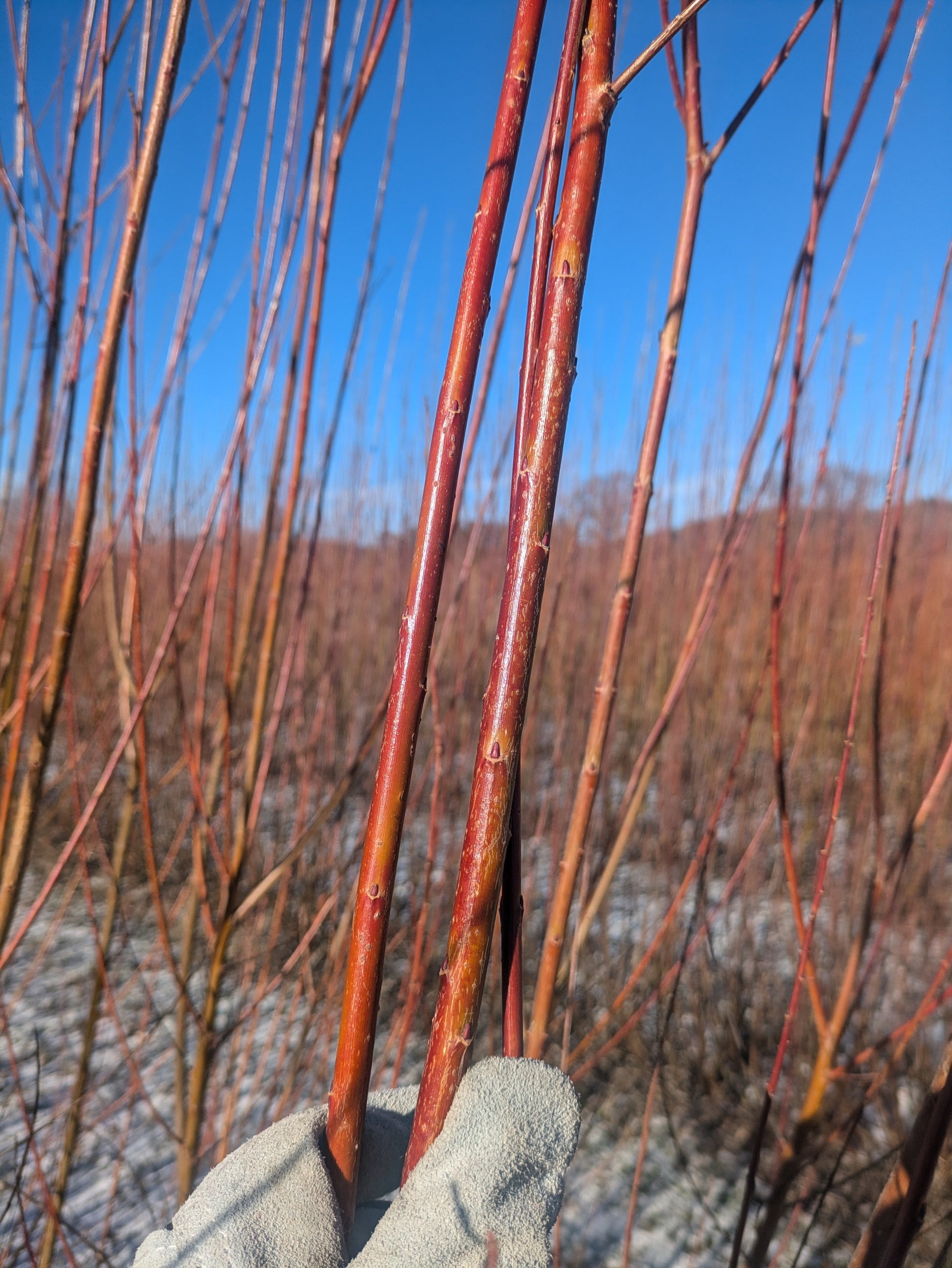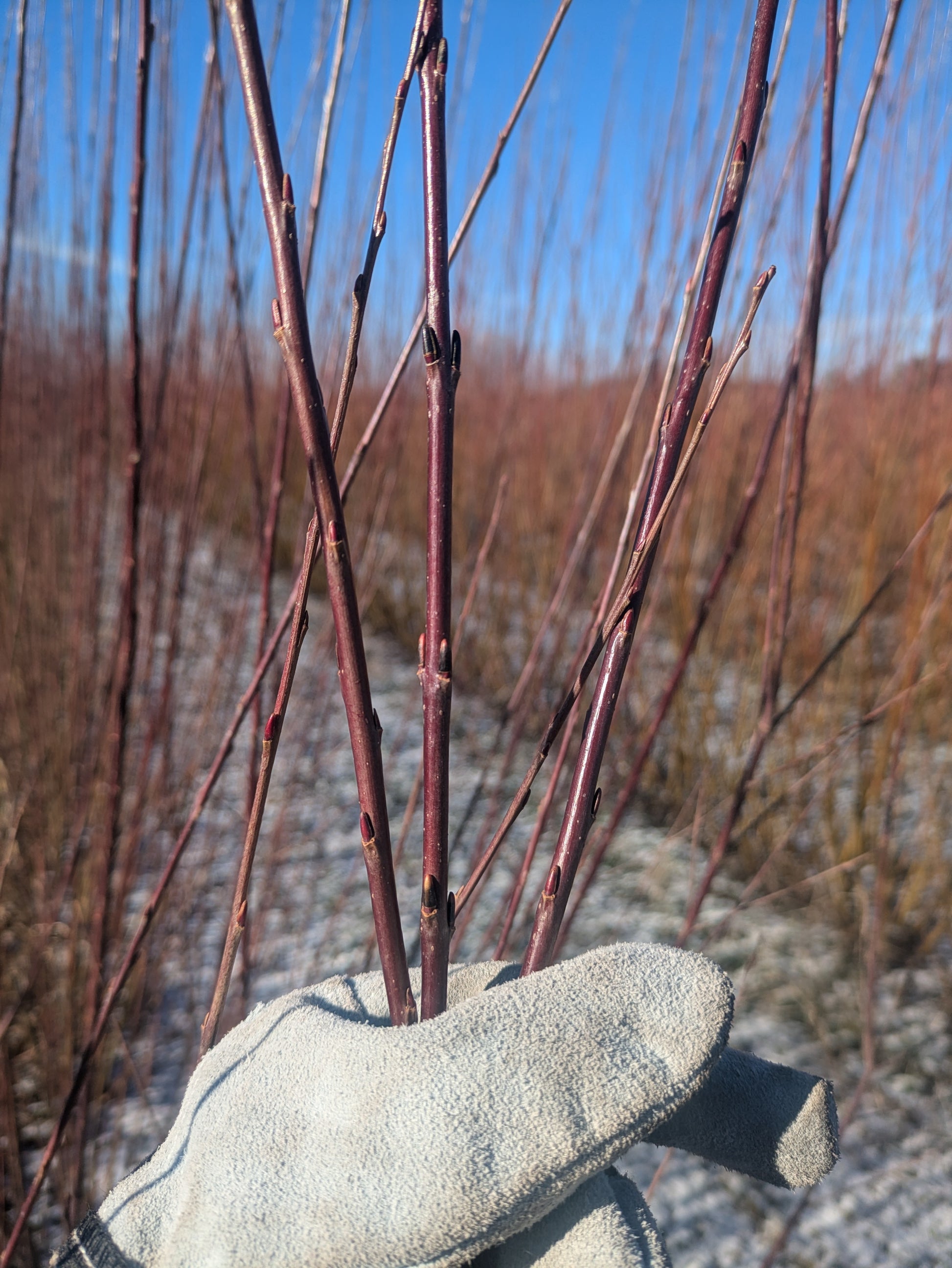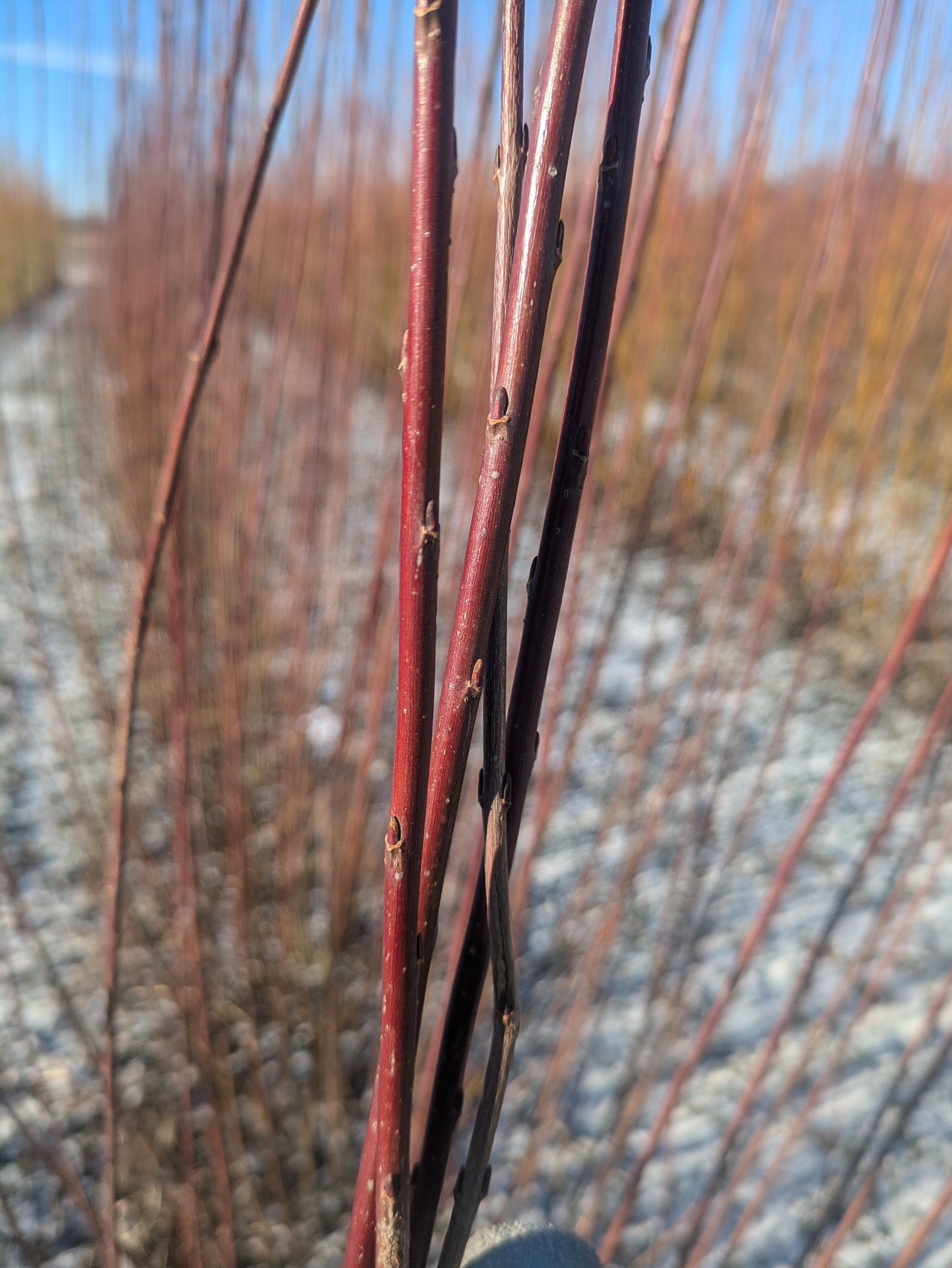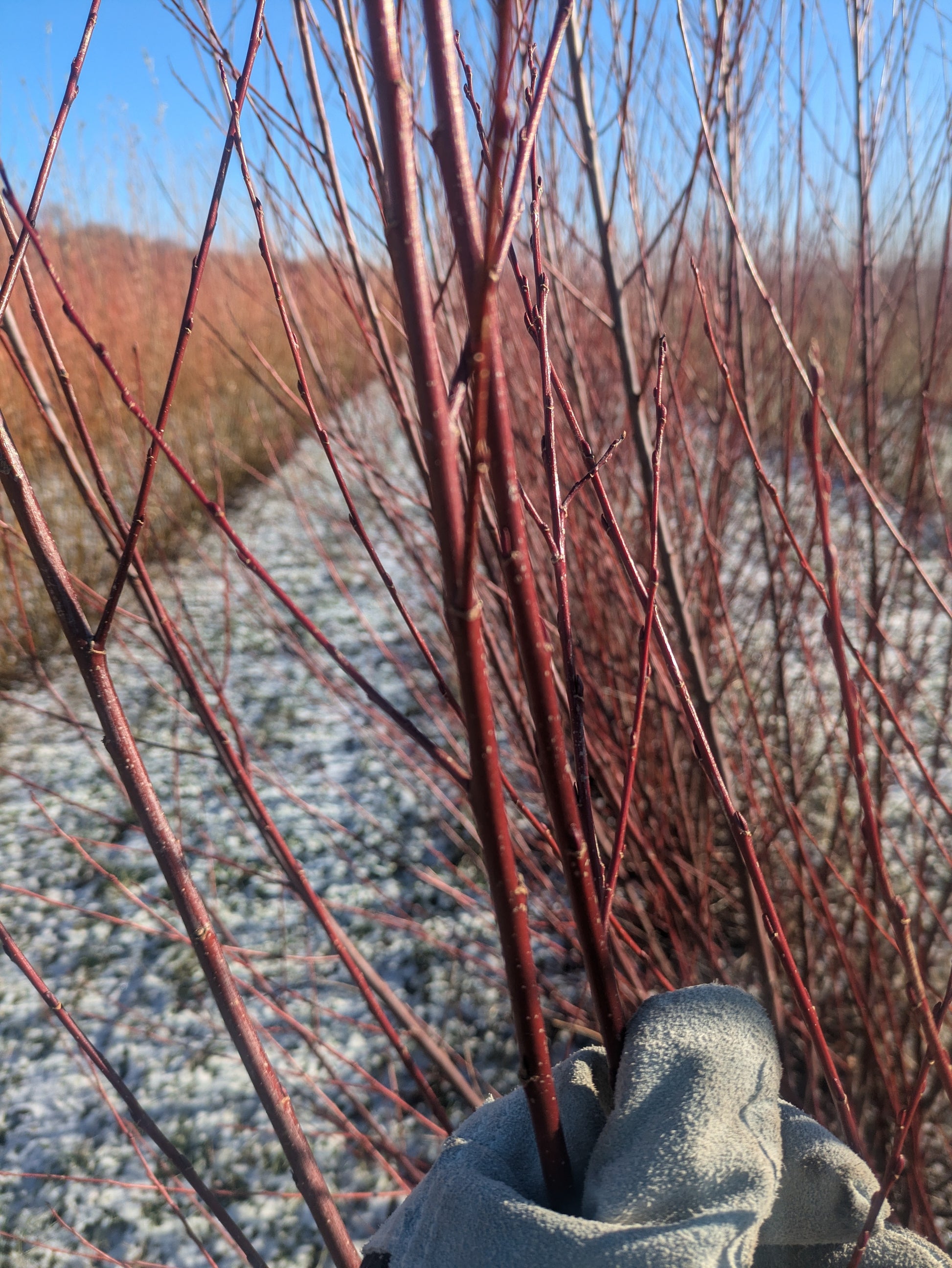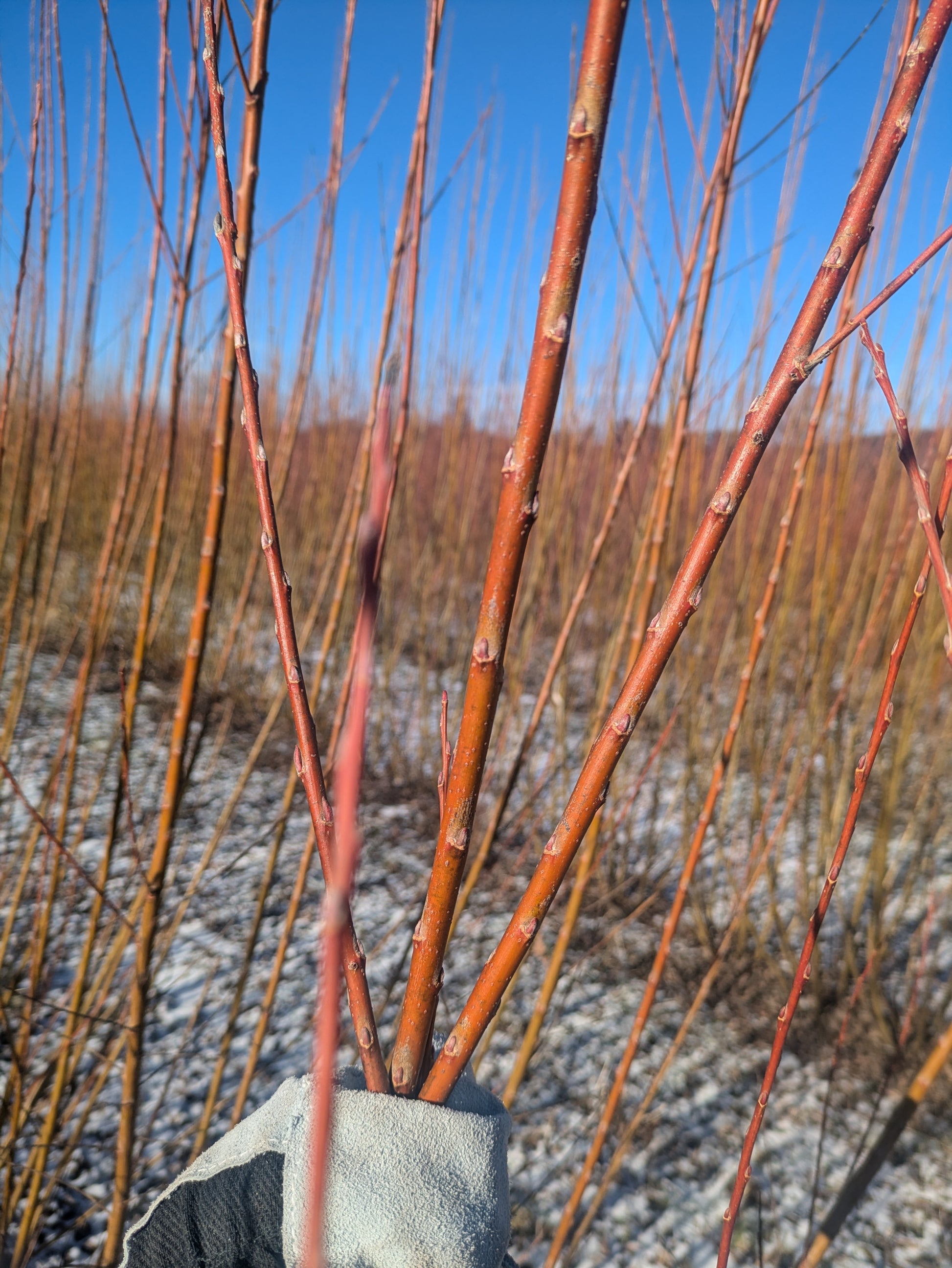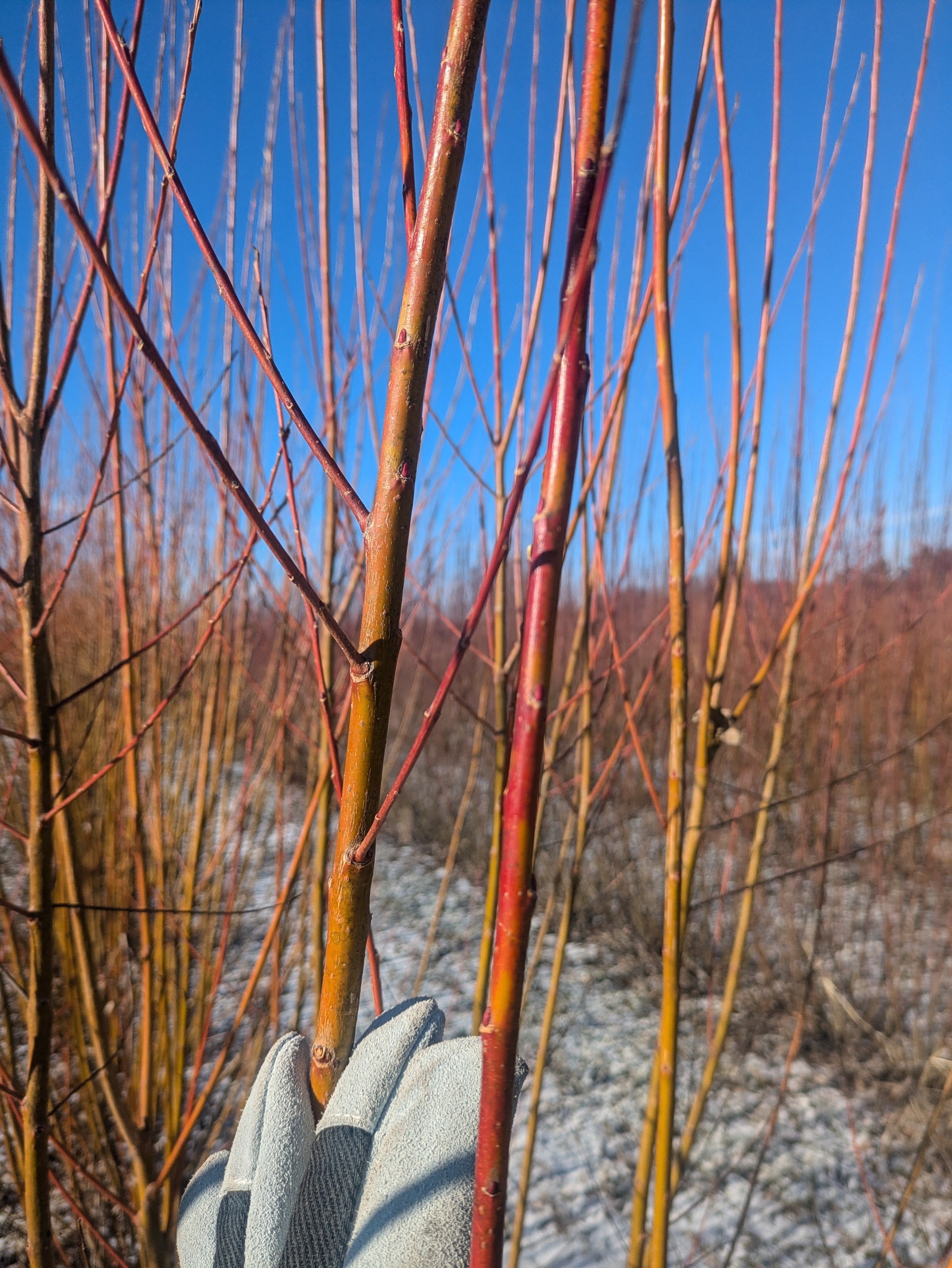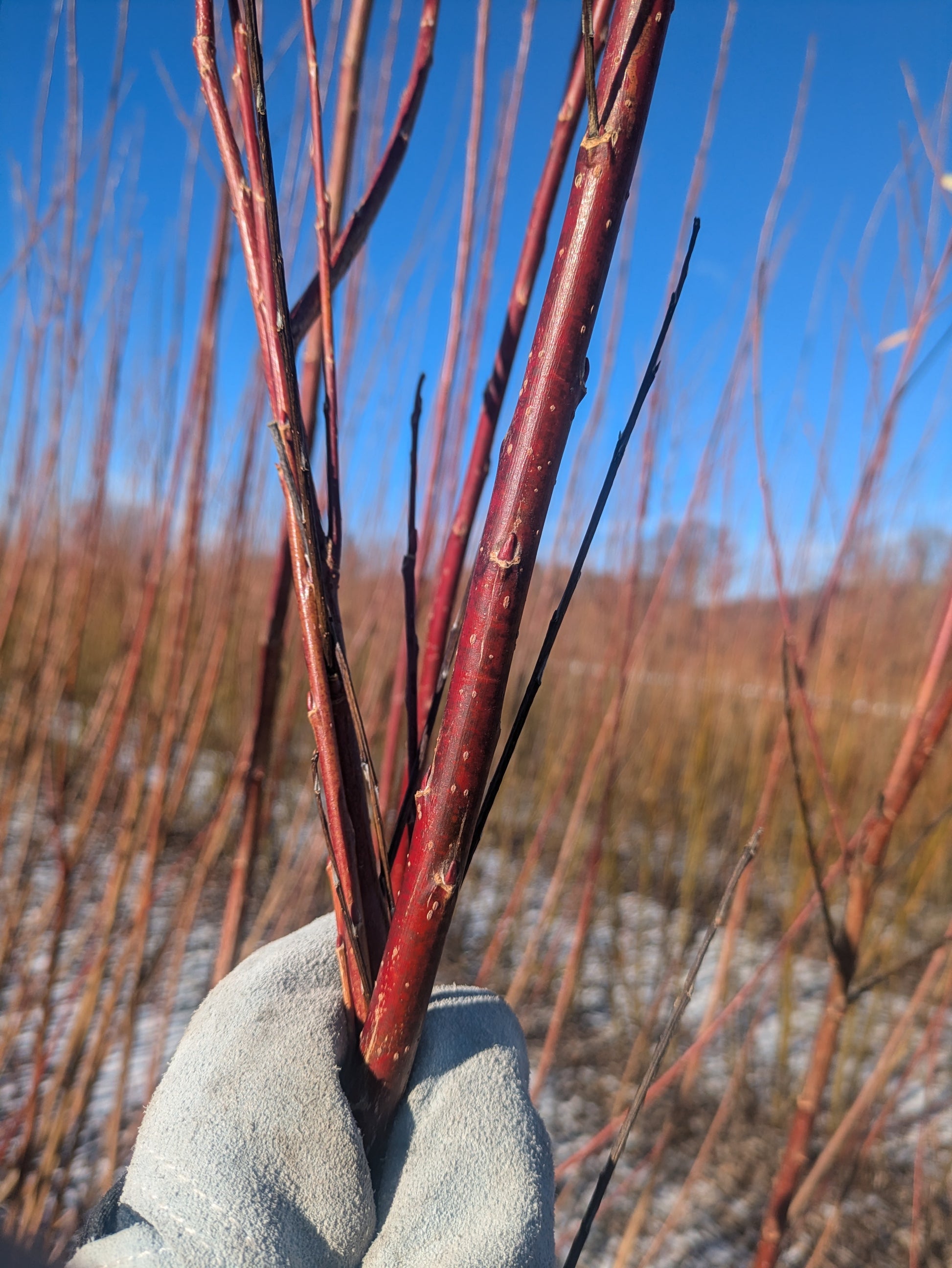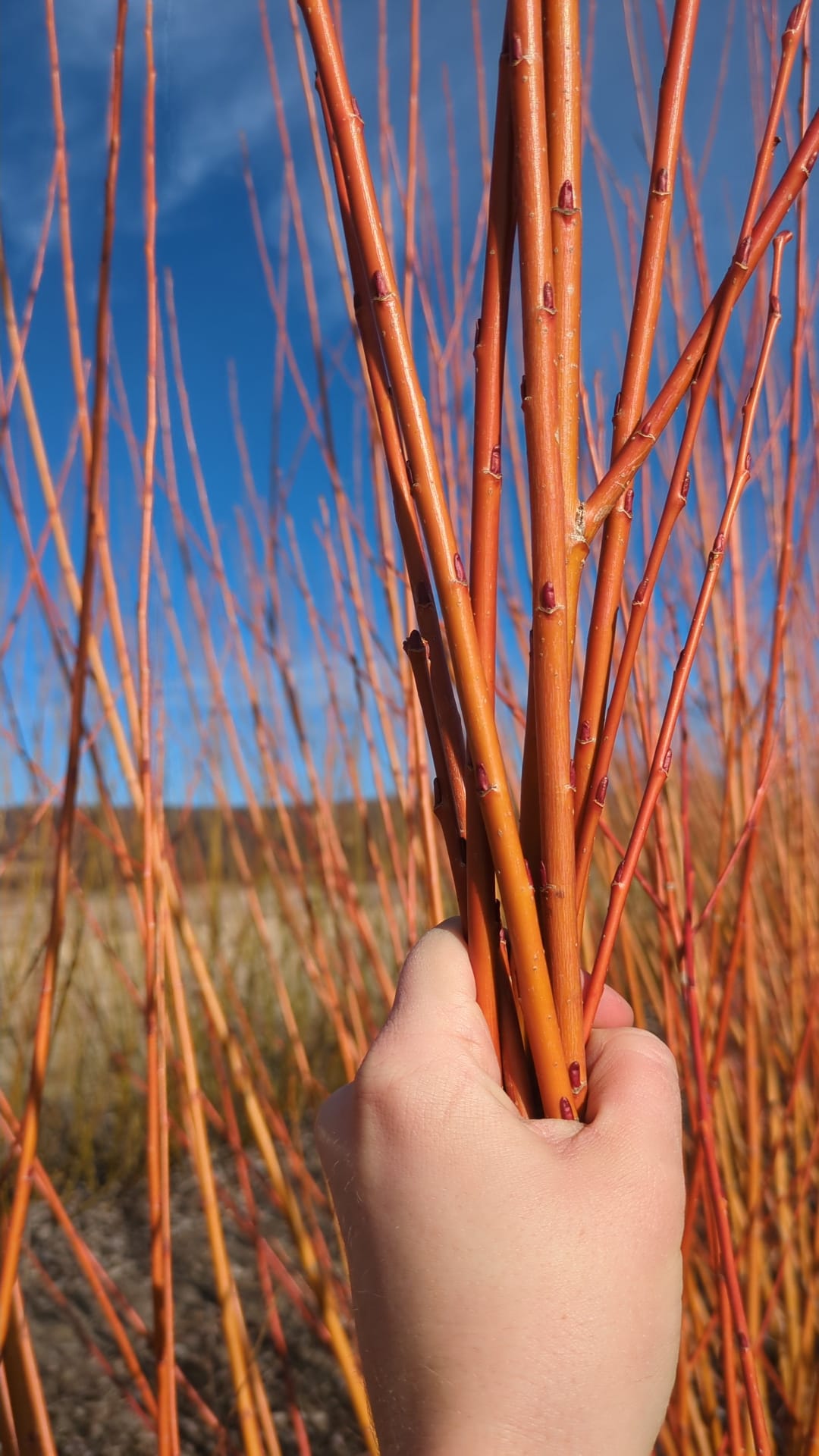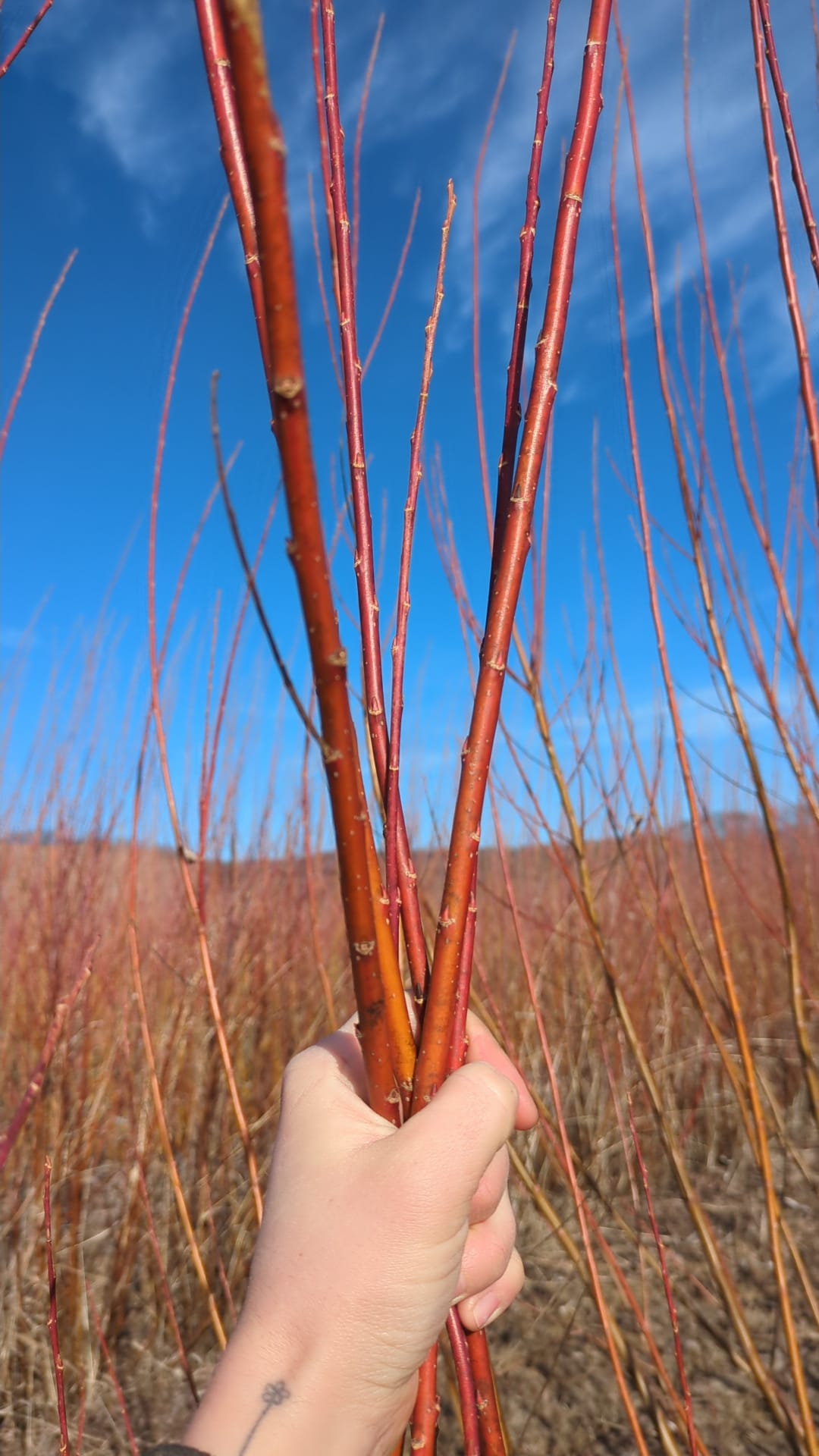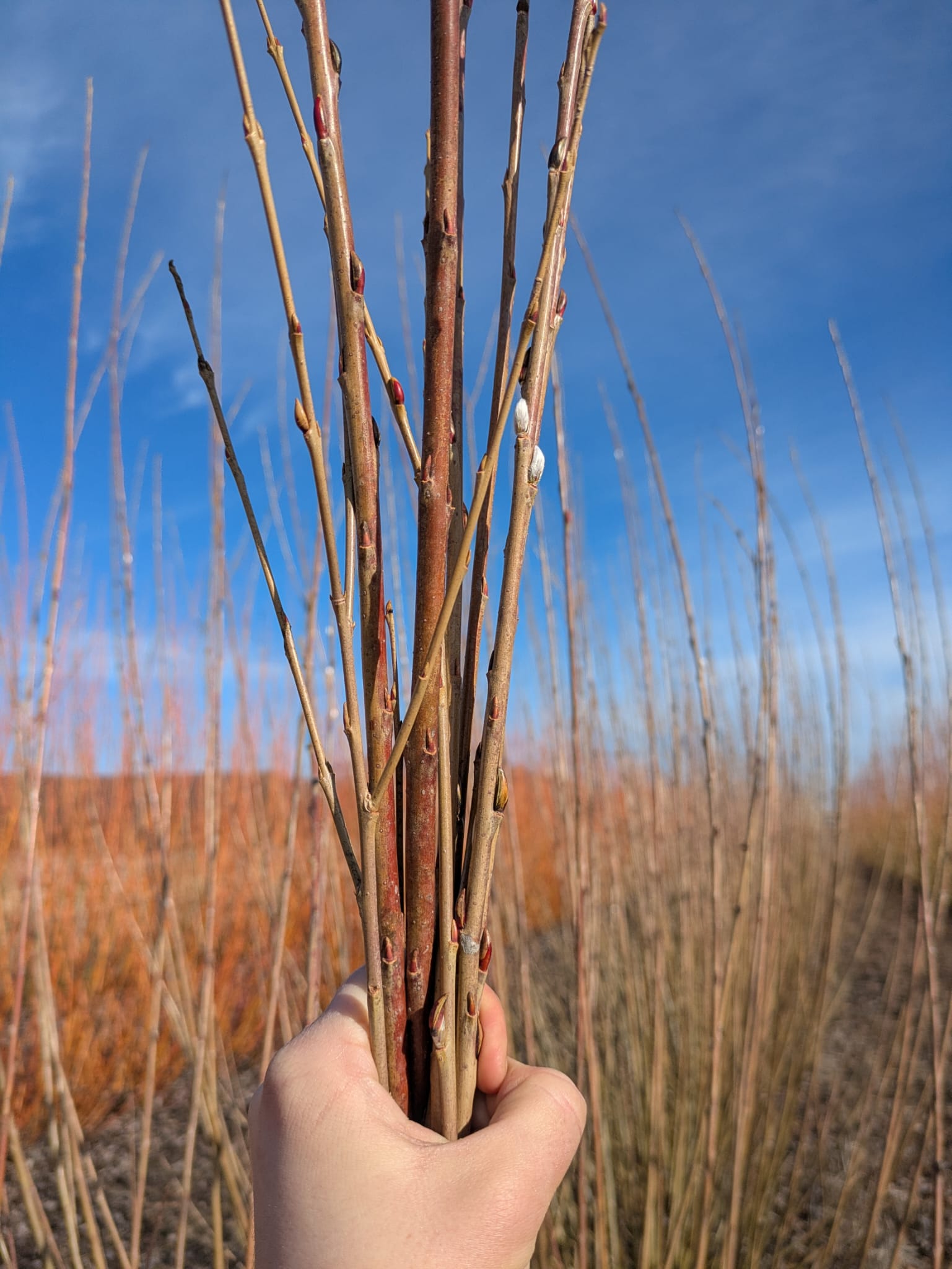Willow Cuttings
Willow Cuttings
500 in stock
Couldn't load pickup availability
Description
Multiple species are available for use in windbreaks and privacy screens, weaving, and biomass. Please see the Species Selections tab to learn more.
Cuttings will be 12-14'' long and are available in multiples of 25 per species.
Items will ship March-May 2025
Will it thrive?
Stop! Before you buy these willow....are you sure they will thrive in your soil and climate? To be sure, you should prepare a Compass Report for your farm at CanopyCompass.com.
Species Selections
Allegany
Latin Name: Salix purpurea
Stem Color: Tan/Green
Special Notes: Most used for living snow fences, riparian buffers, basketry, and streambank restoration. Female. Not known to be pollinated under field conditions. Brown bark when young, turning green and smooth with age; yellow-orange buds in winter.
Belgian Red
Latin Name: Salix alba L. × S. euxina
Stem Color: Burgundy/Olive
Special Notes: Also known as Salix fragilis. Of European origin. Grows into a tree if uncoppiced.
Boonville
Latin Name: Salix viminalis
Stem Color: Grassy Jade Green
Special Notes: A basketry willow, also known as Osier willow
Brittany Green
Latin Name: Salix purpurea 'Brittany Green'
Stem Color: Lemon-lime
Special Notes: Long stems, great for weaving. Generally evenly thick rods. Dries darker red.
Britzensis
Latin Name: Salix fragilis
Stem Color: Yellow/Orange Sunset
Special Notes: Male. It has great winter color. Mature tree height is 80 ft if never coppiced or pruned.
Cardinalis
Latin Name: Salix alba
Stem Color: Golden Orange
Special Notes: Popular for its vibrant red/orange new growth when coppiced. Good for weaving. Female clone.
Dappled Willow
Latin Name: Salix integra
Stem Color: Yellow-green
Special Notes: Smaller ornamental willow with pink buds.
Dark Dicks
Latin Name: Salix purpurea 'Dark Dicks'
Stem Color: Dark Cherry
Special Notes: Female. Used in basketry. Drops its leaves late in the season. Popular in landscaping for living fences. Mature height is likely around 10 ft.
Dicky Meadows
Latin Name: Salix purpurea 'Dicky Meadows'
Stem Color: Pink and Purple
Special Notes: Male. Suitable for weaving and living structures.
Eugenei
Latin Name: Salix purpurea x S. viminalis
Stem Color: Sunny Yellow/Burgundy
Special Notes: Sometimes compared to bamboo with its fine leaves. Good for basketry. Mature height between 13-33 ft.
Fabius
Latin Name: Salix viminalis x S. miyabeana
Stem Color: Green/gold
Special Notes: A popular pick for mechanical harvesting because of its upright form for biomass production. Sterile triploid. Yellow-green when young, turning greyed-green with age; red-orange buds in winter.
Fanny's White
Latin Name: Salix purpurea x S. fragilis decipiens
Stem Color: Green/Beige
Special Notes: Not vigorous when coppiced. Very aggressive otherwise.
Flanders Red
Latin Name: Salix alba vitellina × S. fragilis L. (S. ×sanguinea)
Stem Color: Blood orange/Olive green
Special Notes: Very popular for weaving. Dries to a nice red/orange color. It can get very large and out of control if left uncoppiced.
Fransgeel Rood
Latin Name: Salix alba vitalina x S. fragilis
Stem Color: Sunset Yellow-orange
Special Notes: Male. Good winter color. Good for weaving. Thinner rods somewhat prone to branching.
Goldstones
Latin Name: Salix purpurea 'Goldstones'
Stem Color: Light Yellow-green
Special Notes: Male. Good for weaving. Wards against deer. Fedges. Living structures.
Green Bank
Latin Name: Salix interior
Stem Color: Dusty Purple
Special Notes: Used for streambank and lakeshore restoration. Grows in sandy beaches. Forms thickets.
Green Dicks
Latin Name: Salix purpurea 'Green Dicks'
Stem Color: Dark Rose
Special Notes: Male. Good for weaving.
Harrison's
Latin Name: Salix purpurea x S. rubra
Stem Color: Fiery Orange-red
Special Notes: Thin, unbranched rods great for coarse weaving. Dries copper brown.
Irette
Latin Name: Salix purpurea 'Irette'
Stem Color: Green-gold
Special Notes: Good for basketry, pollinators, and streambank restoration.
Jagiellonka
Latin Name: Salix purpurea "Jagiellonka'
Stem Color: Light Dusty Pink to Olive-green
Special Notes: Long, unbranched stems perfect for weaving.
Lambertiana
Latin Name: Salix purpurea f. lambertiana
Stem Color: Rose/Pink/Tan
Special Notes: Most used for streambank restoration, living willow projects, and basket weaving. Fresh rods are light green. Male.
Leicestershire Dicks
Latin Name: Salix purpurea ‘Leicestershire Dicks
Stem Color: Purple Grapes
Special Notes: Male. Mature height likely around 15ft.
Light Dicks
Latin Name: Salix purpurea 'Light Dicks'
Stem Color: Dusty Pink to Green-gold
Special Notes: Male. Fine weaving. Minimal branching.
Natural Red
Latin Name: Salix fragilis 'Basfordiana'
Stem Color: Rich Gold
Special Notes: Young stems have the most vibrant color. Uncoppiced plants will grow into small branching trees. Also known as Golden or Crack Willow
Oka
Latin Name: Salix purpurea 'Oka'
Stem Color: Golden to Lime-green
Special Notes: Prevalent variety for basketry and living willow structures.
P x D
Latin Name: Salix purpurea x S. discolor
Stem Color: Green-gold to Blood-orange
Special Notes: Potential height is up to 25ft uncoppiced. Female and male.
Polish Purple
Latin Name: Salix purpurea 'Polish Purple'
Stem Color: Olive-gold/Jade-yellow
Special Notes: Good weaving variety.
Preble
Latin Name: Salix viminalis L. 'SV2 x (S. miyabeana Seemn 'Sx61' x S. miyabeana Seeman '9770-037')
Stem Color: Tan-green/Rose
Special Notes: Female. Sterile triploid. Very rapid grower. Likely gets unwieldy if not coppiced regularly. Used in basketry and bioenergy plantings.
Raesfeld
Latin Name: Salix alba 'Raesfeld'
Stem Color: Cherry Red to Mustard-green
Special Notes: Good basketry willow for larger work. Will grow into a 40’ tree if not coppiced.
Rubykins
Latin Name: Salix koriyanagi
Stem Color: Olive-green
Special Notes: Used for structures, weaving, and ornamental dried rods. Female. Bright red catkins appear in early spring. Yellow branches in winter.
S x 61
Latin Name: Salix udensis
Stem Color: Tan-gold
Special Notes: Female. Great for bioenergy plantings, living snow fences, and ornamental plantings.
S x 64
Latin Name: Salix miyabeana
Stem Color: Burgundy wine
Special Notes: Good for biomass planting and hedgerows/privacy fences. The three-year-old stem is green with slightly cracking bark and raised lenticels.
S x 67
Latin Name: Salix miyabeana
Stem Color: Mustard-yellow/Rust
Special Notes: Very upright growth. Good for privacy fences and biomass. Male. Viable pollen in early spring. The three-year-old stem is green with slightly cracking bark and red lenticels.
Truxton
Latin Name: Salix viminalis x S. miyabeana
Stem Color: Gold
Special Notes: Bred for biomass production.
Planting Information
Willow Cutting Planting Guide
1. Introduction
- This guide serves as a simple introduction to growing and caring for willow cuttings. Willow is a flexible and fast-growing plant, commonly used for various purposes including basketry, living structures, and privacy screens. We recommend doing additional research on specific willow varieties before planting.
2. Selecting and Preparing Willow Cuttings
- Arrival Care:
- If not planting immediately, store your cuttings in a cool, dark place, wrapped airtight. A refrigerator is the best place. Willow cuttings can be stored for several weeks in the coldest part of the refrigerator if stored longer than a few days.
- Before planting, soak cuttings in 2-3 inches of water for at least 24 hours. Be sure to minimize handling to avoid damaging the cuttings.
- Pre-Rooting:
- This step is not required but can result in a higher success rate though unrooted willow will generally fare well if watered properly.
- Soak the bottom two-thirds of the cuttings in water for up to two weeks until roots form.
- Change the water regularly.
3. Preparing the Planting Site
- Site Location:
- Willows thrive in sunny, open areas, but can tolerate partial shade. They prefer moist, well-drained, loamy soil, though they will grow in most soil types, including clay. Avoid planting near structures or underground pipes, as willow roots aggressively seek water and can cause damage. Plant willows at least 1.5 times their mature height away from buildings or septic systems.
- Ground Preparation:
- Clear the planting area of weeds and grass. Cultivate the soil to a depth of about 30 cm and consider adding organic matter, compost, or well-rotted manure to enhance moisture retention. Mulch or a weed-suppressing membrane will help control weeds and keep the soil cool and moist.
4. Planting the Willow Cuttings
- When to Plant:
- Willow cuttings can be planted between December and May, depending on the location. However, for best results, plant in early spring as soon as the ground thaws.
-
Planting Instructions:
- Insert cuttings directly into the ground. Use a pointed tool to create holes for planting. Plant as deep as possible, leaving 1-2 buds exposed above the ground, and firm the soil around the cuttings to eliminate air po
ckets.

- It is critical to avoid planting the cutting upside down. Willow buds
- are triangle-shaped, with the point facing up. The
cuttings should be planted with the bud pointing up. See the photo for reference. - Spacing:
- For basket willow, dense planting at 10-12 inches apart produces slender rods. For general willow planting where they will be regularly coppiced, spacing 12-36 inches between plants is recommended. Plant 5-10 feet apart for windbreaks or privacy screens, with double or triple rows providing quicker density.
5. Care and Maintenance
- Watering:
- Willow requires consistent moisture, especially during the first year. Water regularly until the cuttings establish strong roots. Mulch helps retain moisture and suppress weeds. Frequent watering is necessary in drought conditions, especially for newly planted cuttings.
- Weed Control:
- Keep the base of the cuttings weed-free to ensure they have room to grow. Mulch or black plastic can be used for weed suppression.
- Some hand weeding may be required even with a physical barrier such as mulch.
- Pruning and Harvesting:
- Willows should be pruned during the dormant season (December to February). Cutting back annually encourages dense, vigorous growth and promotes straighter rods for weaving or construction projects. For basketry, allow cut willow whips to dry for several weeks before use.
- If you're cultivating for winter color, prune yearly in the late winter or early spring, as the best stem color appears on one-year-old growth.
- Fertilization:
- Willows generally do not need fertilization, but if soil quality is poor, sparing compost or organic fertilizer applications can be beneficial. Avoid chemical fertilizers, which can cause root burn if they are too potent and applied too liberally.
We recognize these factors may be overwhelming, but we are here to offer support and assistance on your tree-planting journey! Please schedule a call if any of these instructions need clarification or if you have any questions or concerns.
